Can a Catamaran Capsize? The Surprising Answer
Capsizing often happens with small boats like canoes, kayaks, and sailboats. But even for bigger boats like catamarans, which have an established reputation for stability and safety, it's still normal to wonder if they can capsize too. To give you peace of mind and prepare you for the worst, let's answer that question in this article.
A catamaran can capsize under extreme conditions, just like any other boat. Even the most stable catamaran can capsize if it's hit by a large wave, caught in a sudden gust of wind, or if the rotational force has overcome the stability of the boat. However, it's not something that happens frequently.
It can be a scary experience if a catamaran capsized, but you have to stay calm and know that most modern catamarans are designed to self-right. This means that they can turn themselves back over after capsizing. Let's continue reading to know what else can we do to recover from a catamaran capsize.
- A catamaran's stability is attributed to its center of gravity, its freeboard, and its pendulum-like behavior. However, despite its stability and speed, a catamaran can still capsize due to strong winds and capsizing waves.
- There are factors that can contribute to the likelihood of a capsize happening, such as wind speed, wave height, weather conditions, breaking waves, and the overall sailing conditions.
- The best thing to do to quickly recover from a capsize is to stay calm and position the boat to make it self-right quickly.
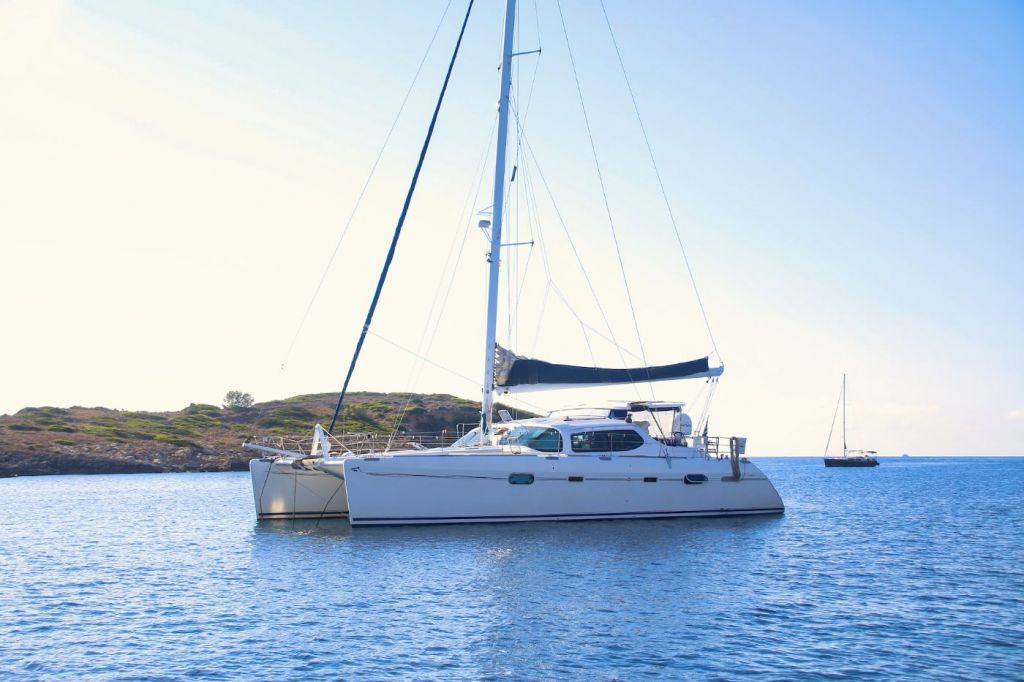

On this page:
A catamaran can capsize despite its stability, factors influencing catamaran capsizing, safety measures to prevent capsizing, recovering from a capsized catamaran.
A catamaran can capsize. However, it's not very common, and most catamarans are designed to be stable and safe in a variety of conditions.
Despite their stability and speed, catamarans can still capsize under certain conditions. Strong winds, large waves, and imbalance can all cause a catamaran to capsize. When a catamaran is caught in a gust of wind, the increased wind pressure on one side of the catamaran can cause it to lean to one side, which can lead to a capsize if not corrected.
Any boat can technically capsize , but there are specific factors that can contribute to a catamaran capsizing. One of the main reasons for catamaran capsizing is the effect of rotational forces. When these forces overcome the stability of the boat, it can lead to capsizing.
A catamaran is a type of multihull boat that has two parallel hulls connected by a deck or bridge. They are well known for their stability and speed, making them a popular choice for sailors and boaters.
One of the key advantages of their twin hulls is that it gives them a larger base and makes them less likely to tip over . It also helps to distribute the weight of the boat more evenly, providing greater stability. This is especially helpful in rough seas , where the catamaran's stability can help keep you safe and comfortable. Below are factors that contribute to the stability of catamarans:
Their center of gravity makes them stable
In a catamaran, the center of gravity is typically lower than in a monohull, which helps reduce the likelihood of capsizing. This is because the lower the center of gravity, the more stable the boat will be.
The freeboard also adds up to their stability
Their freeboard of a catamaran is typically lower than a monohull's, which helps to reduce the windage and the chances of the boat being pushed over by strong winds.
Their pendulum-like behavior helps them to be stabilized
When they encounter waves, the two hulls move independently of each other, which helps to reduce the rolling motion of the boat. This is because the weight of the boat is distributed between the two hulls, which act like pendulums, swinging in opposite directions to counterbalance the motion of the waves.
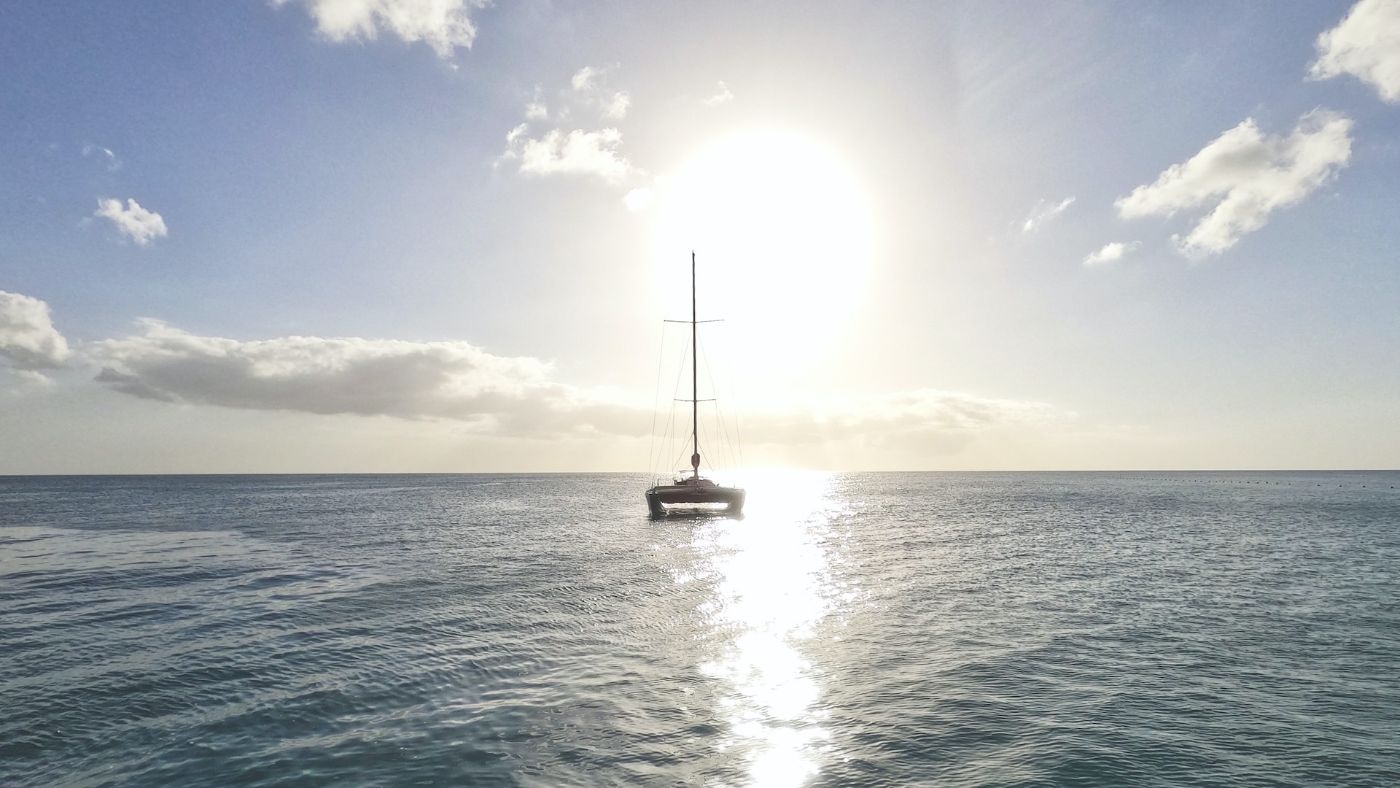
Aside from stability, another advantage of a catamaran is its speed. Because they have two hulls, they create less drag than a single hull and can move through the water more quickly and efficiently. This can be especially useful if you're trying to get somewhere quickly or if you're racing.
The height of the wave can affect the chance of capsizing
Wave height is a significant factor when it comes to catamaran capsizing. The higher the waves, the greater the risk of capsizing. This is because the waves can exert a significant amount of force on the boat, causing it to tip over.
Wave capsize occurs when a boat overtakes a wave and sinks its bow into the next one, causing it to capsize. However, this is also not very common and can usually be avoided by keeping an eye on the waves and adjusting your speed and course accordingly.
Wind speed is another important factor to consider
The stronger the wind, the more likely it is that a catamaran will capsize. The wind can create a lot of pressure on the sails, which can cause the boat to lean to one side and potentially capsize. To know more about the ideal wind speed in sailing, read this article.
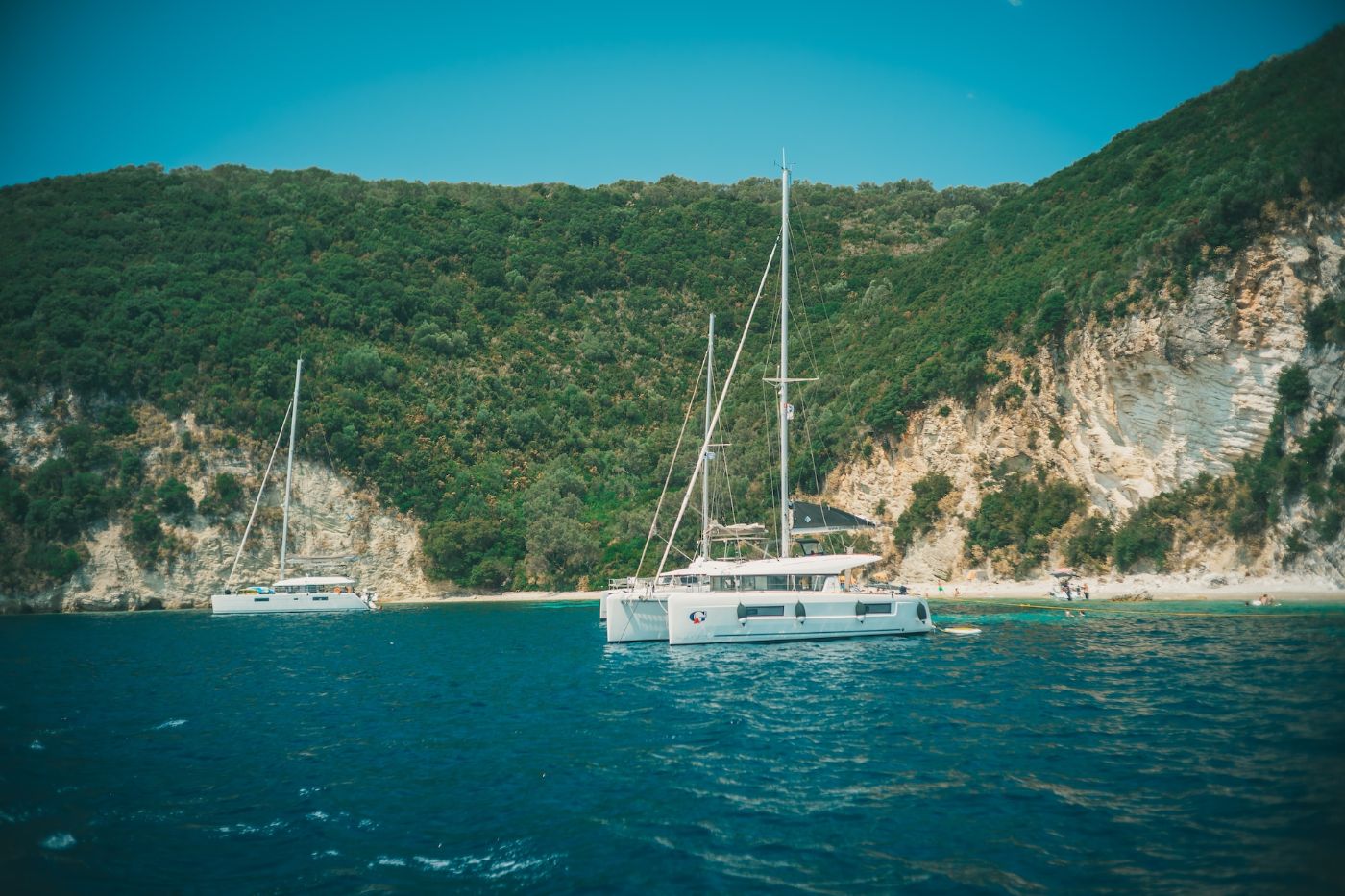
Weather conditions can also play a role in catamaran capsizing
If there is a storm or other severe weather conditions, the risk of capsizing is much higher. Perhaps consider checking the weather forecast before setting out on a catamaran to ensure that conditions are safe. You may also try reading this article on the possible danger of sailing through thunderstorms.
Breaking waves can cause a catamaran to capsize
When waves break, they release a significant amount of energy, which can cause the boat to capsize. Try to keep an eye out for breaking waves and avoid them if possible.
The overall sailing condition can increase the likelihood of capsizing
You may need to be aware of the conditions and take appropriate precautions to ensure that you stay safe while on the water.
1. Ensure proper weight distribution
To prevent capsizing, you could check if the weight on your catamaran is evenly distributed, with heavier items stored low and towards the center of the boat. Try to avoid overloading your catamaran with too much weight.
2. Learn the right way of reefing
Reefing is the process of reducing the size of your sails to adjust to changing wind conditions. When the wind starts to pick up, you will need to reef your sails to prevent your catamaran from heeling over too much. You must learn how to reef your sails properly before you set out on your journey.
3. Know how to properly anchor and use the right anchor
An anchor can help keep your catamaran in place and prevent it from drifting in strong currents or winds. You need to know how to properly anchor your catamaran and always use an anchor that is appropriate for the size of your boat. Learn different anchoring techniques in tough conditions through this article: Boat Anchoring Techniques Explained (Illustrated Guide)
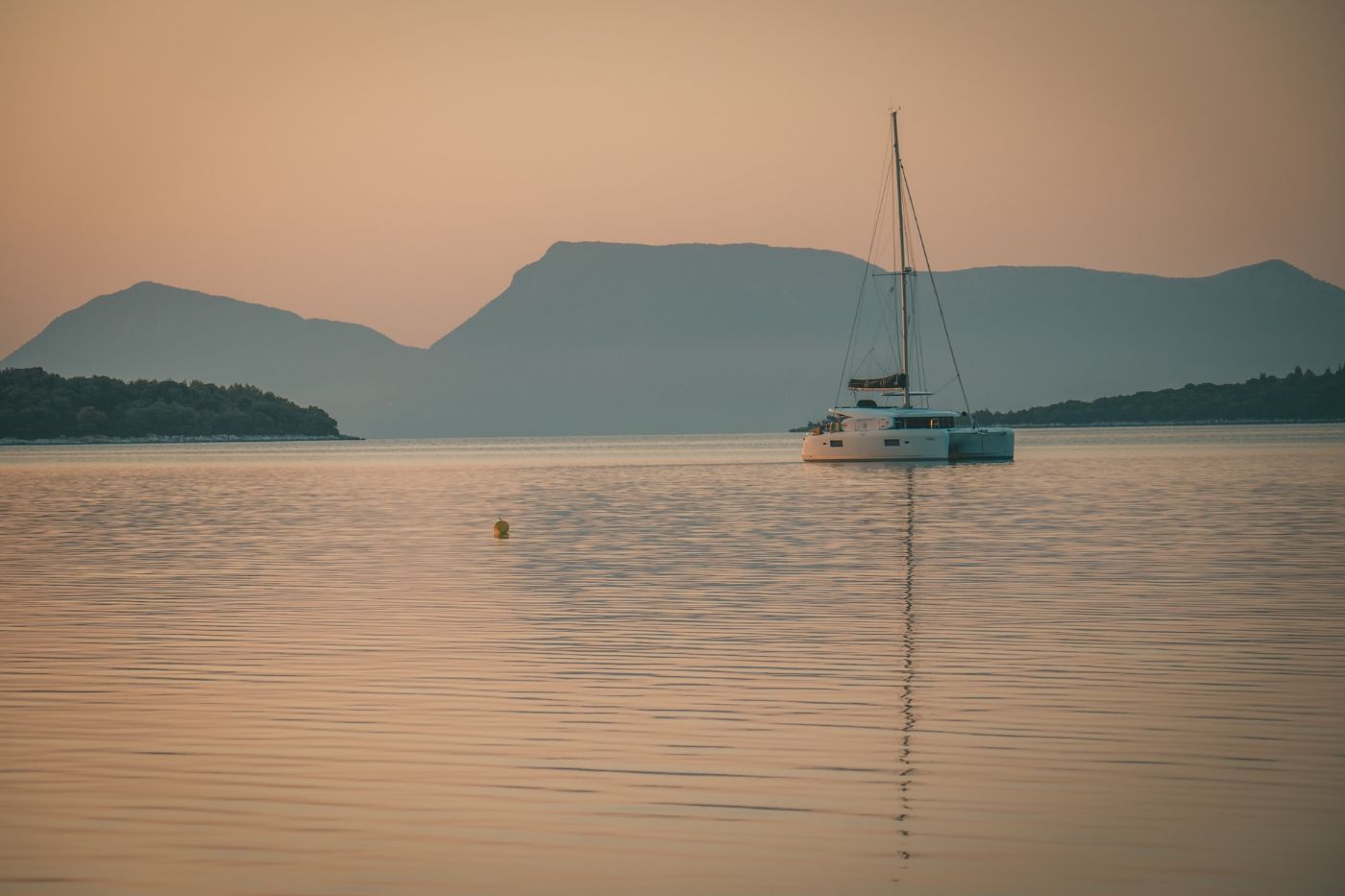
4. Utilize your catamaran's engine
Your engine can be a valuable tool for preventing capsizing. If you find yourself in a dangerous situation, such as strong winds or currents, you can use your engine to help keep your catamaran stable and prevent it from capsizing.
5. Use your boat tools to prevent it from capsizing
Keels, daggerboards, and centerboards all help stabilize your catamaran and prevent capsizing. You may need to check if these are properly installed and maintained.
6. Use the drogue to slow down the boat
A drogue is a device that can help slow down your catamaran and prevent it from capsizing in heavy seas. You can check if you have a drogue on board and learn how to properly use it in case you need to.
7. Make sure to have safety equipment onboard
Always make sure you have the proper safety equipment on board, including life jackets, flares, and a first aid kit. Everyone on board must also know where the safety equipment is located and how to use it.
8. Use an autopilot
Autopilot can help keep your catamaran stable and prevent it from heeling over too much. Consider learning how to properly use your autopilot before you set out on your journey.
Capsizing a catamaran can be a scary experience, but with proper preparation and practice, you can easily handle it. When the boat flips upside down, all the loose gear in the boat floats away (or sinks), and you are left with a capsized boat. Here are some steps that can help you recover from a catamaran capsize:
The first thing to do when your catamaran capsizes is to remain calm. Take a deep breath and assess the situation. Check if everyone on board is safe and accounted for.
Position the catamaran to self-right
Catamarans are designed to self-right, which means that they can turn themselves back over after capsizing. To self-right, the boat needs to be positioned in a certain way, usually with the mast pointing downwind.
Help the catamaran to self-right using the righting lines
If your catamaran doesn't self-right, you can help it by using the righting lines. These lines are attached to the bottom of the hulls, and they can be used to pull the boat back upright.
The buoyancy of the catamaran can help you recover
Catamarans are designed to be buoyant , which means that they can float even when they are upside down. This makes it easier to recover from a capsize.
Be prepared
The best way to prepare for a capsize is to practice recovering from one. Set aside some time to practice capsizing your catamaran in a controlled environment, like a calm lake. This will help you build confidence and prepare you for the real thing.
Leave a comment
You may also like, catamaran vs monohull in rough seas: which is better.
Catamarans and monohulls have different designs that affect how they handle rough sea conditions. In fact, they have an advantage over each other when sailing in …
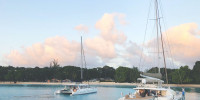
Are Catamarans Safer than Monohulls? - Not Always
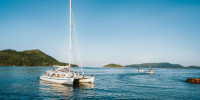
The Perfect Size Catamaran to Sail Around the World
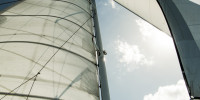
What is the Ideal Wind Speed for Sailing?

The Illustrated Guide To Boat Hull Types (11 Examples)
Yachting World
- Digital Edition

Catamaran Sailing Techniques Part 7: should the worst happen – with Nigel Irens
- Belinda Bird
- October 1, 2015
Capsize is very unlikely in most modern catamarans, but should the worst happen it is as well to be prepared, says Nigel Irens
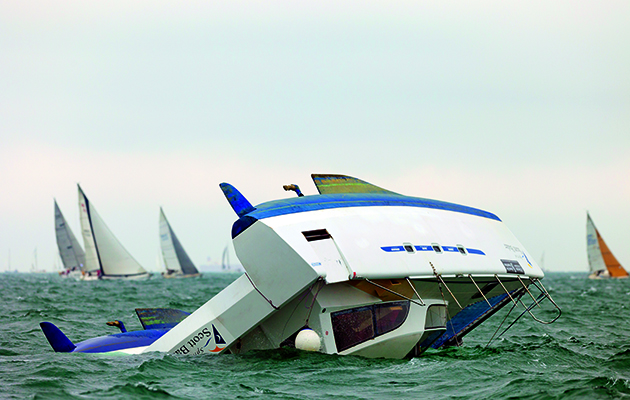
Photo: David Harding

The first thing to say is that as a general rule floating home-type catamarans are, in principle, less likely to be at risk than those designed with performance in mind.
That said, before making such a sweeping statement it’s important to mention that the level of risk involved is much more about the skill and experience of the skipper than about the qualities of the boat on which he or she goes to sea.
Over the years buyers of catamarans have tended to go more and more for the model with enhanced accommodation space (and de facto diminished performance). The bottom line is that in sailing on most ‘charter spec’ catamarans you’d have to be trying hard to win a bet to bring about a capsize.
Building catamarans down to a budget often seems to result in under-sizing of deck gear so that powering up the rig is not really possible. This really is not intended as a criticism – just a reflection on the real-life economics of this market.
If these factors combine make such a catamaran very hard to capsize then this could surely be perceived as a positive result.
Once the discussion turns from the prevention of capsize to the reality of it information and advice is not readily available. There are two different areas that need to be addressed.
The first is about actually surviving the incident in the short term. The second assumes you have managed to do that and is about surviving life on an upturned boat while summoning some help as soon as possible.
Rule one is that if you are on the inside of the boat you should immediately get away from the bridgedeck and head for one or other of the hulls as fast as possible. That’s easier said than done because you’ll be disorientated – especially if it’s dark outside and any lights inside won’t last long.
At the very least if sailing in challenging conditions (especially on a performance boat) it makes sense to bed down between watches in a hull rather than in the central saloon.

Not likely in a cruising cat!
The reasoning is that the boat is unlikely to be supported by the roof for very long when inverted and as she settles down in the water the bridgedeck will soon be close to the water, making an exit attempt risky – especially if there are warps washing around the cockpit.
Stay below if possible
As the hulls themselves are by definition watertight the boat will be buoyant enough to float with (at worst) the threshold of the companionways into the hulls at the surface.
It’s important not to rush for the escape hatch (fitted to the inboard side of each hull) because, although it provides a useful source of light, opening it will let some of the air that’s supporting the boat out of the hull, causing it to float lower in the water.
It is probably best to wait and take stock of the situation – together with anyone else who is in the same hull – and maybe wait for daylight if the capsize has happened at night. Try to find out if others are outside – or perhaps in the other hull.
If, on balance, the decision is taken to leave the hull then it is important to make a plan that results in the hatch being open for as short a time as possible.

Catamaran escape hatch
Clearly if the level of seawater inside the hull is high it is not going to provide a suitable environment for survival while waiting for assistance, so exit is the only option. If on the other hand it is only knee deep then the hull may be the place to stay.
Once again good planning for the worst before going to sea is the way to go and there is plenty of information available about that.
Discussion and planning
As part of the preparation for these dire circumstances it is important to have had a frank discussion about this whole scenario with the supplier of the boat. Has anyone ever capsized this particular design before, and what was learned from that?
Comparing the relative dangers of being at sea in a catamaran that could capsize with those of being in a monohull that could sink has always been a source of lively debate.
The truth is that there are now (and there have always been) risks in going to sea in any vessel. Our best hope in minimising that risk is to face the subject full-on and become as well informed as possible.
Man overboard
While discussing safety issues in the context of catamaran sailing we should take a brief look at that other seafarer’s nightmare – losing a man overboard.
All the normal recovery procedures apply to a catamaran with regard to the all-important location of the casualty, but there are some important differences in the way the approach is made for the recovery.
Because of the high windage of a catamaran and relatively small amount of lateral resistance under the water you can assume that, as you slow the boat down to attempt the pick-up, you’ll make a huge amount of leeway. As a result if you approach to windward of the casualty there is a real danger that the casualty’s legs will be carried under the leeward hull – with a real risk of serious injury from the propeller.

Because of high windage it can be a problem approaching a casualty in the water
To be absolutely safe from this peril just keep to leeward of the casualty. Of course this means that, despite you best efforts, you could pass too far to leeward and won’t be able to get a line to them.
A good way to avoid this problem is to motor at maybe two to three knots across the wind trailing a long line behind the boat (from the leeward stern). You should aim to pass at least 10m to windward of the casualty – which should be easy to judge because you have enough speed to have good steerage way.
Because the casualty will need to hang onto this line it should be easy in the hands – a 14-16mm 8 plait nylon mooring line or similar would be ideal.
When the casualty is directly to leeward of you turn sharply downwind, making a 180° turn that leaves you passing safely to leeward. Slow down at this point, being careful not actually to go astern and risk getting the line around the leeward propeller.
If all goes well the bight of the rope will now be encircling the casualty and at some point he or she will be able to grab hold of it.
From now on you shouldn’t need to engage the drive to either propeller. Keep the helm to leeward and the boat should lie with the wind somewhere on the quarter. If you’re moving too fast – making things difficult for the casualty – you could transfer the line to the bow so that the drag of towing will tend to make the boat round up somewhat – you should be able to control the angle at which the boat lies to the wind by moving the attachment point of the rescue line to different points along the sheer.
If all goes according to plan you should be able to haul the casualty in to the windward quarter of the boat, where they can use the emergency boarding ladder.
If they are not up to that then it should be possible to pass them another rope with a bight in the end of it big enough for them to pass it over their shoulders and under their arms so that they can be hauled aboard.
Do’s and don’ts
- DO take positive action to wise up on the risk of capsize on the catamaran you sail. Asking difficult questions of boat suppliers and collecting opinions from other owners are all valid.
- DO develop some kind of basic plan for the worst case – such as impressing on crew that if below in high-risk conditions then being in the hulls is much safer than being on the bridgedeck. In the case of a man overboard do always make the pick-up from a position downwind of the casualty.
- DON’T take the word of some designer who’s never capsized as gospel – ferret around online and find out what conclusions people who have actually been there have drawn from their experience.
- DON’T risk sailing in bad weather until you have plenty of experience with the boat in more moderate conditions.
- DON’T even think of steering by autopilot when in potentially dangerous conditions. Many accounts of capsize reveal that there was no one on the helm at the critical moment.
- DON’T make a meal of all this. Capsize is very unlikely in most cruising catamarans, but it does happen occasionally so, as with most seamanship issues, the smart move is to be on top of the subject and prepared for the worst.
Our eight-part Catamaran Sailing Skills series by Nigel Irens, in association with Pantaenius , is essential reading for anyone considering a catamaran after being more familiar with handling a monohull.
Part 8: the future of catamaran cruising
Series author: Nigel Irens
One name stands out when you think of multihull design: the British designer Nigel Irens.
His career began when he studied Boatyard Management at what is now Solent University before opening a sailing school in Bristol and later moving to a multihull yard. He and a friend, Mark Pridie, won their class in the 1978 Round Britain race in a salvaged Dick Newick-designed 31-footer. Later, in 1985, he won the Round Britain Race with Tony Bullimore with whom he was jointly awarded Yachtsman of the Year.
His first major design success came in 1984 when his 80ft LOA catamaran Formule Tag set a new 24-hour run, clocking 518 miles. During the 1990s it was his designs that were dominant on the racecourse: Mike Birch’s Fujicolour , Philippe Poupon’s Fleury Michon VIII , Tony Bullimore’s Apricot . Most famous of all was Ellen MacArthur’s 75ft trimaran B&Q, which beat the solo round the world record in 2005.
His designs have included cruising and racing boats, powerboats and monohulls, but it is multis he is best known for.
See the full series here
A special thanks to The Moorings, which supplied a 4800 cat out of their base in Tortola, BVI. www.moorings.com
If you enjoyed this….
Yachting World is the foremost international magazine for bluewater cruisers and offshore sailors. Every month we have practical features to help you plan and prepare to realise your sailing dreams. Build your knowledge month by month with a subscription delivered to your door – and at a discount to the cover price. S ee our latest offers now.
Catamaran Capsize: What to Do When Your Boat Flips
by Emma Sullivan | Aug 10, 2023 | Sailing Adventures

Short answer catamaran capsize:
A catamaran capsize refers to the overturning or tipping over of a catamaran, a type of multihull boat with two parallel hulls. This can occur due to various factors such as strong winds, improper handling, or technical failures. Capsize prevention measures like proper training, ballasting systems, and stability considerations are crucial for safe navigation and reducing the risk of catamaran capsizing incidents.
Understanding Catamaran Capsizing: Causes, Risks, and Prevention
Catamarans are a popular choice among sailing enthusiasts due to their sleek design, stability, and impressive speed. However, even the most experienced sailors can fall victim to catamaran capsizing if they fail to understand the causes, risks involved, and how to prevent mishaps. In this blog post, we will delve into the intricacies of understanding catamaran capsizing to ensure that you can enjoy your sailing adventures with peace of mind.
Causes of Catamaran Capsizing:
1. Overloading: One common cause of catamaran capsizing is overloading. Exceeding the weight limitations of your vessel can lead to instability and loss of control in rough waters. It is essential to understand your catamaran’s maximum carrying capacity and distribute weight evenly throughout the boat.
2. High Winds: Strong gusts can swiftly overpower a catamaran, making it prone to capsizing. Understanding weather patterns and keeping a close eye on wind forecasts becomes crucial before embarking on any sailing journey.
3. Wave Interference: Waves play an integral role in causing catamaran capsizing accidents. Large waves hitting the boat at unfavorable angles can destabilize it or even cause it to pitchpole (the front end dives into a wave while flipping). Studying wave behaviors and having knowledge of proper sailing techniques when encountering such conditions is vital for preventing mishaps.
Risks Involved in Catamaran Capsizing:
1. Injury or Loss of Life: The most significant risk associated with catamaran capsizing is potential injury or loss of life. Falling from a capsized vessel into rough waters poses serious dangers, especially if rescue or self-recovery measures are not promptly executed.
2. Damage to Property: Struggling against strong currents after a capsize can cause considerable damage to both your vessel and other boating equipment on board. Repairs can be costly, and the loss of personal belongings can be emotionally distressing.
3. Environmental Impact: Capsized catamarans may spill fuel, oil, or other hazardous substances into the environment, causing pollution and harm to marine life. Understanding the potential environmental impact of a capsizing event highlights the importance of responsible boating practices.
Preventing Catamaran Capsizing:
1. Proper Training and Education: Acquiring formal training courses in sailing, especially ones specifically focusing on operating a catamaran, is essential for preventing capsizing accidents. Learning about safety procedures, navigation techniques, and understanding your vessel’s capabilities will significantly reduce risks.
2. Maintenance and Inspection: Regularly inspecting your catamaran for any signs of wear or damage can help identify potential issues that could lead to a capsize. Maintaining sails, rigging, and hull integrity ensures that your vessel is in optimal condition for safe sailing .
3. Weather Monitoring: Stay updated with meteorological reports and observe weather patterns carefully before setting sail . Avoid venturing out during severe weather conditions such as high winds or thunderstorms to minimize the risk of capsizing incidents.
4. Weight Distribution: Pay close attention to how weight is distributed within your catamaran to maintain its stability . Ensuring an even distribution across both hulls reduces the risk of capsizing due to imbalance.
5. Safety Equipment: Always have suitable safety equipment readily available onboard your catamaran in case of emergencies. This includes personal flotation devices (PFDs), flares, whistles, safety lines, fire extinguishers, and distress signals – which are all vital tools for rescuers spotting you quickly during a capsize situation.
By thoroughly understanding the causes behind catamaran capsizing incidents along with their associated risks while implementing preventative measures explained above; you can minimize the likelihood of encountering such mishaps on your sailing adventures.”
Remember that maintaining vigilance at all times during your sailing trips is crucial , regardless of your experience level. Stay informed, respect the power of nature, and prioritize safety to ensure a memorable and enjoyable catamaran experience for yourself and everyone on board.
How to React When a Catamaran Capsizes: Step-by-Step Guide
Title: Successfully Navigating a Catamaran Capsizing: A Comprehensive Step-by-Step Guide
Introduction: Catamarans are undoubtedly marvelous vessels, designed to provide both stability and speed on the water . However, even the most experienced sailors may find themselves in a situation where their catamaran capsizes unexpectedly. To help you stay prepared and confident, we have crafted a detailed step-by-step guide on how to react when faced with such an unfortunate event. From staying calm to implementing effective techniques, this guide will equip you with the necessary knowledge to swiftly recover from a catamaran capsizing.
Step 1: Maintain Composure In any crisis situation, keeping calm is key. Take a deep breath, clear your mind and remind yourself that panic only exacerbates the challenge at hand. Remaining composed allows you to think rationally and make wise decisions during each subsequent step.
Step 2: Assess the Situation Upon realizing that your catamaran has capsized, take a moment to evaluate the circumstances around you. Determine whether any crew members or passengers require immediate assistance or medical attention. Prioritizing safety should always be your primary concern.
Step 3: Activate Floatation Devices Ensure that everyone onboard has access to personal floatation devices (PFDs). Encourage everyone to put them on without delay – these will significantly enhance everyone’s chances of staying buoyant while awaiting rescue.
Step 4: Conserve Energy Capsizing can be physically demanding; therefore, it is crucial for everyone involved to conserve energy during this challenging time. Remind crew members and passengers not to exert themselves unnecessarily and advise them on using slow movements in order not to tip over or destabilize the boat further.
Step 5: Establish Communication Locate any communication devices available onboard, such as handheld radios or emergency flares . If possible, make contact with nearby vessels or coastguards immediately for assistance. Modern technologies like personal locator beacons (PLBs) can effectively alert authorities to your location, ensuring swift and targeted rescue efforts.
Step 6: Activate Self-Righting Mechanism Many catamarans are equipped with self-righting features. Determine whether your vessel possesses this capability and, if so, initiate the self-righting mechanism as per your specific manufacturer’s instructions. This will help upright the boat swiftly and minimize any further complications.
Step 7: Teamwork is Essential Maintain a collective mindset throughout the ordeal by fostering teamwork amongst crew members and passengers. Assign roles to individuals based on their abilities, such as staying close to less confident swimmers or assisting in communication efforts. Cooperation plays a vital role in maximizing everyone’s safety during a catamaran capsizing event.
Step 8: Abandon Ship If Necessary In extreme situations where the catamaran cannot be successfully righted or is taking on significant water , abandoning ship may become necessary. Ensure that everyone is aware of emergency escape routes and how to properly use life rafts or other flotation devices for evacuation. Stay together as a group to increase visibility for rescuers and minimize potential risks of separation.
Conclusion: No sailor desires to experience the unsettling event of a catamaran capsizing; however, being well-prepared significantly improves your chances of overcoming such an incident unscathed. By following this step-by-step guide with composure, careful assessment, effective communication, teamwork, and necessary equipment utilization, you will empower yourself and others with confidence when facing such circumstances at sea. Remember: Safety should always remain paramount on any sailing adventure !
Frequently Asked Questions about Catamaran Capsizing
Are you a catamaran enthusiast or someone interested in the world of sailing? If so, you may have heard about catamaran capsizing and the potential risks involved. In this blog post, we will delve into frequently asked questions about catamaran capsizing to provide you with a detailed professional explanation . So let’s dive right in!
1. What is catamaran capsizing? Catamaran capsizing refers to the situation where a catamaran boat overturns or flips onto its side or completely upside down due to various external factors such as strong winds, large waves, or improperly distributed weight on the vessel.
2. What are the common causes of catamaran capsizing? There are several factors that can contribute to a catamaran capsizing. Some of the most common causes include extreme weather conditions such as high winds and heavy waves, sudden shifts in wind direction, improper handling by sailors, insufficient crew experience or training, overloading of equipment or passengers, and structural issues with the boat itself.
3. How likely is it for a catamaran to capsize ? While catamarans are generally considered stable vessels, there is still a chance of capsizing under certain circumstances. The likelihood of capsizing depends on various factors including the size and design of the catamaran, prevailing weather conditions, crew skills and experience levels, and adherence to safety protocols.
4. Can you prevent catamarans from capsizing altogether? While it is impossible to completely eliminate all risks associated with sailing on a catamaran , there are measures that can be taken to minimize the chances of capsizing. These include proper weight distribution on board by evenly distributing passengers and equipment across both hulls, regular maintenance checks and repairs to ensure structural integrity of the vessel, acquiring adequate knowledge about weather patterns before setting sail , keeping an eye on changing wind conditions during trips, and investing in appropriate safety equipment such as life jackets and flotation devices.
5. What should I do if my catamaran capsizes? In the unfortunate event that your catamaran capsizes, it is crucial to remain calm and follow proper safety protocols. Firstly, make sure everyone on board is wearing a life jacket and accounted for. Attempt to right the boat by applying appropriate techniques learned through training or seek professional assistance if necessary. If unable to overturn the catamaran, seek refuge on top of the inverted hulls until rescue arrives or until you are able to safely swim to shore, depending on the proximity of land.
6. Are there any measures in place to enhance catamaran safety? Absolutely! In many sailing communities, there are regulatory bodies and organizations that promote safe sailing practices for catamarans. These can include mandatory safety inspections for vessels, standardized training programs for skippers and crew members, guidelines on weight distribution limits, and recommendations regarding suitable weather conditions for outings.
7. Is catamaran capsizing more dangerous than monohulls? Both catamarans and monohulls have their own unique characteristics when it comes to capsizing risks. While a monohull may be more prone to rolling over completely due to its single hull design, a catamaran is more likely to capsize onto its side or invert partially due to its dual-hull configuration. Both scenarios can present dangers depending on several factors such as sea state , weather conditions, crew experience level, and rescue accessibility.
8. Can I still enjoy sailing on a catamaran without worrying about capsizing? Absolutely! The joy of sailing on a well-maintained and properly operated catamaran far outweighs the potential risks associated with capsizing events. By taking appropriate precautions such as ensuring crew competency level matches prevailing conditions, adhering to weight distribution guidelines set by manufacturers or designers, using reliable weather forecasting services before embarking on trips, and practicing emergency drills with your crew, you can greatly minimize the chance of experiencing a capsizing event.
So there you have it – the frequently asked questions about catamaran capsizing. We hope this detailed professional, witty and clever explanation has shed some light on this topic and provided valuable insights for anyone considering sailing on a catamaran . Remember to always prioritize safety when enjoying your sailing adventures !
The Anatomy of a Catamaran Capsize: Key Factors to Consider
Catamarans are known for their outstanding stability and performance in the water. However, despite their impressive design, these amazing vessels are not immune to capsizing under certain conditions. Understanding the anatomy of a catamaran capsize is essential for sailors and boat enthusiasts alike, as it allows us to learn how to prevent such incidents and ensure our safety when navigating these remarkable watercraft.
One of the key factors that can lead to a catamaran capsize is excessive wind or gusts. While increased wind is generally advantageous for sailing, when coupled with strong currents or waves, it can create an unbalanced force on the boat, increasing the risk of tipping over. A sudden violent gust or wind shift can catch even seasoned sailors off guard, making it crucial to stay vigilant and react promptly by adjusting sails or heading into the wind to reduce pressure on them.
Another vital aspect contributing to a catamaran capsize is weight distribution. Catamarans rely heavily on their wide hulls for stability, which can sometimes lead novice sailors to overlook the significance of proper weight distribution within the vessel. If there is an excess load on one side due to unevenly distributed cargo or passengers congregating in one area of the boat, it can destabilize the catamaran and make it more prone to flipping over during challenging weather conditions .
In addition to excessive wind and poor weight distribution, wave action plays a significant role in catamaran disasters. When powerful waves crash against a catamaran’s hulls at certain angles or heights, they exert tremendous forces that can easily overcome its stability measures. For instance, if caught by an unexpected large wave while crossing a bar entrance or maneuvering through narrow channels where choppy seas prevail, there’s a higher possibility of encountering instability issues that may potentially result in capsize.
Furthermore, sail handling skills are critical when trying to prevent a catamaran from capsizing. A catamaran’s sail plan is designed to optimize performance, but this also means that sail forces can become excessive in challenging conditions. If the sails are not appropriately adjusted or if inexperienced sailors fail to anticipate gusts and adjust accordingly, the boat may be overwhelmed by the power of the wind, leading to an alarming loss of control and potential capsize.
Lastly, seaworthiness is a fundamental consideration when it comes to preventing catamaran capsizes. Regular maintenance and inspections should be conducted to ensure that all vital components such as rigging, rudders, and hull integrity are in impeccable condition. Proper communication equipment should also be onboard at all times to allow for quick distress calls or requests for assistance during unforeseen emergencies.
To conclude, understanding the various factors contributing to a catamaran capsize is essential for any sailor or boat enthusiast who wishes to embark on this exhilarating water adventure. By recognizing the crucial role of excessive wind, weight distribution, wave action, sail handling skills, and seaworthiness precautions, individuals can minimize their risk of encountering a catastrophic event while enjoying the pleasures of sailing on these beautiful vessels. So before setting out on your next catamaran voyage, make sure you’re well-prepared and equipped with safety knowledge that will keep you sailing smoothly !
Top Safety Tips for Avoiding and Surviving a Catamaran Capsize
Title: Navigating the High Seas: Top Safety Tips for Avoiding and Surviving a Catamaran Capsize
Introduction:
The allure of catamarans lies in their ability to skim across the water, effortlessly harnessing the wind’s power . However, as with any water-based activity, accidents can happen. Understanding the necessary precautions and knowing how to react in dire circumstances is paramount to ensure your safety while enjoying this thrilling experience . In this blog post, we present you with our comprehensive guide on top safety tips for avoiding and surviving a catamaran capsize. So buckle up; we’re about to set sail into the world of nautical preparedness!
1. Choose Your Vessel Wisely:
Your primary defense against a capsizing event starts with selecting a suitable catamaran . Ensure that it has appropriate stability features like outriggers or pontoons that offer additional buoyancy in case of rough waters or sudden gusts of wind. Additionally, always check the weather forecast before embarking on your journey to avoid unfavorable conditions.
2. Master Your Catamaran Handling Skills:
Knowledge and expertise are priceless while cruising aboard a catamaran. Familiarize yourself thoroughly with your vessel’s manual, understanding all systems and controls entirely—training courses and sailing schools can be excellent resources for acquiring essential skills such as docking maneuvers, navigation techniques, and emergency drills.
3. Keep an Eye on Weight Distribution:
A well-distributed weight load enhances stability significantly during transfers of power between hulls when riding waves or strong gusts. Ensure that weighty gear is evenly distributed between both hulls, taking care not to place excessive weight on one side which may lead to imbalance and potential tipping.
4. Rigorous Pre-sailing Checks:
Prior to setting sail , conduct thorough pre-departure checks focused on key safety areas such as rigging tension, mast integrity, hull conditions (including hatches), rudder alignment, and electronics functionality. Moreover, make it a habit to inspect the vessel’s keels, ensuring they are free from any debris or obstruction that might affect stability.
5. Appropriate Personal Protective Equipment (PPE):
Never underestimate the importance of PPE for all onboard. Each crew member should be equipped with a well-fitting personal flotation device (PFD) suited for their weight and body type. Additionally, wearing non-slip footwear and donning protective clothing against sunburns will keep you comfortable throughout your journey.
6. Maintain Constant Vigilance:
While the joys of sailing can sometimes be entrancing, maintaining constant situational awareness is crucial aboard a catamaran. Always keep an eye out for sudden changes in wind direction or intensity, potential obstacles such as submerged rocks or reefs, and other moving vessels that may pose collision risks.
7. Execute Controlled Gybes:
Performing controlled gybes (turning the boat downwind) helps mitigate risks associated with strong gusts during maneuvers. By gradually turning instead of executing sharp turns, you reduce the chances of capsizing due to abrupt shifts in wind pressure on the sail .
8. React Swiftly During Capsizing:
Despite taking every possible precautionary measure, there may still be instances where your catamaran capsizes unexpectedly. If this happens, stay calm and remember these essential steps: hold on to something secure within the hull if accessible, prioritize assessing everyone’s safety first before attempting self-rescue; avoid panicking or swimming away from your vessel since it serves as a rescue platform until help arrives.
Conclusion:
Sailing aboard a catamaran provides an exhilarating experience loaded with adventure and serenity; however, being aware of potential risks associated with capsizing is vital to ensure a safe voyage. By following our top safety tips outlined above – choosing the right vessel, mastering handling skills, maintaining correct weight distribution, conducting rigorous pre-sail checks – you can vastly reduce the likelihood of a catamaran capsize. Remember, staying prepared and acting wisely during such an event is paramount to your survival at sea. So, bon voyage, fellow enthusiasts, and may the winds always be in your favor!
Exploring the Aftermath: Recovering from a Catamaran Capsize
Picture yourself sailing peacefully on a gorgeous sunny day, only to have your serene experience shattered by a sudden and unexpected event – a devastating catamaran capsize. It’s an unfortunate incident that can turn your joyful sailing adventure into a daunting and stressful situation . However, fear not! In this blog post, we will dive deep into the aftermath of a catamaran capsize and discuss the steps required to recover both physically and mentally from such an ordeal. So, grab your life jackets and let’s set sail into understanding the complexities of post-capsize recovery!
1. Assessing the Immediate Situation:
When faced with a catamaran capsize, it is crucial to remain calm and composed. Your immediate priority should be ensuring everyone’s safety onboard. Quickly conduct a headcount to account for all crew members while simultaneously checking for injuries or potential dangers in the surrounding environment such as debris or submerged objects.
2. Activating Emergency Signals and Communication Systems:
Once you have secured everyone’s safety, it is vital to activate emergency signals promptly. Utilize any available communication systems to notify nearby vessels or shore authorities about your predicament. This will enable them to dispatch rescue services swiftly, minimizing the time spent adrift.
3. Maneuvering Towards Stability:
With safety measures in place, it’s time to focus on stabilizing your catamaran after its terrifying roll-over incident. Depending on various factors such as water conditions and vessel type , there are multiple techniques you can employ for righting your capsized craft. Perhaps using auxiliary flotation devices or relying on collective crew effort, these methods may vary but share one common goal – restoring stability safely.
4.Controlling Water Intake:
Catamarans may suffer extensive damage during capsize incidents resulting in water flooding their hulls rapidly; thus controlling water intake becomes crucial for successful recovery efforts. Energetically employ bilge pumps or any other available means to eliminate excessive water ingress, as this allows your vessel to regain buoyancy and maneuverability.
5. Assessing the Extent of Damages:
Once stability is restored, it’s time to conduct a thorough inspection of your catamaran. Assess the extent of damages inflicted during the capsize incident carefully. Pay close attention to critical components such as rigging, sails, hull integrity, and safety equipment. Identifying potential structural issues upfront will aid in subsequent repair and recovery plans.
6. Towing or Sail-Assisted Recovery:
Now that you have a comprehensive understanding of damage incurred, it’s time to plan your recovery strategy. Depending on the severity of damages and proximity to help, you may choose between towing your craft back to land or utilizing its remaining sailing capabilities for a sail -assisted return home. Remember, ensuring everyone’s safety remains paramount throughout this decision-making process.
7. Seeking Professional Assistance:
Involving an experienced maritime professional during post-capsize recovery can prove invaluable. They can offer expert advice regarding vessel repairs and assist in making critical decisions about whether immediate repairs are necessary or if repatriating via tow should take precedence.
8. Debriefing and Reflecting:
Finally, once your catamaran is safely repaired or taken for professional assistance; it is essential to reflect upon the tumultuous experience openly with your crew members and those involved in the rescue operation. A debriefing session will not only provide closure but also contribute towards bolstering future safety practices and enhancing preparedness for similar emergencies.
Facing a catamaran capsize might send waves of panic through even the most seasoned sailors; however, with proper preparation, quick thinking, and adherence to safety protocols outlined above – recovering from such an unpredictable event becomes feasible both physically and mentally.
Embrace every opportunity for learning from this experience while acknowledging the resilience displayed by yourself and your crew. Sail on, knowing that you now possess the knowledge to navigate through the aftermath of a catamaran capsize with confidence and grace. Bon voyage!
Recent Posts

- Sailboat Gear and Equipment
- Sailboat Lifestyle
- Sailboat Maintenance
- Sailboat Racing
- Sailboat Tips and Tricks
- Sailboat Types
- Sailing Adventures
- Sailing Destinations
- Sailing Safety
- Sailing Techniques

Can A Catamaran Capsize?
- Post Written By: Boater Jer
- Published: March 24, 2020
- Updated: July 8, 2022

Disclaimer: You might notice that we recommend products in some articles. We may earn a commission for referring you if you click the link and buy a product.
We only recommend products we’ve tried/tested/own (that’s why you won’t find thousands of affiliate links on my site). If you have experience with one of the products we’ve mentioned, please share your experiences in the comments at the end.
Can a catamaran capsize? Can it sink? Are cats safer than monohull boats? We’ll answer these and more questions about the catamaran, how stable a platform it is, whether or not the vessel can capsize and more right here. So, dig in and enjoy the tales of the cat and her sturdy nature.
Not only are catamarans a ton of fun, but they are also typically quite stable. Why? Well, they have two hulls, that’s why. But don’t think you can’t flip one over. Especially the smaller personal watercraft sized cats. They too are really stable but I’ll explain why these incredible little cats can also flip over, otherwise called capsizing.
Capsizing your cat can be a super scary experience. Especially the first time it happens. But, why would a super stable double-hulled craft ever capsize? Well, consider this. The catamaran is ridiculously fast. New cat riders may not realize the sort of speeds they can get on a cat and when they make a sharp turn…
Well, let’s just say that many new cat riders take their speed for granted. Let’s talk about catamarans in general for a moment though.
General Catamarans
The concept of a catamaran is simple. Two hulls are better than one. The catamaran was first created by the indigenous Austronesian peoples. That is, those who spoke the Austronesian languages. These would be people from many modern countries from Madagascar to Taiwan, Micronesia, Polynesia, and the surrounding area. The idea is believed to have come from these peoples lashing two canoes together for added stability in rough waters.
It is this added stability, built right into the very concept of the catamaran that has led to the belief that they cannot capsize. However, even the sturdy nature of a cat can be turned over in the right conditions.
Size Matters
So, when we are discussing whether or not a catamaran can capsize, we have to look at some facts. First off, any boat can technically capsize. Even if it is designed not to, any boat which travels on the surface of the water has the potential to capsize given the right conditions.
Second, we see one thing about catamarans is true and that is the larger the catamaran, the more stable. To sum up, any boat can capsize but the larger the catamaran, the less likely a capsize is to occur.
Personal Watercraft Versus A Ship
Now that we’ve determined the concept that a larger catamaran is more sturdy than a small one, let’s take a look at the size of the vessel and its ability to capsize.
Catamarans are fast. In fact, they are typically faster than monohull craft of equal size. However, we don’t want to get too carried away with their speed. Speed is actually the number one deciding factor when it comes to flipping a small catamaran. Here’s the short and sweet of it for you.
All catamarans go faster than equally sized monohull boats (given equal-sized engines and some other factors we won’t get into here). Sailing catamarans show this extra speed exceptionally well. The smaller the catamaran, the more it has a chance of capsizing. Not due to the instability of the vessel, but typically due to the person at the helm. You see, smaller catamarans go so fast that oftentimes a ‘new’ sailor may try to do a sharp turn at speed, not realizing the extra speed of a catamaran means extra momentum. When the vessel is turned sharply, a tip-over occurs and the personal watercraft can be capsized.
I’ve read forum after forum of new cat sailors describing their first capsize. It was actually quite astonishing to me as I’ve read far and wide about the extra stability of a catamaran and other multi-hull vessels. And it’s always the personal-sized, or catamarans that are meant to be operated by only a few people at the most that seem most vulnerable to flipping. And it’s always because they were going fast and tried to turn too sharply.
Due to the smaller size of personal watercraft, the obvious stability of the larger craft is not present. Not to say that a small catamaran isn’t sturdy. They are always more sturdy than monohull craft of equal length.
When it comes to larger ship sized catamarans, they are always more sturdy and extremely difficult to capsize, even with greater speeds than monohull craft. It seems that capsizing a catamaran is basically held to the smaller sailing cats and typically due to user error.
Frequently Asked Catamaran Questions

Can a catamaran sink?
Yes. Absolutely. Any vessel, ship, boat or other water traveling vehicle can sink. Even a submarine. So, yes a catamaran can sink. Although, catamarans are proven to be more sturdy than monohull craft. This makes them less likely to sink under normal conditions but does not negate the possibility. The difference in trying to sink a catamaran though is that you need to sink two hulls. This makes it ridiculously unlikely to occur.
Are catamarans safer than monohulls?
Yes. Technically a catamaran is safer than a monohull. Why? Well, first off, look at the answer above about the catamaran sinking. If you have two sealed hulls, like on a small personal watercraft sized catamaran, then you would need to puncture BOTH hulls to sink it. The likelihood of this happening is increasingly rare.
The second glaring fact about catamarans is their sturdiness. Imagine you are ice skating. Would you be more secure riding on a single blade (holding one foot up) than you would with both skates on the ice? Two blades are ALWAYS more stable than one. And this is entirely true for a catamaran. Having two hulls makes the vessel a floating platform. A single-hulled ship is more like a single skate on the ice. Having a more sturdy craft means you have a safer one.

Do catamarans make you seasick?
No. Catamarans are not responsible for making you seasick. Technically of course, neither is a boat. It is the rocking motion which is the cause of seasickness. When the rocking motion upsets your inner ear or equilibrium, it can make you disoriented and dizzy. Keep that up and without a strong stomach, you’ll be saying goodbye to the last meal you ate. However, if we’re comparing how seasick, or rather the degree to which a person feels seasickness on a catamaran versus a monohull boat, then the catamaran wins.
Catamarans are more sturdy and secure in the water by their design than a single hull craft. Due to this extra stability, the ride is often smoother and the two hull design mitigates a lot of the rocking motion of smaller waves. This is accomplished by having two hulls spread out on the water as opposed to only one. Therefore a catamaran will give a sailor a lesser degree of seasickness than that which would be felt by the sailor on a monohull boat of equal size.
What is the advantage of a catamaran?
Okay, so we’ve beaten the safety, sturdiness concept to death, right? Well, aside from what we’ve already covered, catamarans offer two more benefits over monohull ships. First, then they are faster. Considerably faster actually. This means you can get from a to b in less time and time, my friends, is the most valuable commodity in existence (yeah, not just on Earth but everywhere). You can’t get time back so a faster ship is, in my opinion, a selling point.
Secondly, the catamaran offers more deck space and if it’s a big ship, then you’ll have considerably more cabin space as well. Consider that a catamaran is two hulls attached via a deck. That means that not only do you have the cabin/deck space of a single hull vessel, but you also have two. But wait, there’s more! What about all the space between the two hulls? You’ve got that to work with also. To sum up, catamarans are safer, sturdier, faster and offer more space in and on the deck of the vessel.
Want to learn more about catamarans? Take a look at my in-depth article all about the different types of catamarans.
Bibliography
- Catamaran – Wikipedia
- Heavy Weather Strategies When Sailing a Catamaran – Sail Magazine
- What causes seasickness? – National Ocean Service, National Oceanic And Atmospheric Administration, U.S. Department of Commerce
More From Boating Guide Magazine
- The Complete Runabout Boat & Trailer Towing Guide
- Pontoon Boat Basics
- 4 Common Types Of Propulsion For Boats
- Boat Hull Types – Which Boat Hull Is Best?
- Boating Gear Requirements For Canada And USA Waters
- Boat Anchors
- Aluminum vs. Fiberglass Bass Boats
- Are Bass Boats Good For Shallow Water?
- This Is WHY Boats Back Into Slips
- Winterizing Your Boat
Boating Guide Home * About Boating Guide * About The Author
Share this post with your friends
- Tags: capsize , catamaran , sinking , storm sailing
Subscribe to our Newsletter
Join us in our love for all things water. And Adventure.
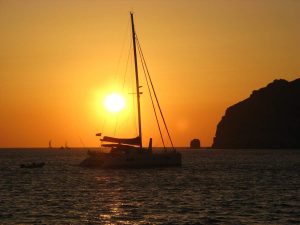
Can a catamaran capsize? Can it sink? Is it safe? I take a deep dive into the subject to bring you the straight answers. No pun intended.

Boat Propeller Anti-Fouling Paint, Grease, And Awesome Tips
Boat Propeller Anti-Fouling Paint questions? You’re in the right place. Boat propellers often develop subaquatic organisms, hindering their performance and degrading their longevity. Antifoul paints and grease slow down the growth or detach these organisms. These products are available commercially, and their application is effortless. However, most people still ask for the best tips to

When Is A Boat Called A Yacht? (Find Out Here – FAST)
When is a boat called a yacht? Let’s find out. The marine community interchangeably uses boats, ships, and yachts. Even though these watercraft mostly sound the same, there are distinct differences among the three. Boats can refer to watercraft ranging from personal vessels to something that can carry one or more passengers. Yachts sound more

How Canoes Are Made (1 Canoe Fabrication Easy Explanation Coming Up!)
Want to know how canoes are made? You’ve come to the best place to find out. Canoe fabrication occurs using an incredible variety of materials. Some are made of wood, while others are plastic, and some metals like aluminum. Each material has its benefits. Some are lighter, some are more durable, and others are almost

Why Do Outboard Motors Cost So Much?
An outboard motor is a product whose price is governed by several factors. These products come at a premium price instead of a budget price. Boat owners are assumed to be economically gratified by default, so a few economics’ concepts of “pricing” come into action here But, why do outboard motors cost so much?. Consider

In-Depth Review of the Pelican Sentinel 100X Fishing Kayak: Pros, Cons, and Performance
As an avid angler, I understand the importance of having a reliable and durable kayak to get where I need to go on the water. After much research, I decided to purchase the Pelican Sentinel 100X fishing kayak, which I can confidently say was an excellent decision. In this review, I’ll provide an in-depth evaluation

Boat Information By Type
© 2023 Boating.Guide, A Hyperwave Media Group Ltd. Publication.
Privacy Overview

- Sails & Canvas
- Hull & Structure
- Maintenance
- Sailing Stories
- Sailing Tips
- Boat Reviews
- Book Reviews
- The Dogwatch
Select Page
Capsize – how it happens
Posted by John Vigor | Sailing Tips
Planning for an unplanned inversion
Capsize: how it happens, and what you can do to survive it.
When Isabelle Autissier’s 60-foot racer capsized in the Southern Ocean, it sent a chill of fear through the sailing community. Sailors don’t like to think of capsize. But here was a big, well-found boat, a Finot-designed Open 60 Class flier, wallowing upside down in huge frigid swells, with her long thin keel jutting toward heaven. It was a bizarre and frightening sight.
Autissier was lucky. She was taking part in the Around Alone race, so her million-dollar boat was equipped with emergency satellite transmitters, position recorders, and lots of other equipment that no normal cruiser is likely to be able to afford or fit on board. She was eventually rescued in a wonderful feat of seamanship by Giovanni Soldini, a fellow competitor.
So what went wrong? And could it happen to you? It depends where you sail, but if you sail out of sight of land, whether at sea or on a lake, the answer is yes, it could. And you should always be prepared for it to happen. The good news is that most yachts of classic proportions will survive a capsize. Unlike Autissier’s extreme design, they will right themselves, although some might take longer than others.
You can form a crude idea of what went wrong with Autissier’s boat by imagining a long plank floating in the water. It doesn’t care which side is up. It’s happy floating either way up. That’s Autissier’s boat. Now imagine a plank with a heavy weight attached along one side, so the plank floats on edge. If you turn it upside down, the ballast quickly pulls it back again. That’s your normal yacht design. Autissier’s racer was shaped too much like a wide plank – too beamy and too light to recover from an inverted position, despite the long heavy keel. It’s one of the paradoxes of naval architecture that an excessively beamy boat, while hard to capsize in the first place, is unseaworthy if she is inverted.
Furthermore, a light, shallow, beamy boat capsizes more easily than a narrow, deep, heavy boat because she offers the seas more leverage to do their work, and because she is quicker to respond to the upward surge of a large swell.
Planing hulls
Designers create racing boats like Autissier’s because that shape gives them the ability to plane at high speeds. In other words, they deliberately sacrifice seaworthiness on the altar of speed, and the boats rely on the skill of their crews to keep them upright. Unfortunately, singlehanders have to sleep now and then, so they can’t be on watch all the time.
While it’s true that a good big boat is less likely to capsize than a good small boat, there is no guarantee that even the largest yachts are immune from capsize. It’s not the wind that’s the problem. It’s the waves.
Tests carried out at Southampton University in England have shown that almost any boat can be turned turtle by a breaking wave with a height equal to 55 percent of the boat’s overall length. Even if you don’t like to think about it, you know in your heart that it’s a reasonable finding. It means your 35-footer could be capsized through 180 degrees by a 20-foot wave. Even a 12-foot breaking wave would roll her 130 degrees from upright – from which position she may turn turtle anyhow.
And if you imagine you’re never going to encounter a 20-foot wave, think again. Waves of that size can be generated in open water by a 40-knot wind blowing for 40 hours. And a 12-foot wave is the result of a 24-knot wind blowing for 24 hours. Plenty of those around.
Large waves are formed in other ways, too. A current flowing against the wind will create seas that are much larger and steeper than normal. And the old stories about every seventh wave being bigger than the rest have a basis of truth, although it’s not necessarily the seventh wave. It could be the fifth or the ninth. The point is that wave trains occasionally fall in step with each other at random intervals, literally riding on one another’s backs, to form an exceptionally high wave. We call that a freak wave, but it’s actually more normal than we care to admit.
Bigger waves
Scientists calculate that one wave in every 23 is more than twice as high as the average. One in 1,175 is three times bigger. And one in 300,000 is four times the average height. They may be far apart, but they’re out there, and many big ships have been lost to them.
John Lacey, a British naval architect, put forward an interesting proposition after the 1979 Fastnet Race, in which 63 yachts experienced at least one knock-down that went farther than 90 degrees and remained upside down for significant periods.
He explained that the old International Offshore Rule for racers had radically changed the shape of yacht hulls by greatly increasing the proportion of beam to length, which gave them more power to carry sail without the need for additional ballast. It also gave them more room below, of course.
But the flatiron shape of the hull made it very stable when it was inverted. To bring the boat upright again would require about half the energy needed to capsize the yacht in the first place, Lacey calculated.
“Since the initial capsize may have been caused by a once-in-a-lifetime freak wave, one could be waiting a long time for a wave big enough to overcome this inverted stability,” he commented. Autissier’s experience bore out that prophetic statement. Her boat was still upside down when she abandoned it.
Lacey did some more sums and figured that a narrower cruising hull with a lower center of gravity than a typical IOR boat would require only one-tenth of the capsize energy to recover from a 180-degree capsize.
“It therefore seems, in my opinion, that we should tackle the problem from the other end, and design yachts for minimum stability when upside down,” he concluded.
Deep-vee cabin
His recommendation is not likely to be taken too seriously, but he certainly does have a point. You could make an inverted yacht unstable with narrow beam, a very deep keel with a lot of weight at the very end of it for righting leverage, and a deep-vee cabintop, or at least one that was narrow on top and broad at deck level. For the same reason, flush-decked yachts should be avoided, because they’re likely to be much more stable upside down.
But as in everything to do with sailboats, there are compromises to be made. Deep narrow hulls might recover quickly from inversion, but as sailors discovered a century ago when they were all the rage, they’re lacking in buoyancy. They’re also wet, and they have very little accommodation.
Two basic design features probably govern the probability of capsize more than any others. The first is inertia and the second is the shape of the keel.
Inertia is not generally well understood, but it’s the first line of defense against a wave impact. In simple terms, inertia is resistance to change. The inertia of a moving boat works to keep her moving on course, even though other forces are trying to halt or divert her. The inertia of a boat at rest resists any sudden attempt to start her moving.
Obviously, because inertia varies with mass, a heavy boat has more inertia than a light boat, so a wave hitting her from the side is going to get a slower response. Light-displacement boats are more likely than heavy boats to be picked up and hurled over by a plunging breaker.
Narrow beam is a help, too, because the force of a breaking wave is concentrated nearer the centerline of the yacht, where it has less overturning leverage.
Spreading weight
The way weight is distributed on a boat also affects its inertia. A wide boat with a light mast and a shallow keel will respond very quickly to every wave with a lively, jerky motion. A boat with a heavier mast and a deeper keel has its weight spread out over a greater span, and it’s more difficult to change its speed or direction, so the force of a breaking wave may be dissipated before it has a chance to overturn the boat. Inertia, incidentally, is what keeps a tightrope walker aloft. It’s contained in that long stick. If you push down on one side of it suddenly to regain your balance, it almost bounces back at you. It will subsequently move slowly away, but you can recover it with a long gentle pull as you lean the other way.
A long, old-fashioned keel resists sudden rolling simply because it’s difficult to move anything that big sideways through the water. A fin keel, with its meager surface area, is much more easily moved when it’s stalled; thus, the boat to which it’s attached is more easily overturned. But a fin keel that’s moving through the water acquires much more stability, which is why fin keelers should be kept moving in heavy weather.
Capsize screening formula
The maximum beam divided by the cube root of the displacement in cubic feet, or Maximum beam (feet) = less than 2 3÷Displ/64 The displacement in cubic feet can be found by dividing the displacement in pounds by 64. The boat is suitable for offshore passages if the result of the calculation is 2.0 or less, but the lower the better.
Although there are design factors that improve seaworthiness (usually at the expense of speed and accommodation), and although there are tactics you can use in a storm to minimize the chances of overturning, no boat is totally capsize-proof. That is not to say that every boat is going to capsize, of course, even the ones most likely to. After all, hundreds of yachts cross oceans every year without mishap. But prudent sailors keep the possibility in mind and do what they can to forestall any problems and to lessen any damage resulting from an inversion.
Large forces
If you have never given any thought to inversion, the results of a capsize can be devastating, not only on deck but down below as well. Not many people realize what large forces are involved in a capsize, especially the head-over-heels capsize called a pitchpole. It’s not just a gentle rolling motion. The contents of lockers and drawers can be flung long distances in the saloon, and you could easily find yourself standing in a state of disorientation on the overhead in a seething mess of battery acid, salt water, clothing, ketchup, mayonnaise, diesel fuel, paint thinner, knives, forks, and shards of broken glass. There will be no fresh air entering the cabin to dissipate the fumes. And it will be dark because your ports will be under water.
So, first things first: presuming you haven’t been injured by flying objects, can you lay hands on flashlights? Were they stored safely in a special place that you can reach without having to shift a wodge of soaked bunk mattresses? Is there one for every member of the crew? Are the batteries fresh? You may not stay upside down for long. But if you’re unlucky, like Isabelle Autissier, you will find you need a flashlight more than anything else on earth.
There are some other things you should think about before you ever set sail. And there are some precautions you can take.
Avoiding capsize
- Avoid heavy weather. “The most dangerous thing on a boat is an inflexible schedule.” Thanks to Tony Ouwehand for this observation.
- Avoid taking large waves abeam, particularly breaking waves.
Heave to. Run (down wave) using a drogue to keep speed down to 3 to 5 knots. Use a sea anchor from the bow or a series drogue from the stern. (Practice rigging and deploying these in moderate conditions.)
- Is your rig as strong as possible? Will it withstand the tremendous forces of a capsize?
- Do you have a plan to free a toppled mast from alongside, where it can batter holes in your hull? Have you ever thought how difficult it would be to cut the rigging, even with a decent pair of bolt cutters, on a slippery deck that’s suddenly rolling viciously?
- Do you have material on board for a jury rig? Have you thought about how you would use it?
- Will your radio transmitter’s antenna come down with the rig? Do you have a spare?
- Will your EPIRB start working automatically because it’s been under water – whether you want it to or not?
The cockpit
- Are your cockpit lockers waterproof? Can you imagine how quickly you’d sink if one of them was open at the time of capsize?
- Do your companionway hatchboards lock in position? Have you ever thought how much water would get below if one or more fell out as you turned over?
- What have you done about waterproofing the cowl vents for the engine? Those are huge holes in what would become the bottom of the boat. (The same goes for Dorade boxes, incidentally. Each one is a potential three- or four-inch hole in the bottom. Fit them with deck plates for sea work, on deck and down below.)
- If you’re in the cockpit when the boat capsizes, will you be attached by a harness? Will you be able to free yourself if you’re trapped under water and the boat stays inverted for some time?
The anchor locker
- If the anchors and chain are not fastened down securely they could bash their way through the locker lid and cause all kinds of havoc.
- Is your self-draining deck anchor locker waterproof? Many aren’t completely sealed at the top, where wires for pulpit-mounted running lights come though, and would let in water.
The engine room
- Is your engine mounted securely enough to withstand a capsize? I know of one boat in which the engine was hurled from its mounts during a pitchpole, causing great destruction.
- What if the engine’s running during a capsize? Could you switch it off quickly, with everything upside down? Would the oil run out? Would the fuel drip out of the tanks? Are your breathers inside or outside?
- Are the batteries fastened down firmly enough? Can you imagine what damage they could do if they got loose? And will they drip acid if they’re upside down? (Newer batteries – gel cells and AGMs will not spill acid when inverted. -Ed.)
- Can you turn the stove off? If there’s a smell of gas, can you deal with it? Have you made sure the galley cupboards can’t fly open during a capsize and turn the saloon into a sea of broken glass and chip dip?
- Can you lay hands on a fire extinguisher quickly? It could save your life.
- Have you figured out a way to keep all those loose tops in place in the saloon – the boards that cover access to storage under bunks, the bilge boards, and so on? Some boats have inside ballast, and many have heavy objects, such as storm anchors, stowed in the bilges. Make sure they stay there, because if they get loose they can come crashing through the overhead (your new “floor”) and sink the boat very quickly.
- Make sure your bunk mattresses will stay in place, too, otherwise they will greatly hamper your attempts to get around.
- Have you figured out a way to pump bilge water out of an inverted boat? Think about it. It’s not easy.
- Most books could escape from their racks during a capsize and become potentially harmful flying objects. Have you solved that problem?
Important documents
- The ship’s papers and your own personal documents should be in a watertight container in a secure locker, one that is not too high up in the boat because that’s where the water will be when you capsize.
There are many other systems and pieces of gear on a boat that could be affected by a capsize. When you use them, think inverted. Imagine what would happen if they got loose. Invent ways to keep things in their places during an unplanned inversion. Don’t ever imagine it’s wasted work. It’s one of the unspoken rules of the sea that if you’re prepared, the worst is not likely to happen. If you’re not, you’re bound to attract trouble.
More on the subject
Tami Ashcraft wrote a compelling story of the realities of inversion and its aftermath in her book, Red Sky in Mourning: The True Story of a Woman’s Courage and Survival at Sea , reviewed in our May 2000 issue. John Vigor goes into more depth about preparation for capsize in his book, The Seaworthy Offshore Sailboat .
Article from Good Old Boat magazine, November/December 2000.
About The Author
John Vigor is a retired journalist and the author of 12 books about small boats, among them Things I Wish I’d Known Before I Started Sailing, which won the prestigious John Southam Award, and Small Boat to Freedom. A former editorial writer for the San Diego Union-Tribune, he’s also the former editor of Sea magazine and a former copy editor of Good Old Boat. A national sailing dinghy champion in South Africa’s International Mirror Class, he now lives in Bellingham, Washington. Find him at johnvigor.com.
Related Posts
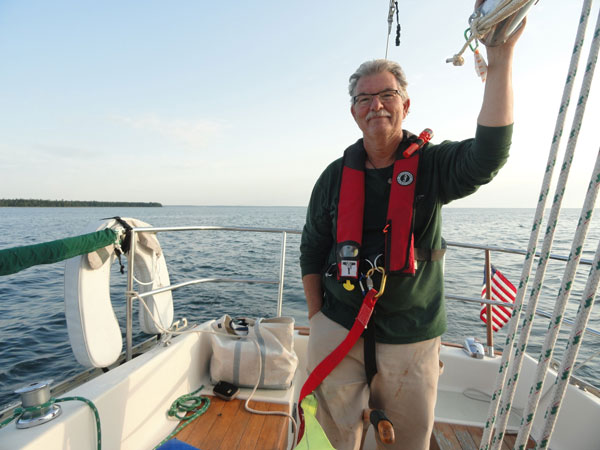
An open letter to beginning sailors
November 1, 2017
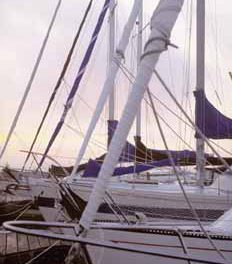
Diamond-in-the-rough, perhaps, but how rough?
July 17, 2019

The Epic Bee Saga
October 1, 2017
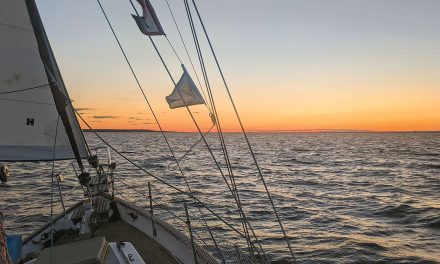
Distance to the Horizon
May 1, 2012
Current Edition
Join Our Mailing List
Get the best sailing news, boat project how-tos and more delivered to your inbox.
You have Successfully Subscribed!

How To Sail a Small Catamaran (Complete Guide)
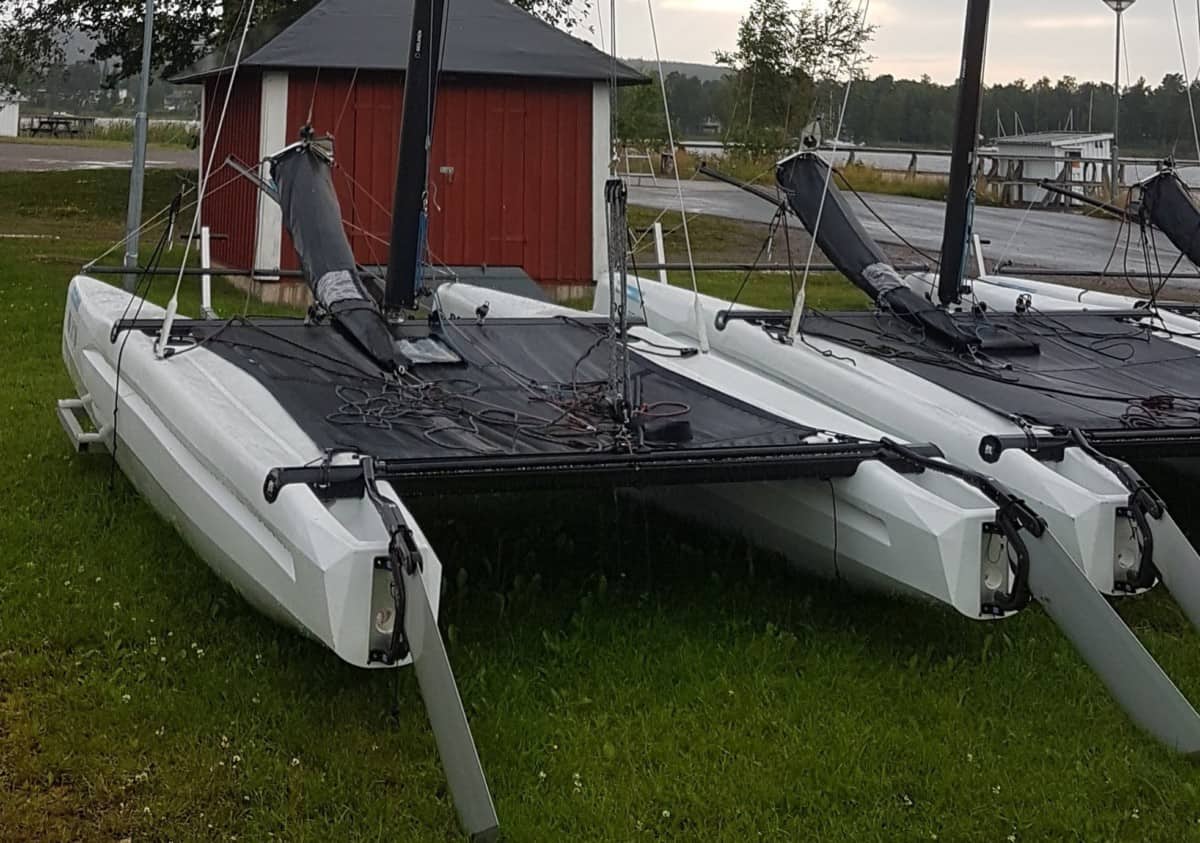
As an Amazon Associate, we earn from qualifying purchases. We may also earn commissions if you purchase products from other retailers after clicking on a link from our site.
Learning how to sail a small catamaran(also known as beach cats) can be the beginning of a new and exciting chapter in your life. It gives you the freedom to comfortably explore the waters, which offers a stimulating and relaxing sensation. If you’re interested in learning how to sail, it is advisable to start with a small catamaran.
To sail a small catamaran (beach cat), first, familiarize yourself with the catamaran’s essential parts and common sailing terminologies. Understand how it works and equip yourself with the necessary sailing gear. Additionally, you’ll need to understand the points of sail, how to steer, turn, and stop the cat.
This guide outlines what you need to know about sailing a small catamaran. Read on to learn more on:
- What is a catamaran?
- Understanding how a catamaran works
- Getting equipped
- Sailing basics
Looking to buy a small catamaran? Read my article Best Catamarans For Beginners
Table of Contents
Understanding a Catamaran
The first step in learning how to sail a small catamaran is to understand its essentials. We begin by looking at what a catamaran is, its essential features, and some standard sailing terms. Understanding the necessary parts of a cat and sailing terminologies helps with communication when sailing.
What Is a Catamaran?
A catamaran is a famous multi-hulled water vessel that features two parallel hulls and sails. Catamarans vary in size and shape, depending on the model and design. However, here we’re looking at the small catamarans (a.k.a. beach catamarans) and how to sail them.
Parts of a Small Catamaran
Below are the essential parts of a catamaran regardless of its model or design:
- Hull : It is the main body of the cat. It has a symmetrical shape, which reduces the drag caused by water friction.
- Tiller : It is a handle or bar that turns the catamaran’s rudder.
- Rudder : An underwater vertical moving board often turned using a tiller (or steering wheel) to initiate movement.
- Keel : It is a centreline attached below the hull running from the front (bow) to your cat’s back (stern). The keel offers stability to the cat and reduces the chances of it capsizing.
- Mast : A long pole set upright from the center of the boat to support the sails.
- Mainsail : It is the most critical sail on a cat that is attached to the mast.
- Foresail : Also known as the jib. It is a sail that fits into the foretriangle of the mast.
- Boom: This is a horizontal pole attached to the mast used for extending the foot of the mainsail.
A full interactive guide on catamaran parts explained ?
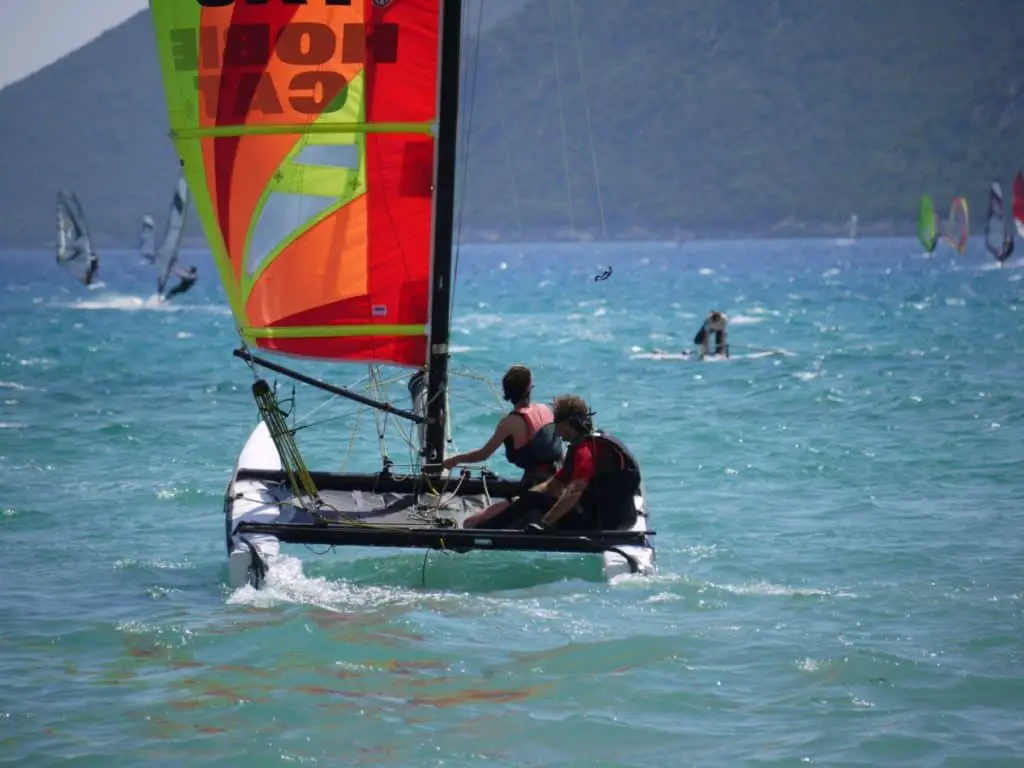
Common Sailing Terminologies
Now let’s look at some terms to add to your sailing vocabulary.
- Point of sail : The direction of your cat relative to the wind.
- Port : When facing forward, your cat’s left side is referred to as the port.
- Starboard : Refers to anything to the right of your cat when you are facing forward.
- Bow/ stern : The front and back of the catamaran, respectively. Additionally, you can refer to the bow as ‘forward’ and the stern as ‘abaft/ aft.’
- Tack: Changing the direction of your cat by turning the bow through the wind.
- Jib (gybe): Turning the stern of your cat through the wind to change direction.
- Heeling: A situation where the wind pushes your cat as it leans over in the water.
- Windward: The side of your catamaran that is closest to the wind. It can also be defined as the direction upwind from the point of reference.
- Leeward: The side of your cat far away from the wind. It is the direction of a cat upwind from the point of reference.
- Aboard: On or within the catamaran
- Halyards : Ropes used in raising or lowering the sails on the mast.
- Sheets: Are ropes that control the angle of the sails relative to the wind’s direction.
- Tacking vs Jibing Explained
Learning How a Small Catamaran Works
After gaining knowledge of parts of a cat and the common sailing terms, the next step is to understand how the catamaran works. Here, we’ll look at how the wind gets your catamaran moving.
As the sail of your small catamaran fills with wind, it forms an airfoil that propels your cat. Your sails play the most significant role in keeping your cat moving. As a result, you have to pay much attention to their positioning relative to the wind.
You start by raising the sails using the halyards. The mainsail (the sail closest to the stern) should be raised first, followed by the jib (the sail closer to the bow). With your sails raised, you should then trim them relative to the direction of the wind. By trimming your sails, you position them at an angle where they capture more wind.
As a newbie, you should first learn raising and trimming the mainsail before the jib because you will use it more when sailing your small catamaran.
However, you should note that you don’t rely solely on the sails and the wind to get your catamaran moving. You should also use the tiller to move and control the rudder. This way, you will be in a position to angle your cat in your preferred direction.
As you continue sailing, the wind’s direction keeps on changing. As a result, you should use sheets to trim your sails while tacking and jibing with respect to the wind’s direction changes.
Getting Equipped
After learning how a catamaran works, you are a step closer to practicing in the waters. However, before this, you need to prepare yourself by getting the right sailing gear. Your instructor should advise you on the right clothes and safety equipment.
Here are some items you should not leave behind:
- Shoes : You’ll need a pair of fitting shoes that you can comfortably use on the deck. They should be grippy and non-marking.
- Gloves : It is also advisable to have quality sailing gloves. They should be comfortable to wear and also allow you to control the tiller and perform other duties on board. Consider getting heavy-duty and breathable gloves.
- Sunglasses: You’ll also need good polarized sunglasses that will protect your eyes from the glare. When learning how to sail, it is essential to see how the water is moving. This helps in learning how to read the wind.
- Windbreaker : Do not forget a piece of clothing that will keep you comfortable even under windy conditions. It should be warm and waterproof.
- Logbook: You’ll also need a book where you can keep all your sailing records. You can indicate how many sailing classes you’ve taken, the number of hours you’ve sailed, and the waters, shallow or deep.
- Compass / GPS : Don’t leave behind a compass and a map. These come in handy when you want to find a bearing or are lost in the sea.
- First aid kit : When packing your essentials, don’t leave behind a first aid kit. As a newbie, you might have sea sickness during your first sailing sessions. Carry a kit with the right prescriptions.
- Finally, do not leave behind a phone and a power bank, plus enough food and water.
After preparing yourself for sailing, you should also prepare your small catamaran.
Preparing the Catamaran
Preparing your beach catamaran for sailing involves analyzing its parts and studying the prevailing weather conditions.
Perform a Physical Check
First up, conduct a detailed physical check to see if all the parts are in their stable working conditions:
- Check if the tiller is moving freely to control the rudder.
- Look at the condition of your sails. Ensure they are straight and with no holes or frayed edges.
- The rigging should be in their perfect working conditions. Check the standing rigging (everything that keeps the mast and sails upright) and the running rigging (the lines used to raise and control the sails).
- Check all lines . They should be free. This means they should not be wrapped against each other or around any objects aboard. Here you may also need to tie line knots if you intend to use them during your sail.
Study the Wind
Before getting into the waters, you’ve to study the direction of the wind. Knowing how the wind is blowing helps in the proper positioning of the sails and the cat. You can check the wind’s direction by looking at wind instruments in your small catamaran.
Most catamarans have wind indicators strategically placed on their mast. You can use this. Additionally, you can tie small flags on the sides of your cat to help with the direction. Knowing where the wind is coming from allows you to position your cat at the right point of sail.
Points of Sail
The point of sail defines the direction of the wind relative to your cat. With the right point of sail, you will be in a position to sail your catamaran smoothly. The point of sail differs depending on the angle of your cat from the wind. The different points of sail include:
- Running : In a running point of sail, the wind blows behind your back. It is not advisable to use this point of sail as accidents are prone to occur if the wind’s force pushes over your small cat.
- Broad reach : The wind is partially at your back and your side (aft quarter).
- Close reach : Here, you are sailing at approximately 60-75 off the wind.
- Beam reach : You position your cat at an angle of 90 of the wind. It is considered the most precise sailing position.
- Close haul : At this point of sail, you are approximately 45-60 off the wind.
Hoisting the Sails
Now that you have already identified the wind’s direction and positioned your cat, the next important thing is hoisting the sails. While hoisting your sails, it is advisable to start with the mainsail.
- To start with, secure the bottom front of the mainsail to the respective shackles on the boom.
- Notice a small line known as an outhaul that attaches the clew (the lower back part of the mainsail) to the boom. Carefully pull it out until the mainsail forms a smooth airfoil allowing wind to blow over it.
- Now pull down the halyard until it stops . You will notice some flapping on the mainsail, which is normal.
- Ensure that the mainsail’s edges are smooth , then attach the halyard on the winch or cleat.
- Now shift to the jib and hoist it . Start by securing its bottom front part to the boom and then follow a process similar to that of hoisting the mainsail.
Start Sailing
As a newbie, you need to ensure you are on a safe sailing point during your practice sessions. Avoid going far into the waters with your small catamaran during your first training sessions.
Also, ensure that you have enough space around you for your catamaran to turn in response to the wind movements. This is to avoid being thrown back into the dock or in the sand by the moving wind.
As you start sailing, you’ll notice the effects of the wind on your cat. As a result, you may need to make a turn through tacking or jibing .
When sailing, always make sure you place yourself at the right point in your catamaran. Sit at the side where the wind is blowing to; the wind should blow from your back. This means you should be on the opposite side of the sail and not beneath it. Sitting on the wrong side might cause your cat to flip over.
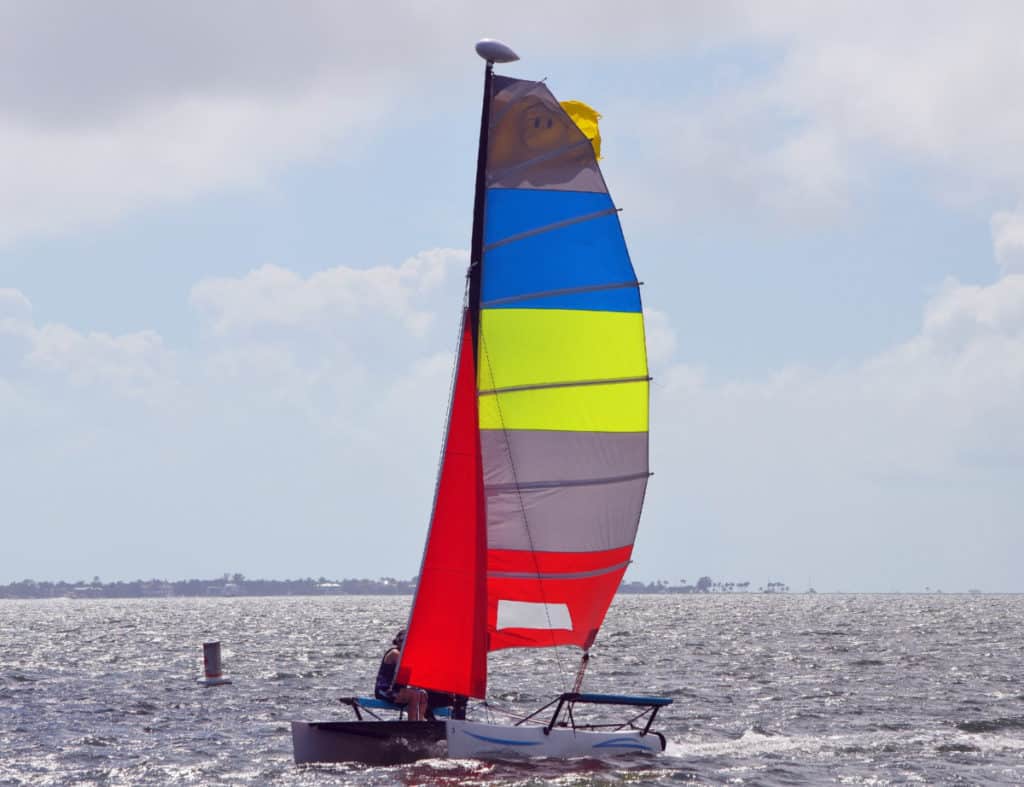
Now that you already know how to get your cat moving, let’s look at steering. Steering the cat is often unclear to most newbies.
Small catamarans are steered using a tiller that controls the rudder. What confuses most sailors is that you move the tiller in the opposite direction from which you want your cat to move. So, if you’re going to turn to the right, you will push your tiller to the left and vice versa.
Since steering a small cat differs from steering other moving vessels, the experience may feel awkward at first. However, you shouldn’t feel pressured to master it all at once. Take your time and practice until you master the process.
Trimming the Sails
As you continue learning how to sail, you also need to understand how to control your cat by trimming sails. Trimming sails means adjusting the positioning of your sails to control the movement of your cat.
As a learner, to effectively and safely trim your sails, you should first position your tiller to reduce the movement of your cat to either side. Start by trimming the mainsail.
Tighten the mainsail to stop flapping and for it to take a new shape relative to the wind’s direction. As your mainsail takes a new form, your cat will start building some speed. Quickly grab the jib and adjust it too.
To tighten the jib, stretch it as much as you can to reduce flapping/ luffing. Once the flapping has reduced, loosen it and let it out until the edge of its luff (the forward end of the jib) is shaking. Now tighten it back in its new position, and you are ready to go.
If you are sailing close to the wind, you have to keep your sails tighter than usual. On the other hand, if you are sailing off the wind, your sail should be left loose. Generally, tight sails cause your cat to move faster, while the opposite is true for loose sails.
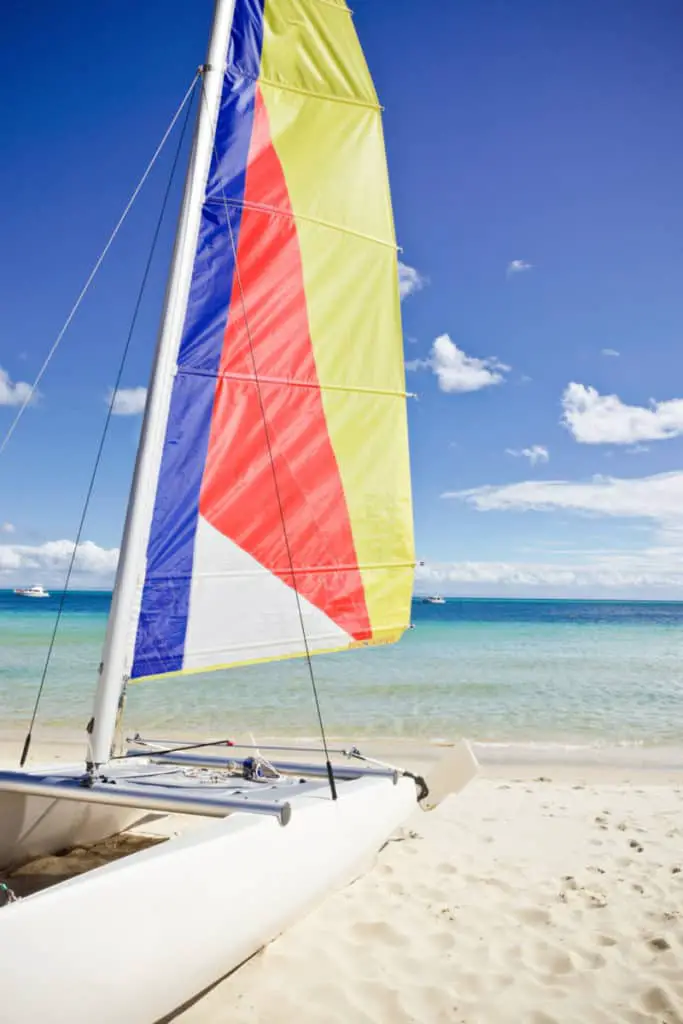
Turning the Catamaran
You’ll also need to learn how to turn a catamaran. As a learner, after releasing the mooring line, you should be prepared to turn the catamaran by moving the boom to either side. As you push out the boom, the wind will hit your sail from the back, making your cat turn.
Therefore, you should be cautious enough to avoid turning in the wrong direction. Like in moving the tiller, you also push out the boom into the opposite direction you want to turn. Therefore, when turning to the right, you push out the boom to the left and vice versa.
Slowing Down and Stopping
Although sailing a small catamaran at high speeds is fun, you may at some point want to slow down. When you detect an obstacle in the water, you may need to slow down. Most sailors use the term ‘spill wind’ to refer to the action of slowing down and stopping a cat.
Since tighter sails often accelerate the speed of your cat, you can slow it down by loosening them a little. The more you let your sails out, the more your cat slows down and eventually stops.
It is advisable to release the sails as you face the wind’s direction to help your cat stop. If you are sailing against the wind, first turn your cat in the direction of the wind, then release the sails.
Practice slowing down and stopping your cat under different weather conditions to be prepared in case of an emergency. Since your cat has no brakes, you should practice this until you perfect your skills.
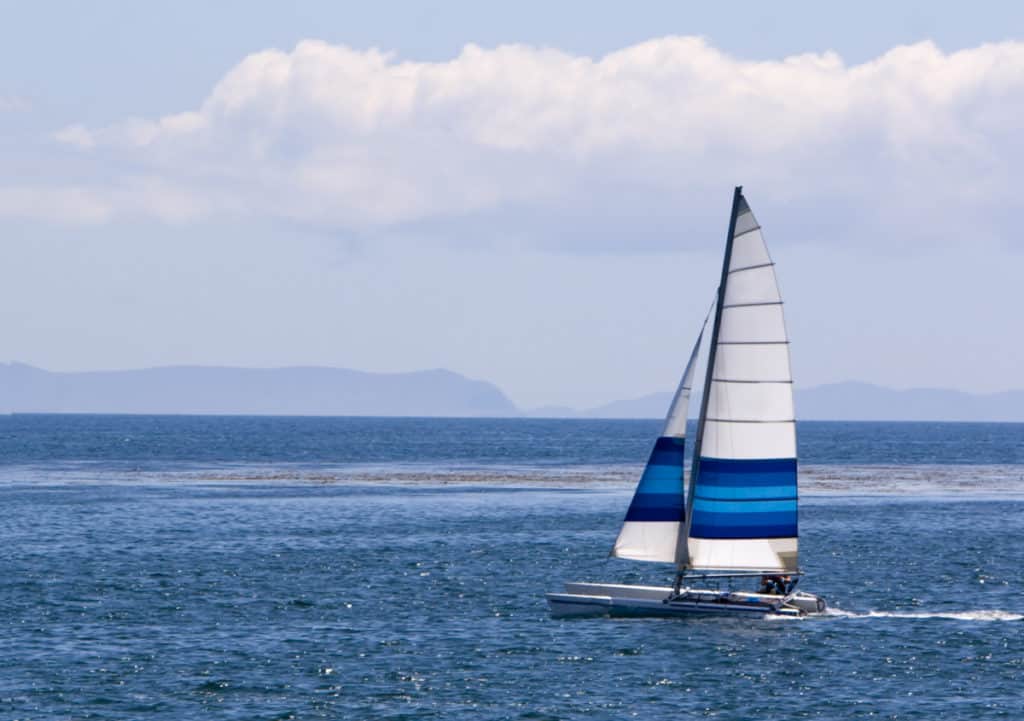

Capsize Recovery
Although capsizing is not common in catamarans, it can happen and it is crucial always to be prepared. If your small catamaran capsizes, it is advisable to start the recovery process immediately before the situation worsens. Let’s look at how to right a capsized catamaran.
Why and how often do catamarans capsize, a scientific approach!
You can right most small catamarans by pushing the bow or stern below the water to rotate them upright.
To right your capsized catamaran:
- Lower down your bow and stern until your cat lies in a vertical position.
- One crew member should then swim around to one end of the lower hull and then push it down. By pushing the lower end down, the uppermost hull’s end comes down towards the water.
- As the uppermost hull drops towards the water, it is pulled down by another crew member. In the meantime, the other crew pushes the cat up midway along the lower hull.
- This movement puts your cat in a vertical position in the water. The crew members then swim to the mast and push it back to its standard sailing position. They then climb aboard fast before the cat sails off.
Avoid sailing alone. Always have some crew members to help you out in case of a capsize.
Learning how to sail a small catamaran is a process that requires practice and patience to perfect your skills. Therefore, don’t feel pressured; take it slow, a step at a time. Start by understanding the essentials of a catamaran, preparing yourself and your cat for the adventure, and learning some sailing basics.
The fundamental sailing basics outlined in this guide are the points of sail, steering, trimming sails, slowing down, and righting a cat after a capsize. Follow our guide today and become a pro in sailing a small catamaran.
- Catamaran Parts Explained
- Why do catamarans capsize?
Owner of CatamaranFreedom.com. A minimalist that has lived in a caravan in Sweden, 35ft Monohull in the Bahamas, and right now in his self-built Van. He just started the next adventure, to circumnavigate the world on a Catamaran!
Leave a Reply Cancel reply
Your email address will not be published. Required fields are marked *
Save my name and email in this browser for the next time I comment.
Recent Posts
Must-Have Boat Gear for Catamaran Sailors!
Sailing is probably the most gear-intensive activity I've ever done; there are so many decisions to be made about what gear to buy now, for tomorrow, and what to definitely never buy. The gear on...
6 Best Trailerable Trimarans For Bluewater and Coastal Sailing
Having a boat costs a lot of money, even when you are not using it, marina fees, etc. And once it is in the water most sailors never go very far from their "home marina" and sailing will be somewhat...
Tacking and jibing a catamaran
Catamarans tend to tack and jibe more slowly than monohull dinghies , but provide better stability. This is particularly noticeable when jibing, which is comparatively easy to control. The technique for both maneuvers is very different from a center mainsheet dinghy .
TACKING TIPS
In a catamaran, the helmsman should steer into the tack with the rig powered up and the boat sailing at speed. Steer carefully through the tack; be aware that slamming the rudders over can make them act as brakes. Both crew should stay on the windward side until the jib has

As you start to tack, keep the jib backed in order to help turn the bows, as catamarans are often slow to turn through the wind. Highperformance catamarans with daggerboards can pivot more quickly through the turn.

The helmsman faces aft as he crosses the boat, easing the mainsheet before ducking underthe boom. The crew watches the mainsail carefully, waiting until the mainsail has filled on the new side.
backed. This will help to lift the leeward hull, so that the catamaran pivots on the inside hull. Keep both the mainsheet and jib sheet pulled in tight until the jib starts to back and the bows bear away on the new tack. The helmsman should face aft while moving across the boat, easing the mainsheet to help "pop" the battens into their new position and accelerate the catamaran on to the new tack.
Crossing the eye of the wind to windward is similar for catamarans and dinghies, but usually you are tacking from a close reach instead of a close hauled course.

When the mainsail has filled on the new side, the crew pulls in the jib on that side. The helmsman and crew take up their new positions, ready to accelerate on the new tack before luffing to the new close reaching course.
TACKING AND JIBING A CATAMARAN 147
JiBiNG Tips
Catamarans are easier to jibe than monohull dinghies because they are more stable, and are unlikely to capsize when both hulls are on the water. As with any sailing boat, jibing becomes more challenging in stronger winds. Be aware that if you steer a catamaran into a jibe at high speed and then slow right down, the apparent wind will swing behind the boat and power up the rig midway through the jibe. Keeping the boat at a steady speed throughout the turn is the surest way to maintain control. As with tacking, the helmsman should steer carefully and progressively through the maneuver to avoid turning the rudders into brakes and halting part way through the turn.
Crossing the eye of the wind on to a downwind course you are usually jibing from broad reach to broad reach.

Ithe catamaran is at maximum speed as it bears away into the jibe. In light winds especially, the crew weight should be kept forward so the sterns do not dig into the water and slow the boat.

2 the helmsman faces aft while the crew faces forward as they cross the trampoline. At the right moment, the helmsman must flip the tiller extension past the boom end, on to the new side.
4 Once the mainsail has jibed, the helmsman straightens the rudders to prevent the bows turning too far into the wind. In lighter winds, it may be necessary to "pump" the boom so the full length battens curve the right way.
3 the helmsman takes hold of the falls of the mainsheet to pull the mainsail over to complete the jibe, while at the same time steering through the downwind point on to the new course.

"we have salt in our blood, in our sweat, in our tears— we are tied to the ocean."
John Fitzgerald Kennedy

Catamaran capsize
When a catamaran capsizes, the crew need good technique in order to pull it up. This may include righting from a pitchpole or from total inversion.
A catamaran can capsize by being blown over sideways, or by driving the leeward bow into the water and "pitchpoling" (nosediving), as shown here. If you are out on the trapeze, try not to fall into the mainsail as this could break battens or push the boat upside down. Beware also of being thrown forward in a pitchpole, when the crew may swing around the bows as the boat suddenly decelerates. A catamaran floating on its side may be blown downwind faster than you can swim, so grab something as soon as you are in the water, to maintain contact. You can climb on to the lower hull of a capsized catamaran, or the underneath of the trampoline if it is upside down. Both are secure positions while you prepare to right.
PITCHPOLING
Catamarans have a tendency to dig the leeward bow into the water when unbalanced, resulting in a head-first capsize.
If the catamaran starts to invert, swim clear of the trampoline to ensure you are not trapped underneath the boat.
CATAMARAN CAPSIZE

If the catamaran is upside down, the crew should scramble onto the bottom hull, standing forward so that the bows swing around Into the wind. The boat will then be under control as It rights.
2 With both crew standingon the bottom hull, lead the righting line (normally in a pocket close to the mast base) overthe upper (windward) hull. Pull to lift the windward bow, helping the rig float to the surface.

3 Make sure all sheets are uncleated and pull again on the righting line to lift the rig out of the water. Once the wind can blow under the rig, giving additional lifting power, righting should be easy.
4 A lightweight crew may have insufficient leverage to lift the rig. One solution is for the crew to "piggyback" on the helmsman. If that does not work, a rescue boat may be needed to help lift the mast.

5 The catamaran will accelerate as it rolls upright. Both crew should drop into the water by the front beam, ready to hold the boat steady as the hull comes down, and prevent another capsize.
6 Climb back on board from the side. Climbing over the front beam can be difficult; clambering over the rear beam risks bruises or, more seriously, a bent tiller bar.

Continue reading here: Dinghy racing
Was this article helpful?
Recommended Programs

Myboatplans 518 Boat Plans
Related Posts
- Sailing a catamaran - Sailing Techniques
- Catamaran Design Guide - Catamarans Guide
- How to tack - Sailing Procedures
- Jibing a dinghy - Sailing Techniques
- Introduction to catamarans
Readers' Questions
How do i turn my catamaran faster?
There are several ways you can potentially make your catamaran turn faster: Adjust the sail trim: Properly adjusting the sail trim can significantly affect the speed and maneuverability of your catamaran. Experiment with different sail settings, such as trimming the sails in more, letting them out slightly, or adjusting the angle of attack. This can help optimize your boat's performance in different wind conditions. Move crew weight: Shifting the weight of crew members can impact the catamaran's balance and stability, affecting its maneuverability. Refine your weight distribution, moving crew members and gear to improve the boat's ability to turn. For example, moving crew weight to the leeward side during turns can improve the boat's stability and responsiveness. Use the rudders effectively: The rudders are vital for controlling the direction and turning of the catamaran. Utilize your rudders strategically by applying slight pressure or adjustments to steer the boat more efficiently through turns. Practice using the rudders to initiate turns at the right time and angle to maximize performance. Optimize your route: Planning your route effectively can help you take advantage of wind shifts and currents to enhance your catamaran's turning ability. Analyze the wind patterns and choose your course wisely to achieve better angles during turns. Practice maneuvering techniques: Regularly practicing various maneuvering techniques can help you develop a better understanding of your catamaran's capabilities and improve your turning skills. This may include practicing tacking and gybing, mastering the timing and coordination required for smooth turns. Remember, every catamaran is unique, so it may require some experimentation and experience to determine the best techniques for maximizing your boat's turning ability. Safety should always be a priority, so ensure you have the necessary skills and knowledge before pushing the limits of your catamaran.
How to tack a catamaran dinghy?
Prepare your catamaran dinghy for tacking by taking out the rudder, mast, and sails. Stand in the center of the dinghy and prepare the sails for tacking by extending the spreader and headsail sheets out. Take one of the sheets in your hand and pull it tight while pushing the dinghy against the wind. Maintain the tension on the sheet and gradually start to turn the boat in the direction of the wind. At the same time, you want to shift your weight to the opposite side of the dinghy. Make sure to keep the sail full and to keep tension on the sheets. When the boat is about halfway through its tack, the sails should be 180° from their original angle. Make sure the sails remain full and finish the tack by allowing the sheets to be pulled tight. Once the tack is complete, make sure the dinghy is away from the wind, and you are ready to go.
How to successfully tack a catamaran?
Tacking a catamaran refers to changing the direction of the boat while sailing into the wind. Here are the steps to successfully tack a catamaran: Prepare the boat: Ensure that all equipment, sails, and rigging are in good condition and properly adjusted. Make sure you have a clear understanding of the boat's design and handling characteristics. Communication: If sailing with a crew, ensure proper communication and coordination between crew members. Assign roles and establish clear communication channels to avoid confusion during the tack. Determine wind direction: Observe the wind direction and identify the direction you want to sail toward. Prepare the sails: Ease the main sheet and release tension from the jib or jib sheets, allowing them to luff. Helm orientation: Steer the boat close-hauled, generally pointing at a 45-degree angle into the wind. Initiate the tack: To initiate the tack, turn the boat's bow through the wind to the opposite side. This should be done gradually to prevent excessive heeling or loss of control. Use the tiller or steering wheel to gradually turn the boat. Trim the jib: As the boat completes the turn and the sails start to fill on the opposite side, trim the jib sheet to tighten the jib. Trim the main sail: Once the sails are filled, trim the main sheet to achieve the desired sail trim for the new direction. Gradually tighten the sheet to prevent excessive heeling or overpowering the boat. Balance the boat: Make any necessary adjustments to maintain a balanced and controlled sailing position. Resume course: Once the tack is complete and the boat is on a new heading, resume sailing toward your desired direction. Remember, practice and experience play a significant role in successfully tacking a catamaran. It may take time to develop a feel for the boat's handling characteristics, so stay patient and keep practicing. Additionally, always prioritize safety by wearing appropriate safety gear and following boating regulations.
How to tack a catamaran?
Tacking a catamaran is very similar to tacking a monohull sailboat. When a boat is tacked, the sails change sides and the bow of the boat turns through the wind to the opposite side. On a catamaran this means clearing the leeward hull from the wind and pointing it so that it is heading evenly upwind. To do this, the jib sail is first eased and then sheeted in on the opposite side. The mainsail is then eased and trimmed to the other side. As the boat turns, the new leeward hull is pushed downwind and the windward hull is given larger angle of attack. Finally, the sails are trimmed to balance the boat.
Which is easier tacking or jibing?
Tacking is generally considered to be easier than jibing. Tacking involves changing direction by shifting the bow of the boat through the wind, while jibing involves changing direction by steering the stern of the boat through the wind. Jibing is often referred to as a "high-speed maneuver" and requires more control and skill to execute properly.
When to tack and jibe?
Tacking is when a boat turns its bow into the direction from which the wind is blowing. Jibing is when a boat turns its stern into the direction from which the wind is blowing.
How to jibe a catamaran?
To jibe a catamaran, start by making sure all sails are trimmed and secure. Make sure that the leeward hull is clear of any obstructions. Look back over your shoulder and as the stern of the boat swings around, pull the rudder towards you so that the boat turns into the wind. When the sail on the opposite side of the boat has filled, release the rudder and hold onto the boat's traveler, easing it to its original position. Finally, move the mainsheet to its original position.
Can you blow a catamaran over?
No, it is impossible to blow a catamaran over because its design is designed to be stable in the water. A catamaran's two hulls are wide and flat, which make them stable and resistant to tipping over.
How to right pitchpole catamaran?
To right a pitchpole catamaran, move the crew to the side of the boat that is facing up. Make sure that all crew members are facing in the same direction and ready to right the boat. Once the crew is in position, they should use their body weight to push the boat over while also swimming. With enough effort, the boat should eventually tip back over and begin to float again.

Catamaran vs. Monohull: We Changed, Should You?

There are two schools of thought when it comes to monohull versus catamaran . We have done extensive cruising and lived aboard two monohulls and four catamarans over the past 25+ years . We experienced the good and the bad for both single hull and multihulls first hand. Quite honestly, the pluses for catamarans far outweigh the minuses. There are multiple benefits of catamarans. They are faster, more stable and spacious, and have shallower drafts allowing safer anchorage closer to shore. Being on a stable platform with no heeling cuts down on crew fatigue and seasickness leaving the crew more alert and in control of the vessel. Even novice sailors feel more confident on catamarans.
When we built our monohull Royal Salute in the early 90s, catamarans were not established and were looked upon with extreme suspicion by most cruisers, including ourselves. “Safety and the capsize” issue were always the first things to come up against sailing catamarans. It is a fact that monohulls can get rolled in heavy seas but will right themselves because of the heavy lead keel, and while crew and vessel will be battered, the roll is survivable.

However a catamaran once capsized, will remain upside down (jokingly referring to this state of the catamaran as “reaching its most stable position when upside down”). The inability of a catamaran to self-right was and still is a major bone of contention. However, what is not often discussed is that a monohull has about a 5,000 pound keel of lead that is constantly trying to drag the boat to the bottom of the ocean versus a catamaran that has no ballast and is in most cases with modern catamarans, unsinkable.
So the options are to either sail the world on a boat that, if it springs a leak, will sink like a stone or a vessel that cannot self-right in the event of a capsize but will not sink no matter what. So from a practical point of view, here are our observations over the last 25+ years of living aboard, on the advantages and disadvantages of a catamaran.
ADVANTAGES OF A CATAMARAN
1. speed equals safety.
The speed of a catamaran makes it possible to outrun bad weather. While catamarans do not point as high into the wind as a monohull (or if it does, it makes more leeway or slides sideways), it is about 20% faster than a monohull. This means that even if you sail upwind at a slightly wider angle to the wind than a monohull and have to cover more distance, you will still arrive at your destination long before a monohull.
A modern performance catamaran with daggerboards and good quality sails will point as high as a similar sized monohull. It will point the same as a comparable monohull and sail much faster and therefore arrive at an upwind position much sooner than a the monohull. It is important to note that most of the production catamarans on the market are under-powered and are equipped with standard smaller sails. In lighter breezes many of these designs perform poorly unless fitted with bigger headsails, a Code Zero and a square-top mainsail.
While we believe that more comfortable and safer in rough weather , we have to concede that when the weather gets really bad (60 knots of wind or more) we would personally prefer to be on a monohull from the standpoint of surviving. I would say that a monohull is preferable for serious offshore single-handed sailing because you can more easily hove-to in a monohull. We have been in some extreme weather on a number of catamarans and never really felt that we were in danger, although it takes some nifty seamanship.
A monohull could capsize in extreme weather or even roll in a storm, but they generally come back upright. A catamaran on the other hand, will not right itself. But the cat will generally stay afloat, offering a good place to survive while you wait out the storm or until help comes along. Well-designed modern catamarans are very hard to capsize though.
Having said all that, most catamarans can do 200 to 250 miles a day and with modern technology allowing one to pull down weather at will, there is no good reason why you should get caught in extreme weather. A faster boat is a safer boat as it will in many cases be able to outrun bad weather. With good weather routing information a catamaran can avoid most serious weather and, at worst, place itself in the most favorable position to avoid the brunt of a storm.
2. A Catamaran is a Stable, Safe Platform Underway
Catamarans have no ballast in the keels like monohulls do and therefor it relies on beam and buoyancy for stability. Typically cruising catamarans will have a beam to length ratio of roughly 50%, although many designs nowadays exceed the 50% rule of thumb. So, a 45-ft long catamaran will be about 22-ft wide, providing a very stable platform when sailing. Unlike catamarans, monohulls cannot overcome the rolling and pitching with their narrow beam and the lead ballast for stability.
This rolling and pitching makes the deck on a monohull very unsafe whereas on walking around on the deck of a catamaran while underway is far easier since the boat is much more stable, and it doesn’t heel. This makes sail changes and reefing much easier and a lot safer for the crew. Without the rolling and pitching motion, the danger of falling overboard on a catamaran is considerably less than on a monohull.
3. Crew Fatigue Reduces on a Catamaran
Because a catamaran does not heel over like a monohull, it offers far more comfort underway because the motion is mostly fore and aft pitching and very little beam-to-beam rolling. On all points of sail, a catamaran tracks upright and significantly reduces crew fatigue and seasickness. Seasickness is usually caused by things like anxiety, fatigue, hunger and cold, which all add to a sense of disorientation. This leads the crew to making bad decisions and seamanship errors that could be fatal to the crew and vessel. The more stable platform of the catamaran will hugely keep those issues at bay, making the crew more alert and energized.
Every action and chore including cooking is much easier on a catamaran when underway. It is much more pleasant to be on the deck level looking out rather than being stuck “down below.” It is also much nicer to sleep on a boat that doesn’t heel. I remember nights at sea in our monohull when I was rolling around in my bunk unless I was properly wedge in a little corner. That is simply not the case on catamarans.
All these factors ensure that your crew will not expend unnecessary energy to simply try and stay upright, onboard and safe on a long passage. Your crew on a catamaran will be well rested and alert and will be able to function well if a stressful situation arises.
4. Comfort at Anchor
Catamarans provide a wide platform and therefore offer lovely spaces to relax at anchor without the rolling motion that monohulls have a tendency to do in a swell. During our 15 years of cruising on a monohull, we have often had to leave anchorages that we really were not finished exploring because of a rolly, uncomfortable anchorage. Big rollers or swells coming into an anchorage can make conditions in an anchorage very uncomfortable and unsafe.
We were anchored off Funchal on the island of Madeira in our monohull Royal Salute once, when we were forced to leave our anchorage. The rolling became so bad, we were rolling from gunnel to gunnel. The anchorage became untenable to remain anchored, forcing us to go out to sea in foul weather in the middle of the night. This is an extreme case but believe me, we have left many an idyllic anchorage because of a rolling swell into the anchorage. Catamarans, on the other hand, do not roll from like monohulls have a tendency to do and are far more comfortable at anchor.
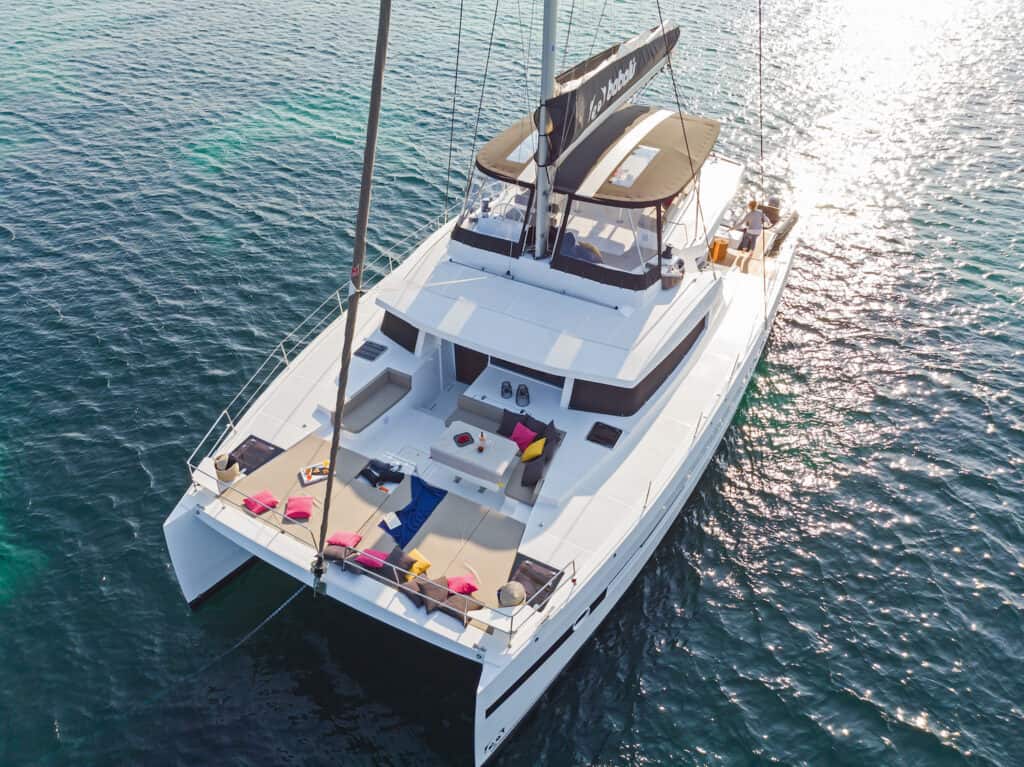
5. Anchor Bridal Setup

Catamarans are fitted with a bridle, attached to both bows and down to the anchor chain, resulting in a very stable position at anchor. What we found with our monohull was that because the bow acts as a sail (because of the high freeboard), the boat tended to sail at anchor in high winds. It sailed in one direction until the chain snatched and tacked over and sailed in the other direction, feeling like it might dislodge the anchor altogether. The catamaran on the other hand sits at anchor a lot more stable and doesn’t sail around as much.
6. Ease of Boarding on a Catamaran
Thank goodness we were much younger and more agile during our monohull days. Royal Salute and most monohulls of her generation or older, have high free-boards, making it quite a feat to get onto the boat from the dinghy. It was one of the most challenging things to do because unlike the more modern monohulls that have a scoop at the back, we had to climb up on the side of the boat to get on and off. We, of course rigged steps, etc. but it was always a hassle compared to the ease of getting on and off a catamaran from a dingy or from the water.
7. Shallow Draft Equals Better Anchorages
Catamarans have significantly shallower drafts than monohulls, allowing for safer anchorages closer to shore. Most catamarans in the 40-ft to 50-ft range draw between 3-ft to 4.5-ft, so they can anchor in places that a monohulls can not even consider. In the shallow waters of the Bahamas for example, the catamarans have a big advantage. We often anchor our own catamaran just a few feet away from a beach. It definitely allows one to be able to explore areas where the water is shallow without the fear of running aground.
The shallow draft also allows for emergency repairs in shallow water and even doing the bottom job when the tide goes out as we have done in places like Mtwapa Creek in Kenya, East Africa. The catamaran easily rests on her keels on the sand without help making it a breeze to do the “annual haul out” even in remote locations.
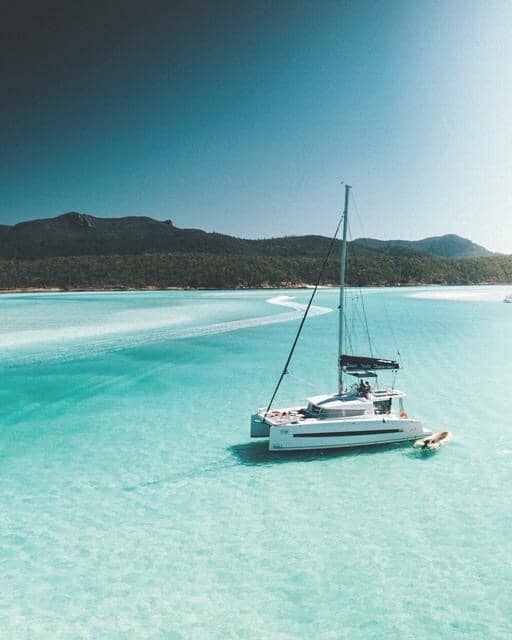
8. Dinghy Davits & Dinghy Size
All catamarans have a set of davits that make it very easy to raise and lower the dingy. Our monohull and most cruising monohulls do not have an efficient or easily accessible set of davits. This makes raising and lowering the dingy an elaborate production. Catamarans on the other hand, has davits systems easily accessible and some even have platforms to rest the dinghy on.
The lack of beam and difficulty of lifting the dinghy also limits the size and type of dingy that one can reasonably carry on a monohull. As we all know, the dingy is your transport to and from shore and diving or fishing spots, so the bigger and faster the dingy, the better off you are. A catamaran can carry both a heavier and bigger dinghy which makes the popular center consul dinghy so much more possible.

9. Interior Space and Comfort on a Catamaran
We sailed 32,000 NM on our 45-ft monohull, happy as clams, not realizing that sailing does not have to be done lying on your ear 24/7 while on passage or sitting knee-to-knee in the cockpit at anchor with your two other guests at the dinner table! One can liken sitting in a monohull cockpit to sitting in an empty Jacuzzi, you are always nice and close to the other folks.
Now that we are on our fourth catamaran, there are a few things that have become more evident to us than the incredible space and comfort of a catamaran, not only at anchor but also underway. The cockpit and living space in general are huge compared to a monohull, making for very comfortable and spacious living conditions. It feels more like you are at home, rather than just on a camping trip.
Knowing that one spends at least 90% of one’s cruising life at anchor, it’s important to have good open living space, which most modern cats nowadays offer. A lot of cats have walk around beds, lots of storage, every modern appliance including washer/dryer, etc. However, one has to fight the urge to fill the space if you want to keep the cat light and fast.

Sailing with guests onboard for extended periods of time, in close quarters can become claustrophobic but on a catamaran people are spread out and separated. With guests sleeping in one hull and the owners in another, catamarans offer much more privacy and separation. Some cats even have privacy doors that will close off the entire hull and has a separate entrance onto the deck, which really separates you from the guests completely.
There is very little heeling on a catamaran, so there is no need for hand grips and safety harnesses inside the boat. There is nothing better (and safer) than being able to walk from the cockpit into the living room (saloon) on one level or one step down at most. In a monohull, when heeling at a severe angle, you would have to claw your way from the companionway steps down to the living area, while fighting to stay upright, significantly tapping your energy.
Unless you hit extreme conditions, everything stays put on a catamaran reducing the anxiety before doing passages of having to stow and secure everything. This very issue makes a lot of cruisers reluctant to weigh anchor and explore more often. It is just too much effort to pack away all your stuff once comfortable in an anchorage!
One thing you will notice is that the stove on catamarans are not gimbaled like it is on monohulls and this should tell the story in itself. The stability and comfort on a catamaran is far superior. Cooking is easy and safer. I often open a nice cold beer, put it down to do something and forget about it only to find a warm beer later in the same place I left it. This is not something that happens on a monohull.
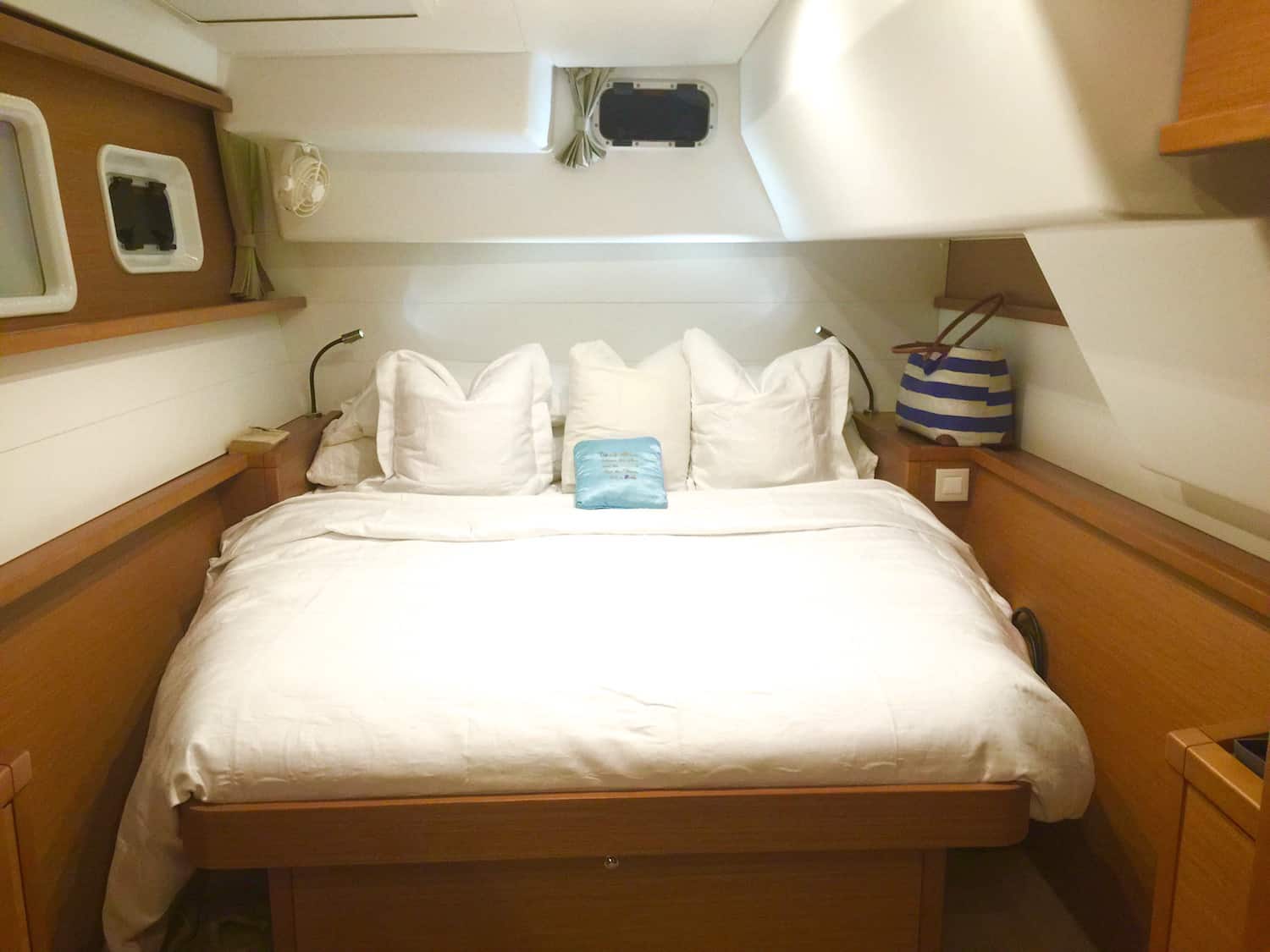
10. Redundancy on a Catamaran
Unlike monohulls, catamarans have a lot of critical redundancies. That of course means two hulls to clean and anti-foul, double the engine maintenance, etc. but having two of the critical equipment like engines for instance, outweighs the downside.
With two engines, if one fails you still have adequate propulsion to go anywhere. If by some fluke the second engine also fails, you have a full set of spares to fix at least one of them. Our friends once hit a sleeping whale off Tanzania, and when it dove, it hit the prop, bending it. They limped into the narrow channel on the one engine but at least they could make it to a safe harbor where we surveyed and repaired their damage.
We often only use one engine when motoring while making passage in order to conserve our fuel. The one engine is totally capable of moving the boat along at a good speed unless you are in heavy seas and you may need more power. Other than that we only use two engines to dock or maneuver the boat in close quarters.
Because there are two engines there are also two independent charging systems via the alternator on each engine. If one alternator goes out, there is still another complete charging system. There are two rudders and if one fails or falls off (as has happened to our friends on a monohull off Columbia, where they almost lost their boat) you have a second rudder that is completely capable of steering the boat by itself indefinitely. That holds true for several things on a catamaran!
11. Maneuverability
The engines are spaced far apart on a catamaran and it makes maneuvering much easier and more precise than monohulls, unless the monohull has a bow thruster. We did not have a bow thruster (not many monohulls do) and had to rely on prop-walk and using prop wash on the rudder. A modern catamaran can do a 360 turn on her own axis. A monohull cannot do this and have a bigger turning circle. However, a monohull under sail is much more maneuverable and certainly will tack a lot faster than a catamaran. The ease in maneuverability under engine on a catamaran in close quarters specifically, is vastly superior comparatively.
12. Rigging
Because of the beam on a catamaran the spinnaker pole has become unnecessary equipment. Hallelujah, I say. That pole on our monohull was a pain the behind and I always hated having to use it. On a catamaran, one can fly an asymmetrical cruising chute or spinnaker, using the bows to tack the clew or run a guy through a block so it is very much simplified, easier and safer.We also sail wing-on-wing with twin headsails when we sail downwind. We use our furling jib and furling Code Zero. It is as easy as one, two, three.
DISADVANTAGES OF A CATAMARAN
1. bridgedeck slamming.
One advantage most monohulls do have when underway is that they don’t slam. Catamarans with a low bridgedeck clearance can experience significant slamming in confused seas sailing upwind. This slamming can be quite disconcerting when you first experience it as we did on a Shuttleworth 44 design, our first ever catamaran experience, 20+ years ago. At times, it felt as though the boat was falling apart. Of course the boat was fine but nevertheless, the stress on the crew from the constant noise and discomfort was significant.
Monohulls don’t have a bridgedeck which means no slamming and are therefore a bit more comfortable than l ow bridgedeck catamarans when beating into severe confused conditions or “washing machine” conditions as we call it. Modern catamarans mostly have better bridgedeck clearance and the slamming is significantly less. However, not all cats have a good clear tunnel under the bridgedeck. Some manufacturers build beds into the bridge deck in order to make more space in the chest of the catamaran where the slamming occurs. These protuberances into the bridgedeck tunnel will likely increase slamming. So be mindful of that when selecting a catamaran. We currently own a Bali 5.4 and the bridgedeck clearance on this boat is more than adequate and the tunnel is clear. We therefor experience very little slamming compared to our Prout 45 that we previously owned (picture of sister ship below) with a much lower bridgedeck.
We Explain Bridgedeck Clearance
In the pictures below, the Bali 5.4 has very good clearance from the water to the bridgedeck and has a nice clean tunnel versus the very low bridgedeck of the Sunreef 50.

2. Sailing Downwind
Monohull spreaders are set at 90 degrees to the mast whereas a catamaran has to have backswept spreaders. The reason is that, on a monohull, there is a backstay and using this, plus the intermediates you can get a nice pre-bend in the mast (the pre-bend is to flatten out the main sail and allow for better performance).
On a catamaran with no back stay, you need to use the back swept spreaders and the diamonds to pre-bend the mast. The reason I point this out is because on a catamaran, if you want to broad reach or run, the mainsail cannot be let out all the way because the backswept spreader tips could punch holes in the fabric.
On a monohull, the spreaders are at 90 degrees so you can let the main and the boom out much further which is, of course, much more effective. This is one of the reasons it is better to broad reach and tack downwind on a catamaran.
Whether a monohull or multihull, sailing dead downwind doesn’t usually make great VMG. Therefor a regular cruising cat, much like a monohull, needs a lot of sail area and has to sail deep downwind if it is to achieve a decent speed made good (VMG). This video demonstrates how we achieve this by sailing wing-on-wing downwind.

It is more difficult to find a dock either as a transient or a permanent slip for a catamaran in general because of the wide beam. But this is changing fast and will soon not be too much of an issue. In the USA dockage is charged by the length of the boat in feet, so there is no disadvantage there but, in some places, (the Mediterranean for example), dockage is charged at length times one and a half because of the additional beam.
Since the catamaran is stable at anchor, we mostly anchor out. We have more privacy, a better breeze and usually a stunning view.We have a nice dinghy with a good outboard engine and is big and comfortable enough to get to shore fast and together with the modern conveniences like the generator, watermaker and washer/dryer, docking becomes a non-issue.
It is definitely more difficult to find a travel lift with enough beam for a catamaran for a haulout, while, for a monohull, there are absolutely no problems anywhere. The wide beam of cats also greatly limits the number of shipyards that can haul them out. Most catamarans over 40-ft must be hauled out with a 50-ton travel lift. This not only increases the cost of the haulout, but greatly limits the choice of the shipyards for repairs and maintenance. With limited choice, prices are high for shipyard services.
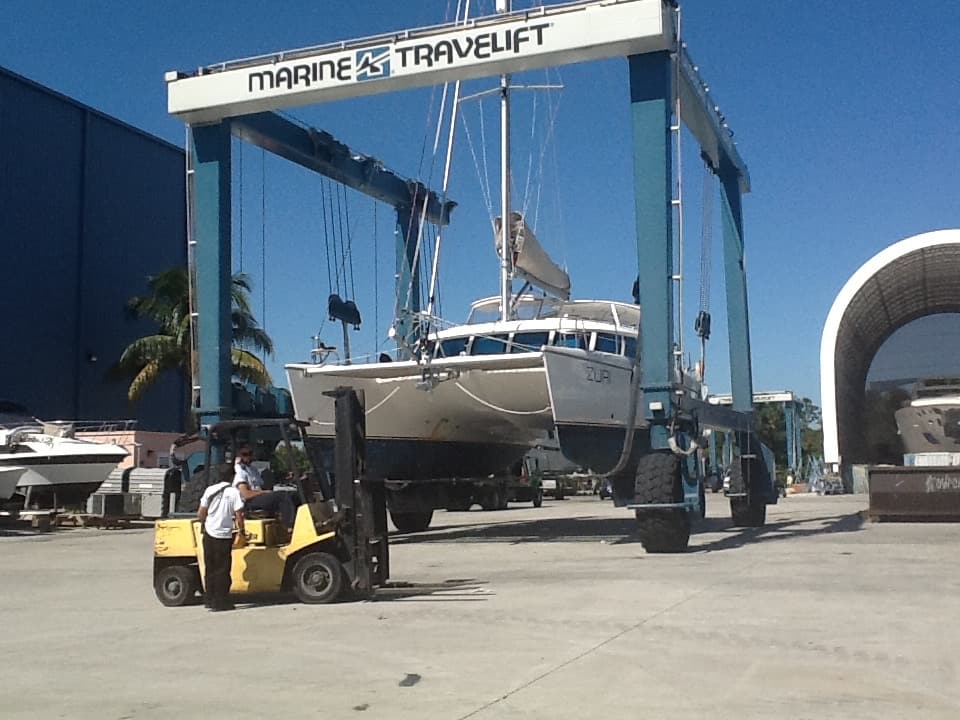
Catamarans do tend to have a lot more windage than monohulls. This can be an issue especially when maneuvering in close quarters with a strong wind. But I have found that, provided the engines are powerful enough for the size of catamaran, that twin engines negate this problem. Also, many modern large catamarans now have a bow thruster fitted. It is super easy to dock.
The cost of getting into a catamaran is much higher than that of monohulls. That could put a serious dent in your cruising kitty or require you to put your dream on hold a little longer. Pre-owned monohulls on the other hand are very cheap to buy comparatively, because the supply presently far outweighs the demand.
Catamarans are in high demand and they typically hold their value much better and longer and the trend is now heavily in favor of the catamaran market. When prospective buyers contact us for catamarans under $250,000 the choices are very limited and catamarans under $100,000 is near impossible to buy. In this case, your best bet is to go with a monohull unless you go with much older boats like the Prouts or the less expensive Geminis.
Our Own Catamarans & Monohulls
FYI: Royal Salute , a Bruce Roberts 45 monohull, was the first boat we owned and sailed approx. 30,000NM on. Mythral, a Seafarer 30, was our “toy boat” while we were waiting for our catamaran to be built. Even though this classic little monohull sailed around the world, it didn’t have much in modern conveniences like running water. Siyaya was an Island Spirit 40 catamaran that we sailed from Cape Town to Florida on and then taught live-aboard sailing classes for several years. Zuri I was a Prout 45, a beautifully crafted catamaran but by today’s standards is considered old technology. Our Lagoon 450 SporTop ( Zuri II ) is a fantastic live-aboard catamaran. We lived and taught aboard her for three years but sold her last year and we currently own a Bali 5.4 ( Zuri III or Z3 as we call her now). Read about our various boats .

CONCLUSION: CATAMARAN vs MONOHULL
We were dyed in the wool monohull sailors for 15+ years. We loved the pretty lines of monohulls, the sailing ability and what we believed at the time to be much safer vessels. However, now that we have been avid catamaran enthusiasts, we simply can never go back to monohulls. Catamarans have come of age and with modern technology have overcome most objections that sailors of old had against them. They are well designed and built, are safe, and we simply love that they sail fast and upright. There is not a whole lot to dislike about a catamaran when you live aboard. We have weighed all the pros and cons of catamarans and found that the pros far exceed the cons. We made the change to a catamaran and do not regret it one bit!
We hope that this article will clear things up for all the prospective catamaran owners out there.
Contact us if you have any questions regarding catamarans, Fractional Yacht Ownership or our Charter Management Programs .
Estelle Cockcroft
Join our community.
Get the latest on catamaran news, sailing events, buying and selling tips, community happenings, webinars & seminars, and much more!
4 thoughts on “Catamaran vs. Monohull: We Changed, Should You?”
I read that the engineering on the catamarans were improved over the years. Whats the oldest year would you recommend designwise?
Scott, my apologies for the late reply. We’ve been traveling in Africa. Anyway, catamarans have come a long way and improvements in technology is happening at lightning speed. I reckon that even the older model catamarans are good. It depends on what your needs are. If you want something a little better performance wise, I would go for something no older than 15 years.
After buying a catamaran what is the difference in expense of a catamaran vs a monohull. Many articles state that not only the initial cost of a catamaran is more it the operating cost as well.
Hi Todd, it is more expensive. The annual dockage and haul out as well as maintenance will be more expensive. You obviously have two engines to maintain and various other pieces of equipment to service in both hulls. While there is more equipment there is also more redundancy and of course you have the comfort factor. So, depending on your situation, it’s probably worth it.
Leave a Comment Cancel Reply
Your email address will not be published. Required fields are marked *
Save my name, email, and website in this browser for the next time I comment.
Recent Posts

Top 10 Reasons to Sell (and Sail) Your Catamaran in Annapolis, MD
We have a new home in Annapolis! The office is located in Annapolis, Maryland

Top 10 Reasons to Sell (and Sail) Your Catamaran in Texas
Our Texas Office is located in the Watergate Marina Center in Clear Lake Shores,
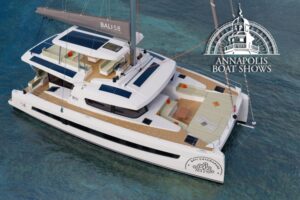
Annapolis Boat Show 2024
Meet with our team! Want to learn more about the Bali and Catana

Exploring the Catana OC 50 Catamaran: A Comprehensive Overview
The Catana OC 50 Catamaran, the latest addition to the Catana Ocean Class series,

For more than 30 years, we have been a part of the catamaran community and created Catamaran Guru™ to encourage and educate all the aspiring sailing out there. We understand the dream of traveling the world by catamaran and created a one-stop-shop to make that dream a reality for you.

- Stephen & Estelle
- Testimonials
Get Started
- Yacht Sales
- Used Yachts
- Charter Management
- Boat as Business Programs
- Seminars & Events

Chesapeake Bay Magazine
The Best of the Bay
PHOTOS: Five Rescued from Capsized Superyacht in West River

The partially-capsized 122-foot yacht Lovebug sits with its starboard side down in the water. Photo: Jodi Scheffler
It was a shocking sight to many on the Bay over the weekend: a 122-foot-long yacht, laying on its side in a high-traffic part of the West River.
Now, towboat operators are making a plan to remove the superyacht from its unfortunate resting place.
The superyacht Lovebug , which had been spotted docked in Annapolis earlier in the week and on the move in the Bay, partially capsized at the mouth of the West River around 12:30 p.m. Saturday. Maryland Natural Resources Police (NRP) responded to reports of a vessel taking on water.
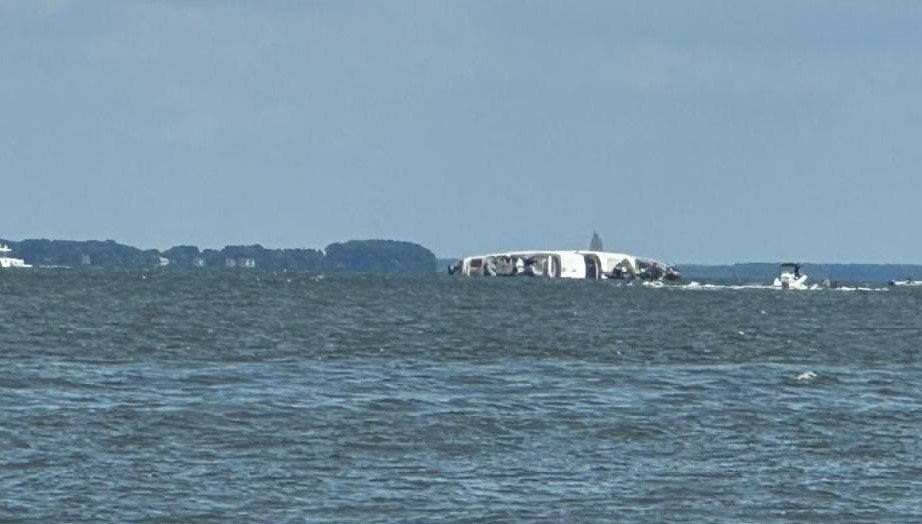
Fellow boaters said they heard the call on VHF Channel 16, but had no idea it was referring to a 122-foot-yacht.
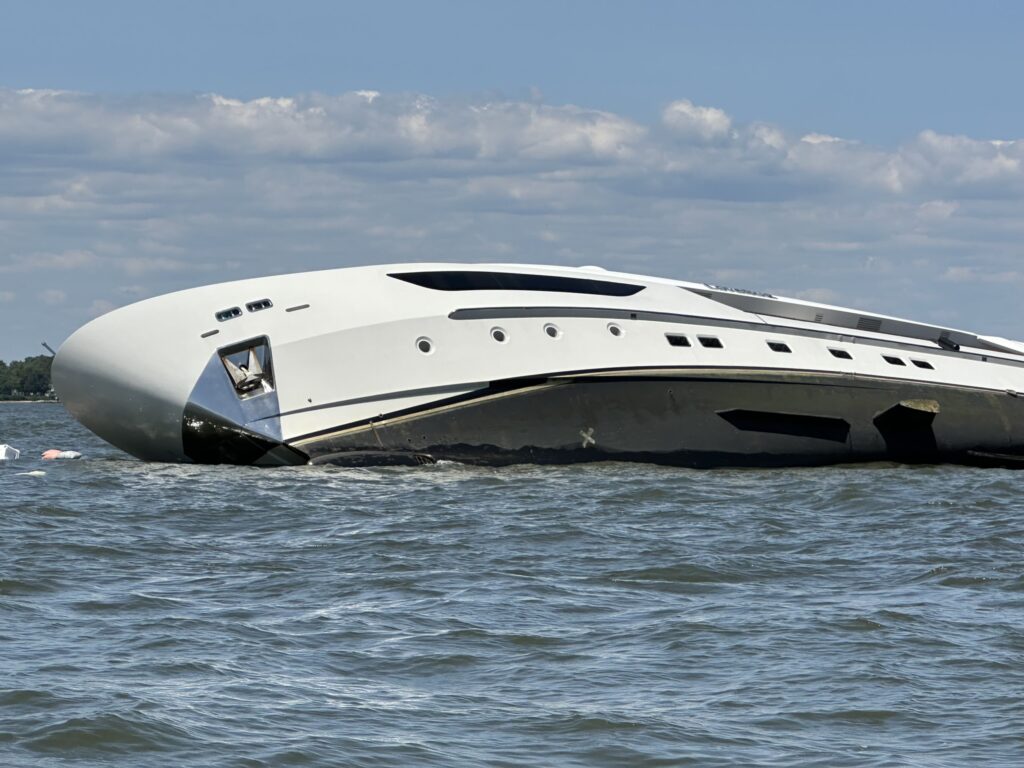
When Natural Resources Police arrived, they found five people on board. Police tell us they included a captain, three crew members and one passenger. All five were transported to shore safely and didn’t need any medical treatment.
The Coast Guard also responded to the incident.
NRP is investigating the cause of the incident and a spokesman says they “cannot confirm any speculation at this time,” despite plenty of theories about whether the yacht was intentionally grounded after taking on water. The vessel draws eight feet, and the river channel is known to drop off quickly.
Now, TowBoatUS Annapolis is making a plan for salvage. Company spokesperson Christine Plummer tells Chesapeake Bay Magazine, “We will approach the planning and execution with care for the environment and care for the owner’s property.”
They are still planning and have not yet released a timeline for removing the yacht.
In the meantime, TowBoatUS asks boaters to steer clear. “24-hour security is in place and we ask boaters to not approach and to pass at slow-bell,” says Plummer.
Word of the capsized superyacht spread quickly among Anne Arundel County boaters who passed by the scene. The vessel is a head-turner, so many had checked it out earlier in Annapolis and on the Bay. CBM follower David Driftmier sent us this “before” shot of the Lovebug docked on Spa Creek (within view of the Chesapeake Bay Magazine offices).
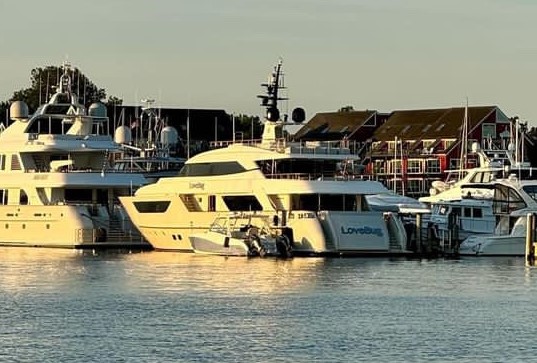
According to a previous listing for the boat, the Lovebug is an Italian boat built by Sanlorenzo in 2010 and updated in 2017. It sleeps 11 guests in five staterooms and can accomodate seven or eight crewmembers. It boasts zero speed stabilizers, a flybridge sundeck with Jacuzzi, tender/jet ski garage, and a full-beam master stateroom with a full bean master bath and owner’s office.
We continue to follow this developing story and will update it as we learn more from investigators.
Related Stories

Anacostia River Storm Drains Get Beautified in Mural Contest
Who says that stormwater management can’t be beautiful? Thanks to a talented group of local
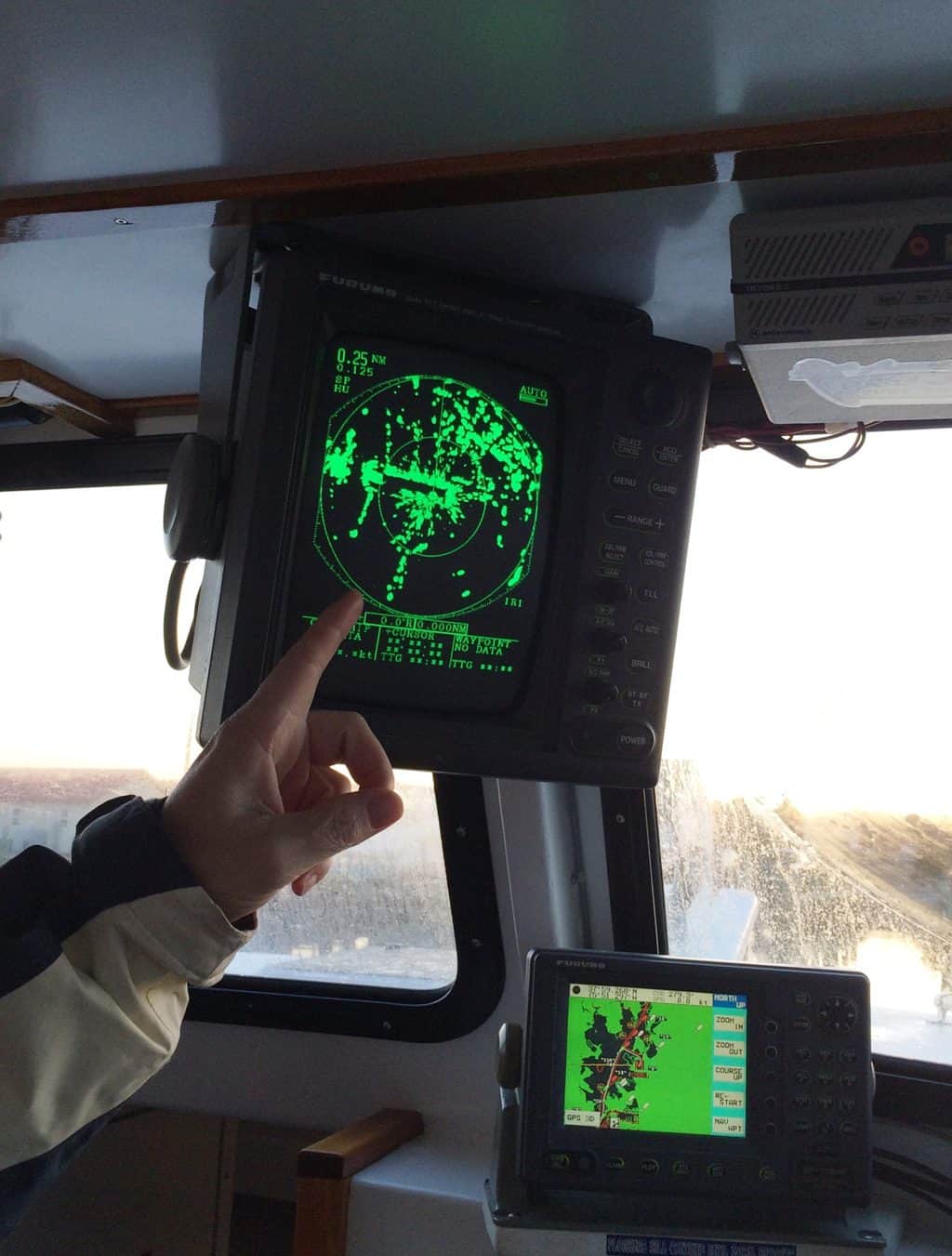
Navigation Workshop for the Tech-Challenged Offered
As the Chesapeake Bay sees more new (and upgrading) boat owners going into the spring,
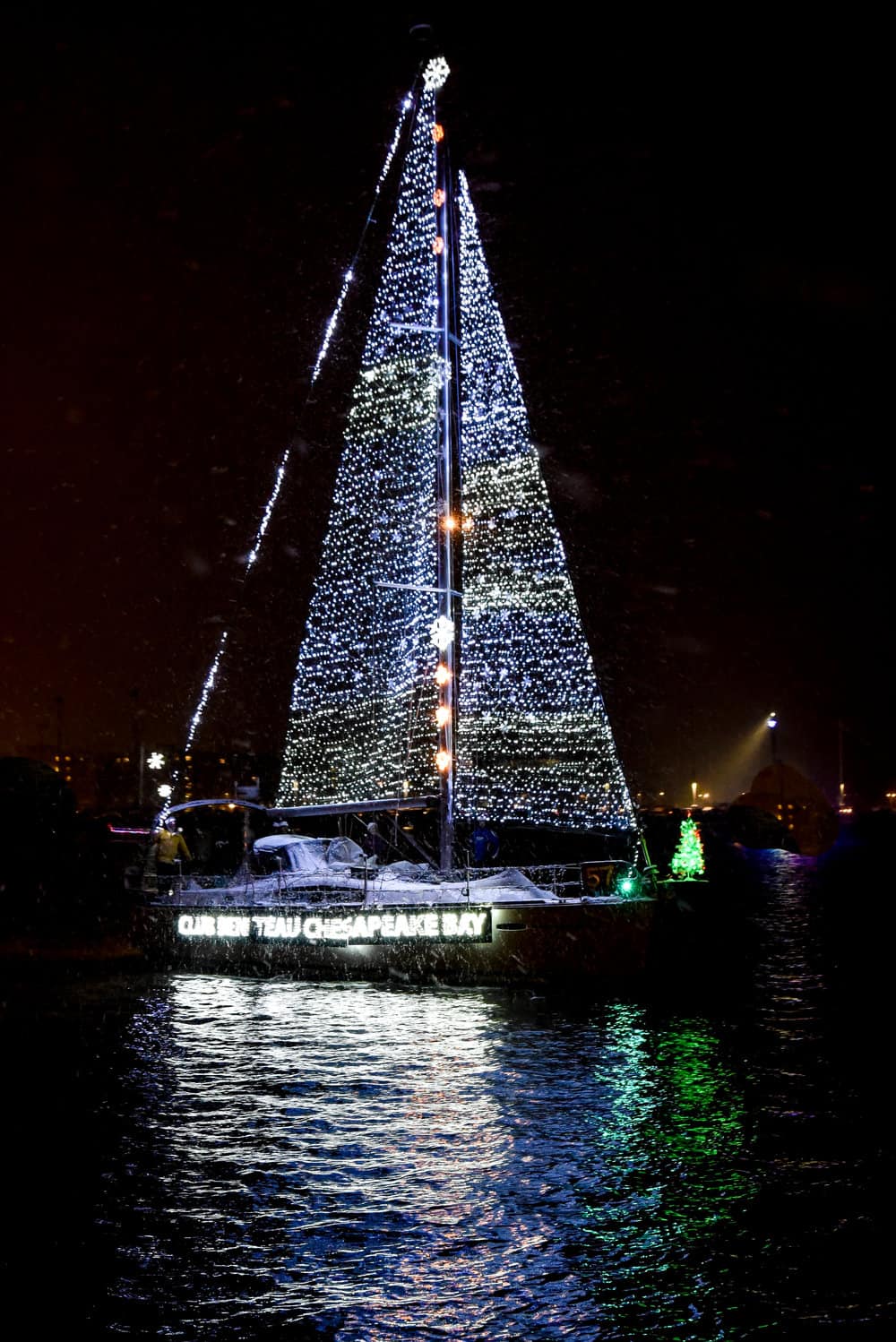
Boat Decorating Class Kicks off Lights Parade Season
The Eastport Yacht Club Lights Parade is a treasured holiday tradition in Annapolis, and believe
Video shows moments before superyacht went down in storm off Sicily
Newly released video captures a luxury superyacht being battered by a violent storm before it suddenly sank off Sicily with 22 people aboard Monday.
The grainy images obtained by NBC News and other outlets were recorded on closed-circuit television not far from where the Bayesian was anchored, about a half-mile from the port of Porticello, on Sicily’s northern coast .
The yacht's 250-foot mast, illuminated with lights and lashed by the storm, appears to bend to one side before it finally disappears and is replaced by darkness.
The speed with which a yacht built to handle the roughest seas capsized stunned maritime experts.
“I can’t remember the last time I read about a vessel going down quickly like that, you know, completely capsizing and going down that quickly, a vessel of that nature, a yacht of that size,” said Stephen Richter of SAR Marine Consulting.
British tech tycoon Mike Lynch and five of the 22 other people who were aboard the 184-foot vessel remain unaccounted for and are believed to be trapped in the Bayesian’s hull, nearly 170 feet underwater.
Officials confirmed Monday that at least one person, the ship’s cook, had died.
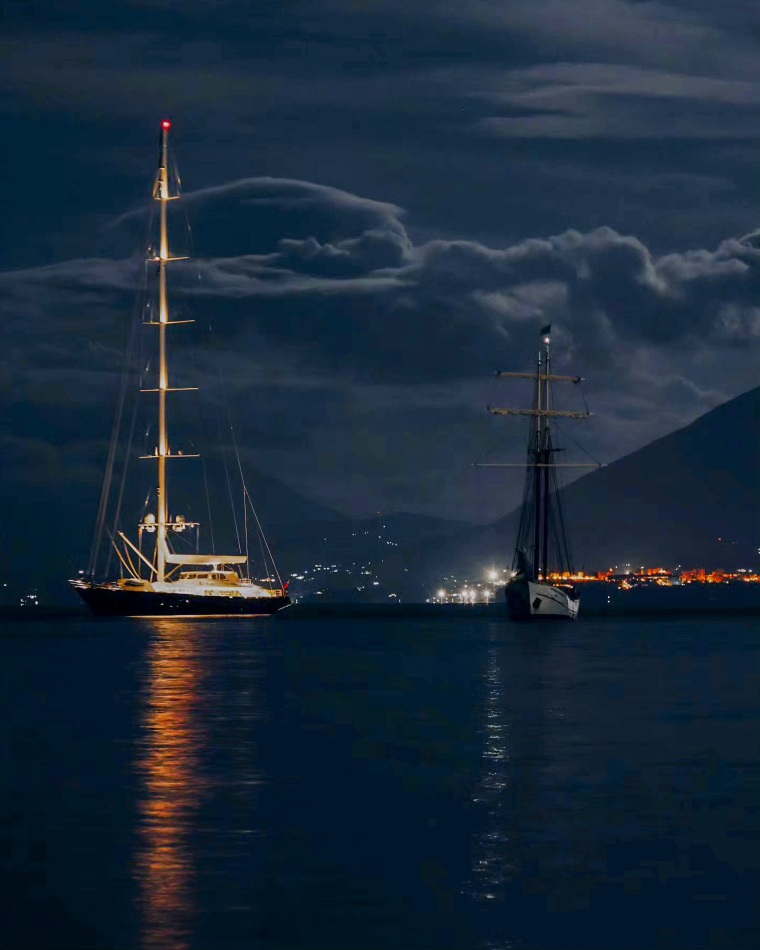
Superyachts like the Bayesian, which had been available for charters at a rate of $215,000 a week, are designed to stay afloat even as they are taking on water to give the people aboard a chance to escape, Richter said.
“Boats of this size, they’re taking passengers on an excursion or a holiday,” Richter said. “They are not going to put them in situations where it may be dangerous or it may be uncomfortable, so this storm that popped up was obviously an anomaly. These vessels that carry passengers, they’re typically very well-maintained, very well-appointed.”
Built by Italian shipbuilder Perini Navi in 2008, the U.K.-registered Bayesian could carry 12 guests and a crew of up to 10, according to online specialist yacht sites. Its nearly 250-foot mast is the tallest aluminum sailing mast in the world, according to CharterWorld Luxury Yacht Charters.
On Tuesday, Italian rescue workers resumed the search for Lynch and the five other passengers still missing: Lynch’s 18-year-old daughter, Hannah; Morgan Stanley International Chairman Jonathan Bloomer and his wife; and Clifford Chance lawyer Chris Morvillo and his wife.
“The fear is that the bodies got trapped inside the vessel,” Salvatore Cocina, the head of civil protection in Sicily, told Reuters .
The Bayesian is owned by a firm linked to Lynch’s wife, Angela Bacares, who was one of the 15 people rescued Monday after it capsized.
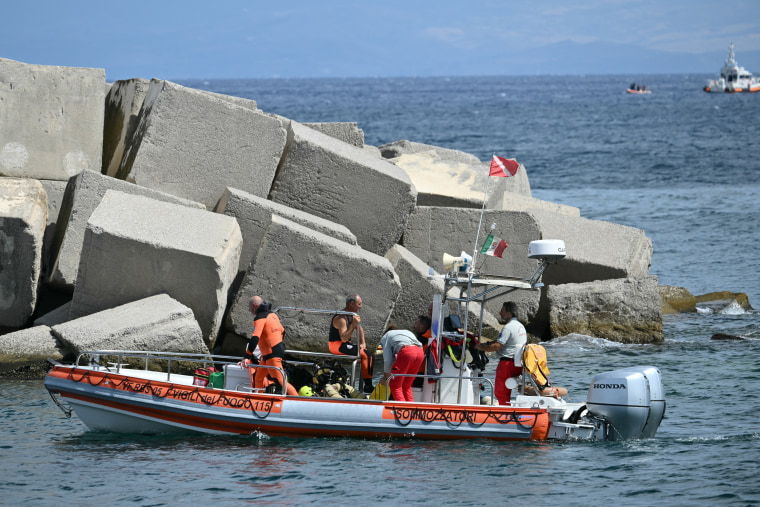
“It’s extremely rare for a boat of this size to sink,” Richter said.
What’s not rare is the kind of storm that sank it , said Simon Boxall, senior lecturer in oceanography at Britain’s University of Southampton.
“People assume the Mediterranean is this rather calm and passive place that never gets storms and always blue skies,” Boxall said. “In fact, you get some quite horrendous storms that are not uncommon at this time of year.”
The president of Italy’s meteorological society has said Monday’s violent storm may have involved a waterspout, essentially a tornado over water, or a downburst, which occurs more frequently but doesn’t involve the rotation of the air.
Luca Mercalli, president of the Italian Meteorology Society, also said recent temperatures may have been a factor.
“The sea surface temperature around Sicily was around 30 degrees Celsius [86 Fahrenheit], which is almost 3 degrees more than normal,” Mercalli told Reuters. “This creates an enormous source of energy that contributes to these storms.”
The Mediterranean sailing vacation was designed to be a celebration for Lynch, who two months ago was acquitted by a San Francisco jury of fraud charges stemming from the 2011 sale of his software company Autonomy to Hewlett-Packard for $11 billion.
Prosecutors alleged that Lynch, dubbed “Britain’s Bill Gates,” and Autonomy’s vice president for finance, Stephen Chamberlain, had padded the firm’s finances ahead of the sale. Lynch’s lawyers argued that HP was so eager to acquire Autonomy that it failed to adequately check the books .
Lynch had taken Morvill, who was one of his defense attorneys, on the luxury trip.
Chamberlain was not on the Bayesian.
In what appears to be a tragic coincidence, a car struck and killed Chamberlain on Saturday as he was jogging in a village about 68 miles north of London, local police said.
“Steve fought successfully to clear his good name at trial earlier this year, and his good name now lives on through his wonderful family,” Chamberlain’s lawyer, Gary Lincenberg, said in a statement .
Henry Austin reported from London and Corky Siemaszko from New York City.
Henry Austin is a senior editor for NBC News Digital based in London.
Corky Siemaszko is a senior reporter for NBC News Digital.
Spectacular footage shows US catamaran flipping over and capsizing during pre-race in Bermuda
Topic: Sport
The crew of the catamaran are ejected from the vessel during the Bermuda event.
The crew of a catamaran that flipped during the pre-race at a Bermuda event escaped unharmed, as vision showed the US team being flung through the air.
The F50 capsized during the third and final practice race, and while the crew were unhurt in the spectacular moment, the team was forced to withdraw from the race due to the damage sustained to the catamaran.
Data from the vessel showed that wing trimmer Victor Diaz de Leon pressed a button by accident, which inverted the wing of the boat.
"While operating the wing, I chose the wrong function on my control panel, which caused our boat to flip. It was very scary and I'm thankful all my teammates are safe," Diaz de Leon said after the incident.
Team CEO and strategist Mike Buckley said mistakes can happen.
"We compete as a team and whatever the outcome is — whether it's what we want — we win and lose as a team and we learn from it," he said.
The ABC of SPORT
What we know about the capsized superyacht off the Sicilian coast
Officials were caught off guard by ferocity of storm that sank ship.
Social Sharing
During a vicious storm before dawn on Monday, a superyacht carrying nearly two dozen people suddenly capsized while still anchored and sank within sight of a small Sicilian fishing village. A Canadian-born man who had been working as the on-board cook died, and several others are still missing.
The authorities have yet to determine what caused the yacht to capsize, but here's what we know about the ship.
Who was on board?
Twenty-two people — 10 crew and 12 passengers — were on board the anchored ship when it went down off the coast of Porticello, less than 20 kilometres from the Sicilian capital of Palermo.
They included one of Britain's most recognizable tech entrepreneurs, Mike Lynch, his teenage daughter, his wife, one of his lawyers as well as the president of Morgan Stanley International.
Fifteen people were rescued, including Lynch's wife, Angela Bacares. Lynch and his 18-year-old daughter, Hannah, are among the six people unaccounted for. Luca Cari, a spokesperson for the local fire rescue service, said they are believed to be inside the hull of the sunken ship.
The Italian coast guard said the missing included people with British, American and Canadian nationalities.
A passenger ship anchored nearby, the Sir Robert Baden Powell, found some of the survivors on a life raft and took them on board before the coast guard picked them up.
Rescuers later recovered the body of Recaldo Thomas , the ship's cook, who was born in Canada and lived in Antigua.

'It was a big disaster,' boater says of storm that capsized luxury yacht
Salvo Cocina of Sicily's civil protection agency said the missing include: Jonathan Bloomer, chairman of Morgan Stanley International, and his wife as well as Chris Morvillo, one of Lynch's lawyers, with the firm Clifford Chance, and his wife.
Cocina said the crew and passengers were from a variety of countries, including France, Germany, Ireland, Myanmar, the Netherlands, New Zealand and Spain.
How bad was the storm?
Officials had expected poor weather, but the severity of the storm caught them off guard.
The Italian Air Force's Centre for Aerospace Meteorology and Climatology registered intense lightning activity and strong gusts of wind in the area when the ship sank, according to its director. Col. Attilio Di Diodato told the New York Times he could not rule out that it had been a waterspout — rotating columns of water that can form over the ocean.
Separately, Cocina told journalists that a waterspout had hit the area overnight.
"It could be that the mast broke or the anchor at the prow pulled it" as the mini tornado hit, fisherman Fabio Cefalu, who helped look for survivors, told The Associated Press.
Karsten Börner, the captain of the nearby ship that helped survivors, said he struggled to control his own ship during what he described as very strong winds.

'The ship behind us was gone,' says captain who rescued yacht passengers
A meteorologist said there was a higher risk of extreme weather in the Mediterranean Sea because recent storms and heavy rainfall after weeks of intense heat affected the water's temperature.
"The sea surface temperature around Sicily was around 30 C, which is almost three degrees more than normal. This creates an enormous source of energy that contributes to these storms," Luca Mercalli told Reuters.
"We can't say that this is all due to global warming but we can say that it has an amplifying effect."
What kind of yacht was it?
The Bayesian was 56 metres long — about half the length of an NFL football field. Perini, an Italian firm, built the ship in 2008.
It was named for English statistician Thomas Bayes, whose theories of probability influenced the software Lynch developed and with which he made his fortune.
Refitted in 2020, the ship was notable for its single 75-metre mast — one of the world's tallest made of aluminum. It was lit up at night, including just hours before it sank.
The boat left the Sicilian port of Milazzo on Aug. 14. It was last tracked east of Palermo on Sunday evening with a navigation status of "at anchor," according to vessel tracking app Vesselfinder.
According to the shipspotting.com website, the boat was owned by a firm called Revtom Limited. Lynch's wife is named as the sole shareholder of the firm on company documents.
Where is the wreck now?
Police divers spent the day trying to reach the hull of the ship, which was resting where it had been anchored at a depth of 50 metres off Porticello.
Rescuers returned to the site after 10 p.m. to see if it would be possible to search through the night, when weather conditions were expected to worsen, said Luca Cari with the fire rescue service.
The U.K. Marine Accident Investigation Branch is deploying a team of four inspectors to Italy to conduct a preliminary assessment.
With files from Reuters and The Associated Press
Related Stories
- Canadian dead, several others missing after superyacht capsizes off Sicilian coast
- How did the superyacht Bayesian sink? Experts say weather was just one factor
- Captain of sunken superyacht placed under investigation
Watch CBS News
Divers recover remains from tech mogul Mike Lynch's family's superyacht that capsized off Sicily
By Tucker Reals , Anna Matranga
Updated on: August 21, 2024 / 7:44 PM EDT / CBS News
Divers searching the wreck of a superyacht owned by the family of a British tech mogul that sank Monday off the coast of Sicily in southern Italy were working Wednesday to recover the remains of most of the six people left missing after the accident, Sicily's civil protection agency confirmed to CBS News. Two bodies had been brought to shore in Porticello, near Palermo, and two more were in the process of being brought ashore.
Five bodies have been found, and one person was still missing, reported the AP, as searches concluded for the day.
Rescue efforts have been challenging because the Bayesian is now lying on the seabed at a 90-degree angle, at a depth of 164 feet. Divers can only spend 10 minutes at the dive site before having to resurface to avoid decompression sickness, or "the bends."
Britain's Telegraph newspaper reported that the bodies of Mike Lynch, the technology entrepreneur , and his 18-year-old daughter were among the remains recovered Wednesday, but the civil protection chief would not confirm that report to CBS News.
Six people, including Lynch and his daughter, were left missing after the vessel sank in a violent storm early Monday morning. One man, the Bayesian superyacht's chef, was found dead soon after the boat capsized.

Fifteen passengers and crew managed to escape the accident, including Lynch's wife, who owned the vessel.
Along with Lynch and his daughter Hannah, the technology mogul's American lawyer Chris Morvillo, a former assistant district attorney in New York, his wife Neda, and British banker Jonathan Bloomer, chairman of Morgan Stanley International, were also missing.

Lynch was acquitted in June of fraud charges in the U.S. that could have landed him in prison for decades. Lynch's co-defendant in that fraud case, who was also acquitted, died Saturday after being hit by a car while out jogging in England.
Questions have intensified on how the state-of-the-art vessel could have sunk in mere minutes, while boats nearby were largely unaffected. Vessels of this caliber have numerous safety measures, including watertight sub-compartments designed to keep them from sinking quickly even if taking on water.
Italian prosecutors are questioning the crew and passengers in an effort to reconstruct events, including the ship's captain, 51-year-old New Zealander James Catfield.
One possible culprit is the ship's keel, a fin-like structure designed to prevent the boat from being blown sideways by the wind, thus giving the boat greater stability. The Bayesian had a retractable or lifting keel, which could be retracted to 4 meters (useful to enter a shallow harbor) or extended to 10 meters. If the keel had been up, it is possible that fierce winds could have caused the ship to capsize.
When asked whether divers had discovered that the Bayesian's keel was indeed up, a spokesman for the Italian Coast Guard told CBS News that it was up to the prosecutors to answer that question.
- Boat Accident
Tucker Reals is CBSNews.com's foreign editor, based in the CBS News London bureau. He has worked for CBS News since 2006, prior to which he worked for The Associated Press in Washington D.C. and London.
More from CBS News

Sunken yacht's captain, 2 crew reportedly under investigation in Italy

Italian grandma prays, drinks puddles to survive 4 nights lost in woods
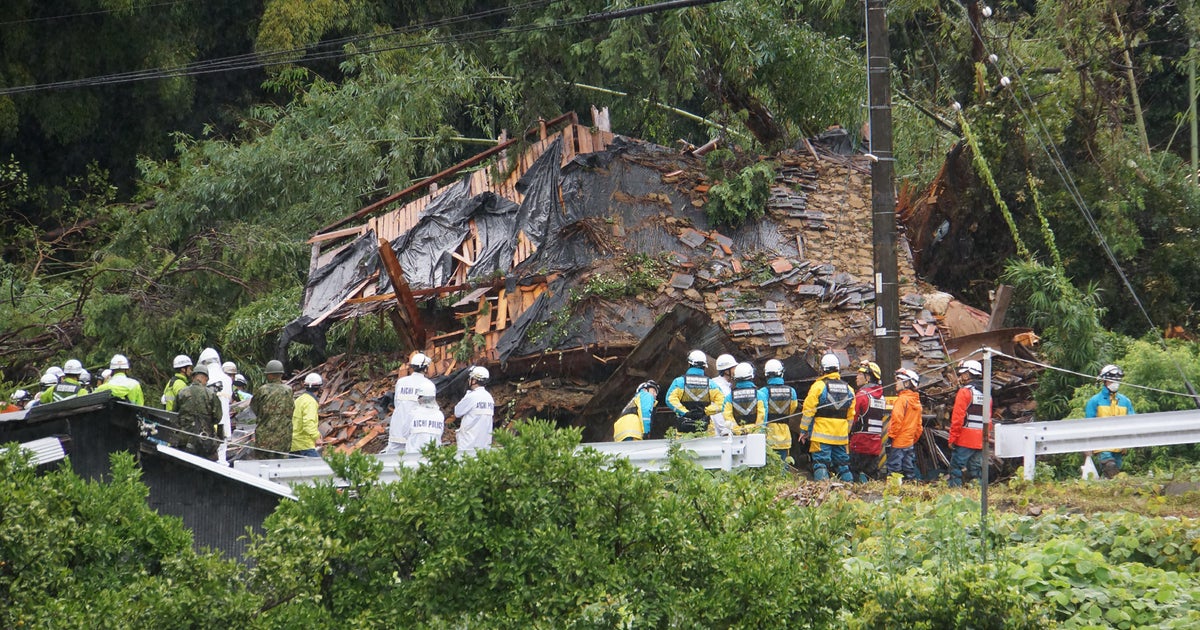
Massive storm Shanshan blamed for 3 deaths as it drenches Japan

Details emerge after Viking ship replica sinks, killing U.S. woman
Local News | LoveBug, 103-foot capsized yacht, raised from…
Share this:.
- Click to share on Facebook (Opens in new window)
- Click to share on Twitter (Opens in new window)
Capital Gazette eNewspaper
Local News | LoveBug, 103-foot capsized yacht, raised from water ahead of towing to New Jersey

Donjon Marine Co., the New Jersey-based firm that has worked to raise the vessel over the last two weeks, plans to begin towing the yacht north through the Chesapeake Bay and the Chesapeake & Delaware Canal to the mouth of the Maurice River in New Jersey Tuesday morning, said Steven Newes, the company’s senior vice president.
The salvage team will tow the LoveBug alongside the Farrell 256, a 200-foot crane barge, for safety, as the yacht is a “dead ship,” or a vessel without power, he said. Once it reaches the mouth of the Maurice River, the yacht will be handed over to a smaller vessel for transport to a shipyard along the river. Delivery is anticipated by Wednesday evening although which shipyard the LoveBug will end up at is unclear.
As salvage efforts wrap up, the Coast Guard has established a temporary safety zone for the mouth of West River within 200 yards of the LoveBug. Vessels will not be allowed to enter the zone unless authorized through Aug. 30, according to a notice posted Monday on the Federal Register .

The Farrell 256 and a second crane barge, the 250-foot Columbia NY, have worked to free the yacht from the muddy bottom of the West River. The LoveBug had settled into the mud “quite a bit,” Newes said, complicating efforts to place slings underneath the yacht to lift it.
Salvors’ progress lifting the LoveBug from the shallow waterway could be seen Friday and Saturday as the rear half of the yacht, underwater for weeks, emerged. By Friday evening, the yacht’s name on its transom was visible above the waterline, and by Sunday morning, only a small portion of the deck at the back of the yacht was underwater.
Once the yacht was lifted, salvors found mud inside. The mud needs to be removed to patch the yacht and “render it safely afloat” for towing, Newes said.
Until salvage crews pulled the LoveBug from the water, the yacht had remained aground in the same location between Beverly Beach and Shady Side for almost four weeks. Though the yacht was originally resting on its starboard, or right side, it rolled some prior to salvage beginning.
The Italian-built yacht was sailing south on the Chesapeake Bay from Annapolis on July 27 when it began to tip over. The Coast Guard received a mayday call at 12:36 p.m., but by the time crews arrived, the five people onboard had been rescued by a good Samaritan and a nearby towboat. Paramedics tended to two of the passengers, according to the Anne Arundel County Fire Department, but both declined to be treated.
The LoveBug, which cost between $110,000 and $125,000 to charter for a week, was not operating as a charter when it overturned, said Hunter Dortenzo, a Natural Resources Police spokesperson.
Though VesselFinder, a marine traffic site, indicated the LoveBug is owned by Bees Honey LLC, a limited liability company based in the Marshall Islands, Federal Communications Commission records show otherwise.
The yacht’s shipboard radio station license is registered to Jabulani Charter Florida, a Florida-based limited liability company with a Rockville mailing address. The licensee should be the vessel owner, according to an FCC spokesperson. Efforts to reach the person listed as the licensee were unsuccessful.
The Natural Resources Police and the National Transportation Safety Board are conducting separate investigations into what happened to the yacht.
More in Local News

Environment | Naval Academy’s Farragut Sea Wall repairs completed after nearly two years

Mr. Fix A Flat helping kids in Robinwood | PHOTOS

Crime and Public Safety | Police arrest man 18 months after Laurel roadside killing

Naval Academy Farragut Sea Wall ribbon cutting | PHOTOS
How did the superyacht carrying tech tycoon Mike Lynch sink off Sicily?
Lynch’s was among five bodies retrieved by divers on Wednesday after the Bayesian sank, according to reports.

Five bodies were retrieved on Wednesday, and a sixth on Friday , by divers searching for those missing from the superyacht which sank off the Sicilian coast in the Mediterranean. The bodies found include British tech tycoon Mike Lynch , the UK’s Telegraph reported. The bodies have not been formally identified by the authorities yet.
It is understood that they were retrieved from inside the sunken yacht, which is reported to be lying on its side on the sea bed at a depth of 50 metres
Keep reading
One dead, six missing after luxury superyacht capsizes off sicily coast, luxury yacht sinks off sicilian coast, uk extradites autonomy co-founder mike lynch to us, how serious are the wildfires near athens, greece.
This brings the total death toll to seven; one person, reported to be the chef from the yacht, was confirmed dead on Monday.
The yacht capsized on Monday at about 5am (03:00 GMT) after it was hit by stormy weather caused by a “waterspout” – or mini tornado – according to Italian authorities.
The cruise had reportedly been undertaken to celebrate the acquittal of Lynch in a fraud trial in the United States in June.
His co-defendant in the trial, Steve Chamberlain, who was also acquitted in June, was killed after being hit by a car on Saturday.
Here’s what is known so far about the yacht, those on board and who died or were still missing after it sank.

Who was on the superyacht which sank?
According to the Italian coastguard, the 56-metre-long (184 feet) British-flagged yacht, called the Bayesian, was carrying 22 people, including 10 crew members.
One person has been confirmed dead after rescuers located a body on Monday at a depth of about 50 metres (164 feet), the AFP news agency reported. Officials have not yet given the name of the deceased but Italian media reported that he was the yacht’s chef.
AFP reported on Tuesday that divers had spotted a second body inside the sunk boat, quoting a source close to the search operation. Authorities have not confirmed it yet, though.
While not all the names of the six missing passengers were not made public officially, they were understood to include:
- Mike Lynch, 59, a British-Irish technology businessman who co-founded British tech company Autonomy in 1996 and was once likened to Microsoft founder Bill Gates; he earned a PhD from Cambridge University
- Hannah Lynch, 18, Mike’s daughter, who had just completed her final school exams and was due to begin a degree in English at the University of Oxford this September
- Jonathan Bloomer, the 70-year-old British chairman of Morgan Stanley bank and the Hiscox insurance company, was confirmed as missing by Hiscox CEO Aki Hussain
- Judy Bloomer, Jonathan’s wife, was also confirmed as missing by Hussain
- Chris Morvillo, from British international law firm Clifford Chance, was confirmed to be missing by Salvatore Cocina, head of the Civil Protection in Sicily
Fifteen people, including Lynch’s wife, Angela Bacares, were rescued. Among others rescued were Charlotte Golunski, 36, a board director at Luminance, a software startup founded by Lynch; her husband, James; and their one-year-old daughter, Sophie. Golunski is understood to have kept her daughter alive by holding her above her head while she was in the water.
All those rescued are in stable condition, although eight of them have been hospitalised, according to Italian news agency Adnkronos.
What do we know about the Bayesian?
Italian shipbuilder Perini Navi constructed the superyacht in 2008 and refitted it in 2020, according to the company’s website.
The yacht’s owner is listed as Revtom Limited, a firm solely owned by Lynch’s wife, Bacares, according to company documents seen by the Reuters news agency.
It was formerly called Salute but was renamed Bayesian after Lynch’s PhD thesis and his software that earned him a fortune. Both of these were based on the statistical Bayesian theory, championed by mathematician Thomas Bayes.
Where was the Bayesian last seen and where was it going?
The Bayesian was last located on Sunday evening in the Tyrrhenian Sea, east of the harbour at Porticello, according to ship tracking websites Vessel Finder and Marine Traffic.
Porticello is a port city located near the Sicilian capital, Palermo.
The yacht had departed on August 14 from the Sicilian port of Milazzo. Its destination was reported to be the Italian city of Bagheria by the tracking websites.
Did a waterspout cause the yacht to sink?
Italian authorities reported that the stormy conditions that caused the yacht to sink were triggered by a waterspout.
A waterspout is a rotating column of whirling air and water mist – sometimes referred to as a mini tornado – according to the website of the US National Ocean Service.
The website adds that a tornadic waterspout is a tornado that forms over water or moves from land to water. They are similar to land tornadoes and can occur during thunderstorms.
Who is Stephen Chamberlain and how is he connected to this case?
Chamberlain, 52, was Lynch’s co-defendant in a fraud trial in San Francisco, which saw both men acquitted in June.
Chamberlain died in a hospital from injuries sustained when he was hit by a car while out running in Cambridgeshire, United Kingdom, on Saturday. His death was confirmed by his lawyer Gary Lincenberg in a statement on Monday.
The fraud case related to Hewlett Packard’s $11bn acquisition of Autonomy, the firm Lynch grew into the UK’s leading tech company before it spectacularly unravelled after being bought by HP in 2011.
Lynch was extradited to the US in May 2023 and he spent more than a year under house arrest before his acquittal. Chamberlain was the former vice president of finance at Autonomy.
The yacht trip was supposedly a celebration of Lynch’s acquittal.
How did the rescue operation unfold?
Specialist divers began a search anew for the six missing people on Tuesday. Three divers, equipped with oxygen cylinders, descended beneath the surface to examine the wreck.
They initially faced difficulty accessing the yacht’s chambers because they were constricted by furniture.
An investigation into the wreck has been opened by prosecutors in the nearby Sicilian town of Termini Imerese.
What have survivors and witnesses said about the incident?
“It was terrible. The boat was hit by really strong wind and shortly after it went down,” survivor Golunski told the ANSA news agency.
She added that she had lost hold of her one-year-old daughter in the water for “two seconds”, but then managed to grab her and hold her up over the waves until a lifeboat inflated and they were both pulled to safety. She reported that people were screaming.
Karsten Borner, a captain of a nearby yacht who witnessed the sinking, said he had turned on the engine of his ship to prevent collision with the Bayesian. “We managed to keep the ship in position and after the storm was over, we noticed that the ship behind us was gone,” he told reporters.
Bloomer’s wife, Judy, is a trustee of the Eve Appeal, a UK-based gynaecological cancer research charity. Athena Lamnisos, the CEO of the Eve Appeal, was quoted by the BBC saying she was “deeply shocked to hear the news that our very dear friend and her husband Jonathan, are among those missing”.
The body of a man recovered near the Bayesian yacht is believed to be that of Recaldo Thomas, a Canadian-Antiguan chef who was working on the boat
Six people are still missing after British luxury yacht sank off Sicily on Monday
They include Morgan Stanley International chairman Jonathan Bloomer , his wife Judy, British tech tycoon Mike Lynch, and jewellery designer Neda Morvillo
Divers are struggling to reach the cabins of the yacht, with a "world of objects" blocking access to the rooms
Of the 22 people on board, 15 survived, six are missing, and one body, believed to be Recaldo Thomas, has been found
Live Reporting
Edited by Sean Seddon, with Mark Lowen reporting from Sicily
Rescue workers continue the search for six missing people published at 20:28 British Summer Time 20 August 20:28 BST 20 August
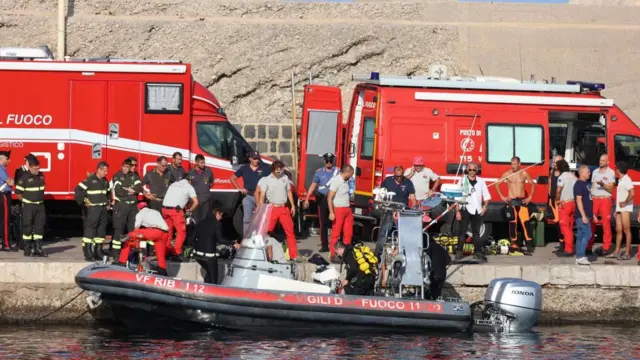
Search crews say their efforts to recover the six people still not accounted for after a yacht sank off the coast of Sicily on Monday will "continue without stopping".
As the second day of that operation comes to close, here's what we have learned:
- Friends of Recaldo Thomas , the chef believed to have died in the sinking, have begun to pay tribute to his "smile that lit up a room"
- Three more survivors have been named as Leo Eppel and South African nationals Leah Randall and Katja Chicken - all members of crew that were on board the ship when it sank
- Six people still remain unaccounted for: Mike Lynch, his 18-year-old daughter Hannah , Jonathan Bloomer and his wife Judy, and Chris Morvillo and his wife Neda
- Divers have been able to reach the lounge of the yacht but their path to the cabins has been blocked by "a world of objects"
- The Italian coastguard says that specialist divers are "evaluating the feasibility of safely entering the wreck", but warn the search is being complicated by its " depth and the position of the hull" around 50m (164ft) below the surface
- Jonathan Bloomer's twin brother has told the BBC his family are "coping the best we can" as they wait for updates from the rescue team's ongoing efforts
We're going to pause our coverage now but you can read more about the second day of the Bayesian search operation here .
This page was edited by Emily Atkinson, Owen Amos and Sean Seddon and was written by Sophie Abdulla, Adam Durbin, Gabriela Pomeroy, Matt Spivey, Barbara Tasch, Jacqueline Howard, Rachel Flynn and Johanna Chisholm.
Who are the six people still missing? published at 20:19 British Summer Time 20 August 20:19 BST 20 August

Technology tycoon Mike Lynch is still missing alongside his 18-year-old daughter
Six people remain unaccounted for after a luxury yacht sank off the coast of Sicily, including a father and daughter, as well as two married couples.
UK businessman Mike Lynch, who helped establish Cambridge Neurodynamics and co-founded the firm Autonomy, is still missing alongside his daughter Hannah Lynch , an 18-year-old student.
Jonathan Bloomer , the chairman of Morgan Stanley Bank International, and his wife Judy Bloomer were also on the yacht when it sank and have not yet been found.
Chris Morvillo , a partner at the law firm Clifford Chance, and his wife Neda Morvillo, a jewellery designer, have also been confirmed as missing.
Earlier we reported that the body of a man recovered near the sunken Sicilian yacht is believed to be that of Recaldo Thomas , a Canadian-Antiguan chef who was working on the boat.
His friends have described him as having "a smile that lit up the room".
Couple missing from yacht are 'incredibly generous people', says reverend published at 20:07 British Summer Time 20 August 20:07 BST 20 August
Jonathan and Judy Bloomer - who are still missing following the sinking of the Bayesian yacht - are “incredibly generous people”, the reverend of their local church says.
Speaking to BBC South East, Rev Tim Edwards, from Knockholt in Kent, says “at the moment there’s an awful lot that we don’t know”.
He describes the couple as being “very much” part of the village community and active with local charities.
What are waterspouts? published at 19:52 British Summer Time 20 August 19:52 BST 20 August
According to vessel tracking app Vesselfinder, the Bayesian left the Sicilian port of Milazzo on 14 August and was last tracked east of Palermo on Sunday evening, with a navigation status of "at anchor".
Witnesses later described seeing a waterspout form during a storm that hit in the area overnight, and - as mentioned in our last post - it is believed to have struck the yacht before it sank.
Most are familiar with what tornadoes look like - they are rotating columns of destructive winds, protruding from the base of clouds down to the ground. According to BBC Weather, waterspouts are just that too, but they form over water rather than land.
Instead of dust and debris swirling around the core of strong winds, it is water mist whipped up from the surface.
Like tornadoes, most are only short-lived, narrow columns and are not easily picked out on weather radars, so many will go unreported.

How could the yacht have sunk? published at 19:39 British Summer Time 20 August 19:39 BST 20 August
It is believed the Bayesian was struck by a tornado over the water - otherwise known as a waterspout - causing the luxury yacht to capsize and sink to the seabed.
There are separate reports the boat's mast snapped during the freak storm, while other factors in the boat's tipping over could include water entering through hatches and doors which might have been left open because of warm weather off the Italian coast.
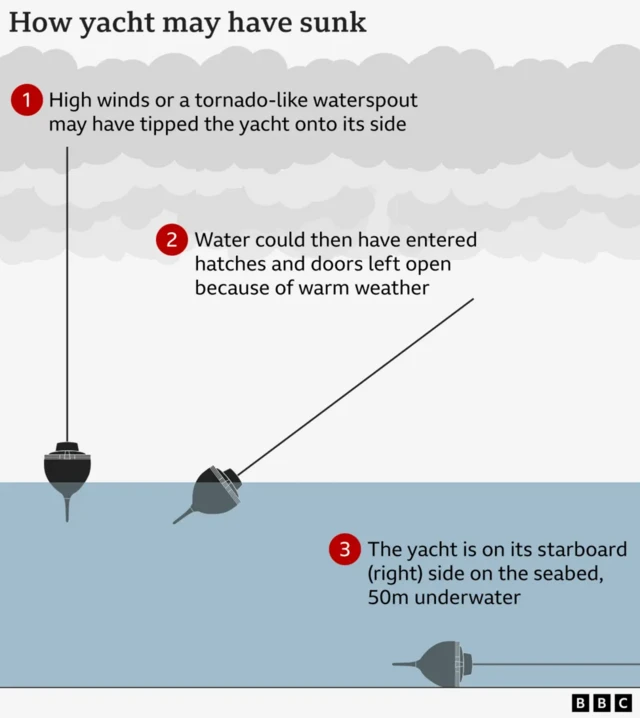
'Easy to talk to with a sense of humour' - friend describes Mike Lynch published at 19:27 British Summer Time 20 August 19:27 BST 20 August
Another one of Mike Lynch's friends has been telling the BBC a bit more about their neighbour's personality.
"He is so approachable and a very easy person to talk to," Richard Smith, who lives in the Suffolk village of Pettistree, says. "A nice sense of humour."
"You might think with all that money that he would be a difficult person to talk to, but in fact he was a very easy person to talk to."
Mike Lynch's neighbour 'horrified' to learn he's missing published at 19:08 British Summer Time 20 August 19:08 BST 20 August

One of Mike Lynch's neighbours says she was "horrified" to find out he was missing and describes it as the "worst news".
"I just couldn't believe it, I thought this can't be right," Ruth Leigh, of Pettistree in Suffolk, says.
Leigh says they have lived near each other for around 15 years and describes Lynch as a "fantastic neighbour" and a "very charitable man".
"Even though he was incredibly wealthy and a very important person he never ever gave that impression.
"Whenever he met you he always remembers your name, he would chat to you - incredibly friendly and down to earth, which we thought was a great quality," she adds.
Did the yacht’s keel play a role in it sinking? published at 18:46 British Summer Time 20 August 18:46 BST 20 August
By Tom Edgington
There has been speculation about the type of keel on the Bayesian and whether it may have been a factor in it sinking.
The website for Perini Navi – the yacht’s builder – is currently not available. However, by searching internet archives BBC Verify has obtained the boat’s 2018 brochure.
In the “features and performance” section, the document gives dimensions for the keel in an "up" position - 4.05m (13ft) - and in a "down" position - 9.83m (32ft) - suggesting it is retractable.
The BBC has contacted Perini Navi but has not had a reply.
A keel is a support structure underneath the boat which projects downwards and helps keep it balanced on the surface.
Certain boats might require a retractable keel in order to enter shallow water without getting stuck.
We don’t know if the Bayesian’s keel was up or down at the time it was struck by a storm.
However, Andrew Fairbrass who runs a large yacht engineering business says “when you're sailing, you have to keep the keel down and it does make a big difference to stability”.
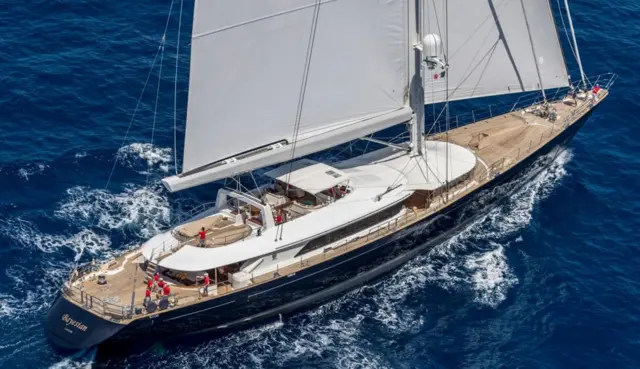
Name of surviving crew member confirmed by coastguard published at 18:24 British Summer Time 20 August 18:24 BST 20 August Breaking
The Italian coastguard has confirmed the name of another crew member who survived the sinking of the Bayesian.
Leo Eppel was on board the yacht when it capsized, spokesman Vincenzo Zagarola says.
Two other surviving crew members were named by authorities a short while ago .
The BBC understands that Recaldo Thomas, who worked as a chef on the boat, was killed and his body has been recovered.
You can read tributes to the Canadian-Antiguan national here .
British investigators arrive but hopes for miracle vanish published at 18:08 British Summer Time 20 August 18:08 BST 20 August

In cloudy skies and on choppy waters, the search has gone on all day, a helicopter scouring the site where the Bayesian capsized as divers plunged deep below.
They’re trying to access the wreckage of the yacht that was hit by a tornado-like waterspout, and is now 50m (164ft) underwater.
Given the depth, each dive can only be 10 minutes, and with the boat still largely intact it’s hard to get access inside.
British investigators are now here to assess what happened during the extreme weather that hit the Bayesian.
Severe heat and violent storms had prompted a weather alert before the yacht went down.
Tonight the search goes on - but any hope of a Mediterranean miracle survival has all but vanished.
'It's still wait and see,' says twin brother of missing man published at 17:50 British Summer Time 20 August 17:50 BST 20 August

Morgan Stanley International bank chairman Jonathan Bloomer
Jonathan Bloomer's twin brother has told the BBC his family are "coping the best we can" as rescue workers continue to search for him off the coast of Sicily.
The banker is one of six people still missing since the Bayesian yacht capsized.
Jeremy Bloomer tells the BBC he has not received any new updates on the search efforts to find Jonathan, beyond that divers are struggling to access the wreck of the boat.
He says: "It's a slow process and it will take time. So there might be air pockets, but we don't know."
Jeremy continues: "He was my older [brother] by half an hour. So it means a lot when you lose a twin brother. It's still wait and see, so fingers crossed."
Asked how he was coping, he says the situation is "terrible" and something that's "beyond your wildest imagination".
Quote Message I'm just numb, just numb. That's it, you don't know what to think and you can't believe it's happened."
Two members of crew named as survivors of yacht sinking published at 17:39 British Summer Time 20 August 17:39 BST 20 August
We've just heard from the Italian coastguard, which has named two more survivors of the yacht sinking.
South African nationals Leah Randall and Katja Chicken, who worked as crew members on the Bayesian, managed to get to safety after the vessel sank in the early hours of Monday morning.
In total , 15 of the 22 people on board have been rescued . Among them are:
- Mike Lynch's wife, Angela Bacares
- Charlotte Golunski, her husband James and their one-year-old daughter
- Ayla Ronald, who worked as a lawyer for Mike Lynch, and her partner
How Mike Lynch's courtroom joy led to yacht tragedy published at 17:24 British Summer Time 20 August 17:24 BST 20 August

Twelve people were vacationing on Mike Lynch 's yacht, alongside 10 crew members, when it sank in a storm off the coast of Sicily. The gathering was reportedly a celebration.
Earlier this year, Lynch was cleared of fraud and conspiracy charges arising from the sale of his firm Autonomy to US tech giant Hewlett Packard. The decade-long legal battle had led to Lynch's extradition from the UK.
Upon being cleared of the charges in June, the British entrepreneur said he was "elated" and thanked his legal team for their "tireless work". Some of them were on the yacht alongside him when it sank.
Chris Morvillo , a lawyer for Clifford Chance - the law firm that represented Lynch - is among the six people still missing. So is his wife Neda Morvillo , an American jewellery designer.
Ayla Ronald, a senior associate at the same law firm, also worked on Lynch's case. Both she and her partner were invited to the yacht and were rescued when it sank.
Morgan Stanley International chairman Jonathan Bloomer - who appeared as a defence witness for Lynch during his trial - and his wife Judy Bloomer were on the boat when disaster struck. Both are unaccounted for.
Charlotte Golunski, the board director of Luminance - an artificial intelligence platform founded by Lynch - was on board, along with her husband and one-year-old daughter. All three survived.
Lynch's wife Angela Bacares and daughter Hannah were also there. Bacares has been rescued but 18-year-old Hannah is still missing.
In pictures: Search operation at wreck site continues published at 17:03 British Summer Time 20 August 17:03 BST 20 August
A search and rescue operation, which includes boats scouring the surface of the sea and divers examining the wreck of the Bayesian yacht on the seabed, is still ongoing.
As we've been reporting, the specialist diving team have been struggling to access the cabins on the wreck - which is around 50m below the surface - because of debris blocking access.

'A smile that lit up the room': Tributes to chef killed in yacht sinking published at 16:52 British Summer Time 20 August 16:52 BST 20 August

The body of a man recovered near the Bayesian yacht is believed to be that of Recaldo Thomas, a Canadian-Antiguan chef who was working on the boat.
His friends have been paying tribute to him. Gareth Williams, who lives in Antigua, knew Thomas for 30 years.
"I can talk for everyone that knew him when I say he was a well-loved, kind human being with a calm spirit," he told me.
The two grew up together in Antigua, where Recaldo spent his time during off-season.
"He would come over to mine over the weekend and he would sing. He had the deepest, most sultry voice in the world, and a smile that lit up the room.
"He told me just the other day that he needed to work two more seasons to fix up his late parents' house. He loved yachting, but he was tired."
Eli Fuller met Recaldo some 25 years ago while out socialising in Antigua.
"He knew everybody and was friends with everybody. He'd always ask how you were doing, how your family was - he was always positive.
"Personality was very important in his job. The world's richest people want to hang out with someone social. He was sought after."
He added that Thomas became an inspiration to young black children who wanted to get into yachting.
"The kids would see all these white people working on yachts. For them to see an Antiguan man travelling all over the world - it was important for our community."
Search efforts complicated by wreck's position underwater, coastguard says published at 16:42 British Summer Time 20 August 16:42 BST 20 August Breaking
The search for the missing six passengers "continues without stopping" but divers have not found anything, the Italian coastguard says.
The coastguard says that specialist divers are "evaluating the feasibility of safely entering the wreck", but that the search is being "complicated by the depth and the position of the hull lying on the seabed" - at 50m below the surface.
It adds there is no trace of "hydrocarbon pollution" - meaning oil or other similar fuel is not leaking from the wreck.
Why is the search and recovery operation for the Bayesian so complex? published at 16:28 British Summer Time 20 August 16:28 BST 20 August
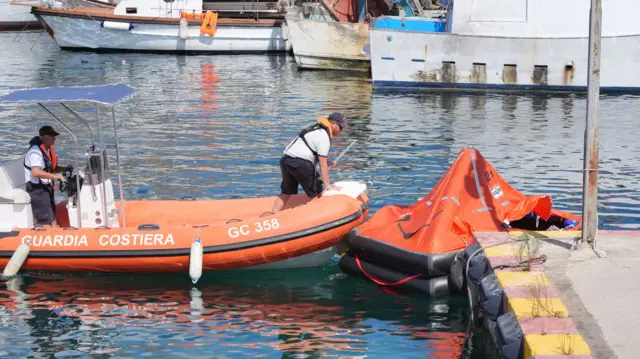
We're well into the second day of search and rescue operations for the six people still missing after the sinking of a luxury yacht off the coast of Sicily.
Here are some of the factors which make this a highly complex process:
- The wreckage is currently 50m (165ft) below the surface of the water
- Furniture and a "world of objects" are blocking access to the cabins of the yacht, hampering the divers' access
- Divers can only spend 12 minutes below the surface of the water, meaning by the time they reach the Bayesian, they only have 10 minutes to search the wreck
- The bridge of the yacht - the room where the captain controls the vessel - is full of electrical cables
- Divers are unable to see inside the yacht , though a possible entry point could be through a 3cm (1.2in)-thick glass window
- Specialist divers who are trained to work in small spaces have had to be flown in from Rome and Sardinia
Ex-MP John Gummer on his 'wonderfully kind' friend Lynch published at 16:10 British Summer Time 20 August 16:10 BST 20 August
Helen Burchell Live reporter

Lord Deben says his friend Mike Lynch is "wonderfully kind and companionable"
Lord Deben, former Conservative MP John Gummer, describes his missing friend Mike Lynch as "a wonderfully kind and companionable" man.
"He is the kind of person who carries this enormously clever mind, but carries it so lightly, and is always interested in what others have to say and might contribute," he says in a statement.
"It is a very serious moment... for if we have lost him, we’ve lost a very wonderful man."
He adds: "It is one of the cruellest blows that could possibly be made if it turns out that he hasn’t survived because he had so much to give, and he was giving it.
"This is a man of outstanding ability, but also the sort of person whom we were all very, very fortunate to know."
Water conditions could have led to waterspout, says oceanographer published at 15:54 British Summer Time 20 August 15:54 BST 20 August

Dr Simon Boxall is a senior lecturer at Southampton University
Dr Simon Boxall, an oceanographer from the University of Southampton, says "there's a lot still to be discovered" about what led to the sinking of the Bayesian.
Asked about reports the boat may have been hit by a waterspout , he tells the BBC they are "not normally dangerous" but that would depend on the intensity of the weather system.
Boxall says: "What's interesting is that we saw very light winds up until the time at which the yacht was hit.
"And then suddenly, the wind went from about three or four miles an hour to 30 or 40 miles an hour, and then dropped again. And that was on land.
"So it's a sort of precursor to there being a major sort of squall or even a waterspout that would have hit the ship."
The ocean to the north of Sicily is more than three degrees warmer than it should be at this time of year, he adds, creating a "perfect storm" for waterspouts to occur.
'Yacht sank in two minutes,' captain of nearby ship says published at 15:41 British Summer Time 20 August 15:41 BST 20 August

The captain of the Dutch-flagged ship that rescued Bayesian passengers from the water before emergency services arrived has spoken again to Reuters.
Captain Karsten Borner has previously explained how he worked to keep his ship upright during the storm, before noticing the luxury yacht that had been behind his vessel had disappeared.
"I don't absolutely know what they did. I only know that they went flat with a mast on the water and that they sank in two minutes," Borner says.
He says the sea temperature, which meteorologists have told us was at an extreme high of 30C, is "way too hot for the Mediterranean, and this causes, for sure, heavy storms".
Advertisement
Supported by
Lynch Yacht Sinking Off Sicily Proves as Baffling as It Is Tragic
As bodies were recovered, the authorities and experts wondered how a $40 million, stable and secure vessel could have sunk so quickly.
- Share full article

By Emma Bubola and Michael J. de la Merced
Emma Bubola reported from Porticello, Italy, and Michael J. de la Merced from London.
Two months after being cleared in a bruising legal battle over fraud charges, the British tech mogul Mike Lynch celebrated his freedom with a cruise. He invited his family, friends and part of his legal team on board his luxury sailing yacht, a majestic 180-foot vessel named Bayesian after the mathematical theorem around which he had built his empire.
On Sunday night, after a tour of the Gulf of Naples, including Capri, and volcanic islands in the Eolian archipelago, the boat anchored half a mile off the Sicilian coast in Porticello, Italy. It chose a stretch of water favored by the Phoenicians thousands of years ago for its protection from the mistral wind and, in more recent times, by the yachts of tech billionaires. The boat was lit “like a Christmas tree,” local residents said, standing out against the full moon.
But about 4 a.m., calamity unfolded. A violent and fast storm hit the area with some of the strongest winds locals said they had ever felt. Fabio Cefalù, a fisherman, said he saw a flare pierce the darkness shortly after 4.
Minutes later, the yacht was underwater. Only dozens of cushions from the boat’s deck and a gigantic radar from its mast floated on the surface of the sea, fishermen said.
In all, 22 people were on board, 15 of whom were rescued. Six bodies — five passengers and the ship’s cook — had been recovered by Thursday afternoon, including that of Mr. Lynch, an Italian government official said, adding that the search was continuing for his daughter.
It was a tragic and mystifying turn of events for Mr. Lynch, 59, who had spent years seeking to clear his name and was finally inaugurating a new chapter in his life. Experts wondered how a $40 million yacht, so robust and stable could have been sunk by a storm near a port within minutes.
“It drives me insane,” said Giovanni Costantino, the chief executive of the Italian Sea Group, which in 2022 bought the company, Perini, that made the Bayesian. “Following all the proper procedures, that boat is unsinkable.”
The aura of misfortune only deepened when it emerged that Stephen Chamberlain, 52, a former vice president of finance for Mr. Lynch’s former company and a co-defendant in the fraud case, was killed two days earlier, when he was hit by a car while jogging near his house in England.
Since June, the two men had been in a jubilant mood. A jury in San Francisco had acquitted both on fraud charges that could have sent them to prison for two decades. There were hugs and tears, and they and their legal teams went for a celebratory dinner party at a restaurant in the city, said Gary S. Lincenberg, a lawyer for Mr. Chamberlain.
The sea excursion was meant as a thank-you by Mr. Lynch to those who had helped him in his legal travails. Among the guests was Christopher J. Morvillo, 59, a scion of a prominent New York family of lawyers who had represented Mr. Lynch for 12 years. He and his wife, Neda, 57, were among the missing.
So, too, was Jonathan Bloomer, 70, a veteran British insurance executive who chaired Morgan Stanley International and the insurer Hiscox.
The body of the ship’s cook, Recaldo Thomas, was recovered. All the other crew members survived. Among them was Leo Eppel, 19, of South Africa, who was on his first yacht voyage working as a deck steward, said a friend, who asked not to be identified.
Since the sinking, the recovery effort and investigation have turned the tiny port town of Porticello, a quiet enclave where older men sit bare-chested on balconies, into what feels like the set of a movie.
Helicopters have flown overhead. Ambulances have sped by with the sirens blaring. The Coast Guard has patrolled the waters off shore, within sight of a cordoned-off dock that had been turned into an emergency headquarters.
On Wednesday afternoon, a church bell tolled after the first body bag was loaded into an ambulance, a crowd watching in silence.
The survivors were sheltering in a sprawling resort near Porticello, with a view of the shipwreck spot, and had so far declined to comment.
Attilio Di Diodato, director of the Italian Air Force’s Center for Aerospace Meteorology and Climatology, said that the yacht had most likely been hit by a fierce “down burst” — when air generated within a thunderstorm descends rapidly — or by a waterspout , similar to a tornado over water.
He added that his agency had put out rough-sea warnings the previous evening, alerting sailors about storms and strong winds. Locals said the winds “felt like an earthquake.”
Mr. Costantino, the boat executive, said the yacht had been specifically designed for having a tall mast — the second-tallest aluminum mast in the world. He said the Bayesian was an extremely safe and secure boat that could list even to 75 degrees without capsizing.
But he said that if some of the hatches on the side and in the stern, or some of the deck doors, had been open, the boat could have taken on water and sunk. Standard procedure in such storms, he said, is to switch on the engine, lift the anchor and turn the boat into the wind, lowering the keel for extra stability, closing doors and gathering the guests in the main hall inside the deck.

12 guests occupied the yacht’s six cabins. There were also 10 crew members.
Open hatches, doors and cabin windows could have let in water during a storm, according to the manufacturer.

Open hatches, doors and
cabin windows could
have let in water
during a storm,
according to the
manufacturer.
Source: Superyacht Times, YachtCharterFleet, MarineTraffic
By Veronica Penney
The New York Times attempted to reach the captain, James Cutfield, who had survived, for comment through social media, his brother and the management company of the yacht (which did not hire the crew), but did not make contact.
So far none of the surviving crew members have made a public statement about what happened that night.
Fabio Genco, the director of Palermo’s emergency services, who treated some of the survivors, said that the victims had recounted feeling as if the boat was being lifted, then suddenly dropped, with objects from the cabins falling on them.
The Italian Coast Guard said it had deployed a remotely operated vehicle that can prowl underwater for up to seven hours at a depth of more than 980 feet and record videos and images that they hoped would help them reconstruct the dynamics of the sinking. Such devices were used during the search and rescue operations of the Titan vessel that is believed to have imploded last summer near the wreckage of the Titanic.
After rescuers broke inside the yacht, they struggled to navigate the ropes and many pieces of furniture cluttering the vessel, said Luca Cari, a spokesman for Italy’s national firefighter corps.
Finally, as of Thursday morning, they had managed to retrieve all but one of the missing bodies, and hopes of finding the missing person alive were thin. “Can a human being be underwater for two days?” Mr. Cari asked.
What was certain was that Mr. Lynch’s death was yet another cruel twist of fate for a man who had spent years seeking to clear his name.
He earned a fortune in technology and was nicknamed Britain’s Bill Gates. But for more than a decade, he had been treated as anything but a respected tech leader.
He was accused by Hewlett-Packard, the American technological pioneer that had bought his software company, Autonomy, for $11 billion, of misleading it about his company’s worth. (Hewlett-Packard wrote down the value of the transaction by about $8.8 billion, and critics called it one of the worst deals of all time .) He had been increasingly shunned by the British establishment that he sought to break into after growing up working-class outside London.
He was extradited to San Francisco to face criminal charges, and confined to house arrest and 24-hour surveillance on his dime. In a townhouse in the Pacific Heights neighborhood — with security people he jokingly told associates were his “roommates” — he spent his mornings talking with researchers whom he funded personally on new applications for artificial intelligence. Afterward, he devoted hours to discussing legal strategy with his team.
Despite his persistent claims of innocence, even those close to Mr. Lynch had believed his odds of victory were slim. Autonomy’s chief financial officer, Sushovan Hussain, was convicted in 2018 of similar fraud charges and spent five years in prison.
During Mr. Lynch’s house arrest, his brother and mother died. His wife, Angela Bacares, frequently flew over from England, and she became a constant presence in the San Francisco courtroom during the trial.
After he was finally acquitted, Mr. Lynch had his eye on the future. “I am looking forward to returning to the U.K. and getting back to what I love most: my family and innovating in my field,” he said.
Elisabetta Povoledo contributed reporting from Pallanza, Italy.
Emma Bubola is a Times reporter based in Rome. More about Emma Bubola
Michael J. de la Merced has covered global business and finance news for The Times since 2006. More about Michael J. de la Merced
- Skip to main content
- Keyboard shortcuts for audio player
An American researcher drowns after a Viking replica ship sinks off Norway's coast
Rachel Treisman

This photo released by the Norwegian Police shows the Viking ship replica, called Naddodd, moored at the quay in Måløy, Norway, on Wednesday, after it capsized earlier this week off Norway's coast. Norwegian Police via AP hide caption
A historic journey ended in tragedy this week when a Viking replica ship capsized off the coast of Norway, killing an American archaeologist who was part of its international crew.
The six-person team had been piloting the open wooden ship, named Naddodd, on a roughly 1,000-mile trip from the Faroe Islands to Trondheim, Norway.

Italian prosecutors open a manslaughter investigation into yacht sinking off Sicily
"This expedition, honoring the Viking navigator Naddodd, aims to preserve Viking culture and navigational skills for future generations," Sail2North expeditions, which organized the voyage, said in an Instagram post in May.
The team — made up of four Swiss, one Faroese and one American — departed on Saturday from Suðuroy, the southernmost of the 18 Faroe Islands, for what was expected to be a several-day journey.
But on Tuesday evening, met with stronger-than-expected winds and high waves, it capsized off the Norwegian coastal town of Stad.
The Norwegian Joint Rescue Coordination Centre (JRCC) told CNN that the boat sent out a distress signal at around 5:45 p.m. local time, but when rescuers arrived, crew members signaled that they were safe.
They issued another distress call around 8 p.m. local time, at which point local civilian boats got to the scene and saw the ship had capsized. Five members of the crew managed to board an inflatable life raft and were airlifted to safety within an hour, the JRCC said, but one person was trapped beneath the boat.
Emergency responders battled tough conditions, including 40-knot winds and 16-foot waves, according to a video posted to social media by Norway’s Sea Rescue Society.
#Redningsskøyta «Idar Ulstein» er på nå på stedet hvor vikingskipet har kantret vest av #Stad . Vi holder øye med skipet, og gjør det vi kan for å bistå med bergingen, men værforholdene gjør det svært krevende. pic.twitter.com/iLUUeo6Qoz — Redningsselskapet (@NSSR) August 27, 2024
The following morning, once conditions improved, rescuers found a body beneath the capsized boat.
On Friday, Sail2North identified the victim as 29-year-old Karla Dana, whom it had previously described as "the youngest member of our crew and embodies both the curiosity of a field researcher and the boldness of an adventurer."
Dana, an archaeologist and field researcher, had worked in a number of countries, from Costa Rica to Germany to Morocco to Taiwan, according to her LinkedIn page. She was a member of the prestigious Explorers Club , and was pursuing a master's degree in archaeology at the University of the Highlands and Islands in Scotland.
In a joint statement shared with Sail2North, Dana's sister and her fiancé said she "tackled every adventure with a smile on her face and a twinkle in her eye."
"She always made life look easy," Alejandra Dana and Grant McDaniel wrote. "She created a light that illuminated everyone around her everywhere she went. If you ever had the opportunity to know her, consider yourself one of the luckiest people on this planet."
Dana had shared on LinkedIn earlier this year that she was looking forward to participating in the Viking expedition.
"Thrilled to be a part of this crew, fearlessly embarking on this Nordic voyage on a Viking ship replica across the North Sea, pushing through physical and mental limits to sail into history," Dana wrote.
Dana also authored several posts for the expedition's blog, which is now password-protected.
"It's hard to keep excitement from turning into fear when you see those waves casually tossing around huge modern boats like toys," she wrote in a post published Wednesday, according to the BBC . "But there's a wild beauty in the North Sea, a reminder of nature's raw power, and I feel incredibly lucky to be part of this adventure."

Research News
Researchers pinpoint when the vikings came to canada. it was exactly 1,000 years ago.
Authorities believe a strong wave was likely responsible for the capsizing, which they are viewing as a "tragic accident" rather than a criminal matter, according to the Associated Press .
Sail2North said on Friday that its crew was made up of "highly experienced explorers who undertook extensive training" and "took every precaution to ensure their safety."
The other crew members include the 56-year-old captain and expedition leader , a 54-year-old artist and seaman who holds a Guinness World Record for rowing across two oceans in the same year, a 37-year-old extreme sports aficionado , a 41-year-old photographer and a 50-year-old engineer .
"Despite their diligent efforts and adherence to these measures, the outcome was unforeseen and deeply upsetting," it said, adding it is committed to supporting Dana's family and honoring her legacy.
A spokesperson with a public relations firm representing the organization told NPR over email that the rest of the crew is traveling home to be with their families and "continues to receive support from a dedicated care team." It anticipates providing further updates next week.

IMAGES
VIDEO
COMMENTS
The cat was 9 m long, and the owner had modified the boat by adding keels. The study consists of a data set of over 120 incidents reported, of which only 33 are catamarans showing that catamaran capsizing is something very uncommon. The reason for a catamaran sailboat capsizes; 28% Gust of wind. 28% Wind.
☞ SUPPORT JOYRIDER TV⛵️Channel Membership https://www.youtube.com/channel/UC1lH...⛵️Patreon https://www.patreon.com/joseph_bennett ⛵️Getting a T-shirt ...
Summary. A catamaran's stability is attributed to its center of gravity, its freeboard, and its pendulum-like behavior. However, despite its stability and speed, a catamaran can still capsize due to strong winds and capsizing waves. There are factors that can contribute to the likelihood of a capsize happening, such as wind speed, wave height ...
Catamaran Sailing Techniques Part 7: should the worst happen - with Nigel Irens. Capsize is very unlikely in most modern catamarans, but should the worst happen it is as well to be prepared ...
Kickstarter https://www.kickstarter.com/projects/elcanoandplukky/the-elcano-challengePart 1 of this series go check it outhttps://youtu.be/OjbLv_ucT9QTo cont...
Short answer catamaran capsize: A catamaran capsize refers to the overturning or tipping over of a catamaran, a type of multihull boat with two parallel hulls. This can occur due to various factors such as strong winds, improper handling, or technical failures. Capsize prevention measures like proper training, ballasting systems, and stability considerations are crucial
First off, any boat can technically capsize. Even if it is designed not to, any boat which travels on the surface of the water has the potential to capsize given the right conditions. Second, we see one thing about catamarans is true and that is the larger the catamaran, the more stable. To sum up, any boat can capsize but the larger the ...
To sail a catamaran upwind, maintain high speeds, center the mainsheet, limit angles to 45-60°, lose unnecessary weight, upgrade to Kevlar sails and daggerboards. To sail a catamaran downwind, maintain 160-170°, use asymmetrical spinnakers, reef when winds exceed 15 knots, and jibe. Downwind gusts can help a catamaran surf down waves ...
To bring the boat upright again would require about half the energy needed to capsize the yacht in the first place, Lacey calculated. "Since the initial capsize may have been caused by a once-in-a-lifetime freak wave, one could be waiting a long time for a wave big enough to overcome this inverted stability," he commented. Autissier's ...
If your small catamaran capsizes, it is advisable to start the recovery process immediately before the situation worsens. Let's look at how to right a capsized catamaran. Why and how often do catamarans capsize, a scientific approach! You can right most small catamarans by pushing the bow or stern below the water to rotate them upright.
October 23, 2023 / 4:14 PM EDT / CBS News. The U.S Coast Guard rescued four Canadians after their catamaran capsized about 140 miles southeast of Wilmington, North Carolina, officials said. At 12: ...
Catamaran capsize. When a catamaran capsizes, the crew need good technique in order to pull it up. This may include righting from a pitchpole or from total inversion. GOING OVER. A catamaran can capsize by being blown over sideways, or by driving the leeward bow into the water and "pitchpoling" (nosediving), as shown here.
Seawise University capsized after being gutted by fire in 1972. Capsizing or keeling over occurs when a boat or ship is rolled on its side or further by wave action, instability or wind force beyond the angle of positive static stability or it is upside down in the water. The act of recovering a vessel from a capsize is called righting.Capsize may result from broaching, knockdown, loss of ...
☞ SUPPORT JOYRIDER TV⛵️Channel Membership https://www.youtube.com/channel/UC1lH...⛵️Patreon https://www.patreon.com/joseph_bennett ⛵️Getting a T-shirt ...
Well-designed modern catamarans are very hard to capsize though. Having said all that, most catamarans can do 200 to 250 miles a day and with modern technology allowing one to pull down weather at will, there is no good reason why you should get caught in extreme weather. A faster boat is a safer boat as it will in many cases be able to outrun ...
The partially-capsized 122-foot yacht Lovebug sits with its starboard side down in the water. Photo: Jodi Scheffler . PHOTOS: Five Rescued from Capsized Superyacht in West River. By Bay Bulletin / July 27, 2024 . Share: It was a shocking sight to many on the Bay over the weekend: a 122-foot-long yacht, laying on its side in a high-traffic part ...
The Bayesian is owned by a firm linked to Lynch's wife, Angela Bacares, who was one of the 15 people rescued Monday after it capsized. Divers of the Vigili del Fuoco, the Italian Corps of ...
How to righting a turtled catamaranCapsizing and righting a catamaran is part of the basic skills every Cat sailor needs to have. Wind and waves, a leaking ...
Trevor Hardman, from Tour Boat Annapolis, was on a friend's boat nearby when he saw the Lovebug, a 122-foot yacht, as it began to sink just after 12:30 p.m. Saturday, and he got closer to help ...
Stunning vision shows the crew of a US F50 catamaran being thrown through the air after their vessel capsized during the pre-race in Bermuda. ... The F50 capsized during the third and final ...
James Cutfield, 51, was the head of crew aboard the 56-meter (184-foot) sailing boat when it capsized in the throes of a ferocious storm last Monday, killing six passengers, including British ...
'It was a big disaster,' boater says of storm that capsized luxury yacht. 10 days ago. Duration 0:47. Karsten Borner, who was captain of a boat that was out in the same storm off Palermo, Sicily ...
Several bodies recovered from wreckage of sunken yacht off Sicilian coast 01:35. Divers searching the wreck of a superyacht owned by the family of a British tech mogul that sank Monday off the ...
Efforts to salvage the LoveBug, the 103-foot yacht that overturned and partially sank at the mouth of the West River in late July, are expected to conclude this week. Donjon Marine Co., the New ...
The yacht capsized on Monday at about 5am (03:00 GMT) after it was hit by stormy weather caused by a "waterspout" - or mini tornado - according to Italian authorities.
Phil Berman talks about capsizing catamarans and answers the question "Can a Catamaran Capsize?"
The banker is one of six people still missing since the Bayesian yacht capsized. Jeremy Bloomer tells the BBC he has not received any new updates on the search efforts to find Jonathan, beyond ...
Mr. Costantino, the boat executive, said the yacht had been specifically designed for having a tall mast — the second-tallest aluminum mast in the world. He said the Bayesian was an extremely ...
THIS IS THE WAY - WORKS PERFECTLYIf you're not heavy enough to bring your catamaran, whether it's a Hobie, Nacra, Prindle or Topcat or anything else, upright...
A Viking replica ship capsized several days into its journey from the Faroe Islands to Norway. Five crew members survived, but researcher Karla Dana, 29, drowned. She was the lone American on board.